




























There’s a joke that if you have three Jews in a room, you’ll end up with four different opinions on one topic. Many of us have lots to say, and some people have very strong opinions about things.
Before I became editor, someone with experience in this industry gave me advice. They told me that knowing what not to say is just as important – perhaps even more important – than knowing what to say. The person told me that any time I really want to print something that I’m passionate about, I should take a step back and ask myself if this topic or issue belongs in a Torah-oriented paper in which thousands of people may be reading those words. I’ve utilized this guidance many times throughout the years, and at times, I have held back from printing certain things because of this suggestion. And I have never regretted those unspoken words.
President Abraham Lincoln famously had a drawer where he would keep all the letters that he didn’t mail. During the Civil War, when he would hear about an unwise decision by a general, he would write a scathing letter to that general. Having a sharp tongue, those letters were well-written critiques of a particular general’s mistake. But then, after writing the letter, he would put it in the drawer instead of sending it. This way, he knew that he got his feelings off his chest but didn’t hurt his general out in the field.
In the Three Weeks, we often think about ways that we can practice ahavas Yisroel to draw the geulah closer. We come up with ideas and plans about how we can help people or start saying nicer things to others. But sometimes, in certain situations, the most thoughtful thing we can do for another is to not say anything.
This week, a relative of ours, Rabbi Shalom Weingot of Baltimore, passed away. Rabbi Weingot was a youthful, vibrant, and passionate person who loved each person and felt a genuine closeness to his Creator. At the levaya this week, his mechutan Rav Moshe Weinberger and the other speakers all spoke so eloquently spoke about his purity, his ahavas Yisroel, and his limud haTorah and expressed how it is hard to en-
capsulate in words what type of neshama he was. Perhaps the reason words are not adequate to describe Rabbi Weingot’s exalted life was because, despite the many thousands of beautiful words of Torah, chizuk and niggunim that he uttered in his life and that touched myriad people in such an impactful way, it was what he did not say that really defines him on a deeper level.
Despite numerous challenges, Rabbi Weingot was not one to complain. He saw every encounter as a direct message from the One Above. His ability to see straight to a person’s neshama, bypassing any externalities, ensured that he had no need to say lashon hara; each person was entirely pure and good, a creation of Hashem. By feeling Hashem’s closeness in every situation, Rabbi Weingot was incapable of seeing anything other than perfection in His plan. Gam zu l’tovah was a constant refrain in his life.
At the levaya, one of the sons said that a few people had come in from New York to attend the funeral. He had wondered who these people were; after all, he had never heard of them before that day. But they told him that they had met Rabbi Weingot a few times when he had come to shul on his visits to New York. Those few encounters had formed a deep bond, and they felt compelled to travel many hours to say goodbye to someone whom they considered a close friend. Rabbi Weingot, with his trademark style, had connected with them soul to soul.
Speaking negatively comes from seeing the undesirable traits in a person or in a situation. But if we can bypass those negativities and see only the goodness in each person, we can connect with each person in a real, true way – no barriers or hangups or pettiness holding us back from loving our fellow Jew.
Over the next week, as we hope against hope that Moshiach will come to turn Tisha B’Av into a day of joy instead of mourning, let us strive to remove the negativity from our lives and focus on the good in every person and situation that comes our way.
Wishing you a wonderful week, Shoshana
Yitzy Halpern, PUBLISHER publisher@fivetownsjewishhome.com
Yosef Feinerman, MANAGING EDITOR ads@fivetownsjewishhome.com
Shoshana Soroka, EDITOR editor@fivetownsjewishhome.com
Nate Davis
Editorial Assistant
Nechama Wein
Copy Editor
Rachel Bergida
Shana Brecher
Lani White
Design & Production

Gabe Solomon
Distribution & Logistics
P.O. BOX 266
Lawrence, NY 11559
Phone | 516-734-0858
Fax | 516-734-0857
Classified Deadline: Monday 5:00PM classifieds@fivetownsjewishhome.com

text 443-929-4003
PAYMENT VIA CREDIT CARD MUST BE SUBMITTED ALONG WITH CLASSIFIED ADS
The Jewish Home is an independent weekly magazine. Opinions expressed by writers are not necessarily the opinions of the publisher or editor. The Jewish Home is not responsible for typographical errors, or for the kashrus of any product or business advertised within. The Jewish Home contains words of Torah. Please treat accordingly.
Friday, July 21 Parshas Devarim
Candle Lighting: 8:02 pm
Shabbos Ends: 9:08 pm
Rabbeinu Tam: 9:32 pm

I am writing this letter in response to “Debbie Downer” about Visiting Day. I was very taken aback by her strident tone. I do not run a camp or am involved with any camp, and yes, I spend my summers in the city and shlepped to the country for Visiting Day many times. Why did we go? There are 2 important reasons:
1. For me. I put so much kochos, energy, time, tefillos into my children’s upbringing, don’t I at least want to see where/with whom they are spending the summer? Making a connection with their counselors can only help my child. (In terms of tips – which is a whole separate discussion – camps expect you to send them in even if you don’t come up, so it really has no bearing on this discussion.) But even more so,
2. For my child. It is so, so important to a child that what is important to them is important to us. And their life is important to them! So therefore, it must become important to me! My child wants me to see where he “lives,” who his bunkmates and counselors are, etc. We live in very confusing and difficult times. At the end of the day, when he feels that he is important to us and we care more about him than traffic, that is what holds him tight and close. Yes, it’s a long drive. Yes, it’s a lot of hours in the car. Is that not worth it? To show our children how important they are to us???
We can think out of the box to find solutions. A car pillow may work wonders for your back (along with Advil). I am eternally grateful to the stranger who suggested that instead of taking our kid to the pizza shop, we bring along a disposable grill, hotdogs, etc. and find a park or somewhere nice to spend the day. We
have such nice memories of those times. We go and come early in order to beat some of the traffic.
I was also disappointed by your comment “summer is the camp’s turn” to care for your child. I’m sorry, but your child is YOURS. Yes, you may “feel I do enough for my children” but even when someone else is “watching” them, you are still the parent. It’s a job that BH hopefully doesn’t end.
This is not about guilt. This is about something so much deeper and more basic than that.
Wishing you the best in figuring it all out, Miri
Dear Editor, Reading
The Jewish Home is a joy on my Shabbos morning. I appreciate that your articles are informative and that you don’t talk down to the reader.

Your article on the border between Israel and Egypt this week was fascinating. Thank you for a good read and for making me more knowledgeable about so many issues and topics.
A Reader

Dear Editor,
I would like to raise awareness about an important issue. I was checking out a Jewish business on Google Maps and I noticed the reviews. There were many reviews from Yidden, a lot positive, but some really negative ones as well. I decided to check out some more Yiddishe businesses and once again saw a whole bunch of negative reviews written by obviously frum people. Some of the reviews were extremely biting and can really harm the owners parnassah. One sharp Continued on page 10

Continued from page 8 review written in frustration about how the waitress was extremely rude, the service inexcusably slow, the portions way too small, the prices way too high, or the food being soggy and tasting terrible and you will never come back and would not recommend this restaurant to anyone can totally negate a whole bunch of positive reviews in a consumer’s mind and send him somewhere else.
I asked a prominent Rav if it’s muttar to leave a bad review, and he responded that it’s the worst form of lashon hara. I think that it’s generally just a lack of awareness about the issur and the irreparable damage that the business incurs that allows people to leave these reviews. To put it into context, I would say imagine you had a bad experience in a store and were so upset that you decided to stand right outside the store every day with a big sign proclaiming to the world that this is the worst store ever and everyone should stay away. Everyone understands that no matter how right you are and how wrong the store is, such behavior would be beyond the pale. A review online is pretty much the same thing. It is there to stay and is extremely harmful. (Please be advised that one can remove his negative reviews from Google Maps.)
All are asked to spread this message
and save the storeowners from tremendous harm, and just as importantly, save people from the terrible issur of lashon hara.
Dear Editor,
I always enjoy reading your editor’s notes. You offer wonderful insights into our community. This week, I especially appreciated the “small town vibe” that you noted we have.
Recently, I saw a photo that someone posted of a note that was left on someone’s windshield in Cedarhurst. The note said that a person had seen that this car’s meter had run out and that they had put a quarter in the meter for them. It then told the driver to pass along the chessed and to do that for someone else.
I love it! Isn’t that what we should all be about? Thinking of others and doing for others? It’s a small gesture that says a lot. It says you care for your fellow Jew –whether you know them or not!
Let’s keep this going in our “small town.” Let’s keep the goodness flowing, especially during this time, the Nine Days.


Sincerely, Rachel
B.
tive, from one extension to another.”

He noted, “Prices for grain all across the world will go up, and people in the most vulnerable regions of Asia, Africa, will feel it.”
Ukraine is a major supplier of grain to the World Food Programme (WFP). According to the European Commission, Ukraine accounts for 10% of the world wheat market, 15% of the corn market, and 13% of the barley market. It is also a key global player in the market of sunflower oil. The Food and Agriculture Organization (FAO), an UN body, warned at the time that as many as 47 million people could be pushed into “acute food insecurity” because of the war.
On Monday, Russia said it was suspending its participation in a crucial deal that allowed the export of Ukrainian grain. The agreement had been brokered by Turkey and the United Nations last summer and was set to expire on Monday evening.
Kremlin spokesperson Dmitry Peskov told reporters on Monday that Russia would not renew the pact right now, saying it “has been terminated.”
The deal had allowed Ukraine to export grain by sea, with ships bypassing a Russian blockade of the country’s Black Sea ports and navigating safe passage through the waterway to Turkey’s Bosphorus Strait in order to reach global markets.
Vessels were inspected before they arrived in Ukraine by Russian, Ukrainian and Turkish officials, to ensure weapons were not being smuggled into Ukraine.
Russia has for some time complained that it is being prevented from adequately exporting its own foodstuffs, and Peskov cited that objection as the reason for pulling out of the deal.
“As soon as the Russian part is completed, the Russian side will return to the implementation of this deal immediately,” he told reporters.
Over the weekend, Russian President Vladimir Putin said that the main objective of the deal – supplying grain to countries in need – “has not been realized.”
Last week, U.S. Secretary of State Antony Blinken accused Russia of using the grain deal “as a weapon.”
Ukrainian Foreign Minister Dmytro Kuleba said on Monday that “Russia has been slowly killing the grain initia -

Since its implementation, the Black Sea Grain Initiative has allowed for the export of nearly 33 million metric tons of foodstuffs from Ukraine. The World Food Programme has shipped more than 725,000 tons to support humanitarian operations – helping to relieve hunger in some of the hardest hit corners of the world, including Afghanistan, Ethiopia, Kenya, Somalia, Sudan and Yemen.
In withdrawing from the pact, the Russian Foreign Ministry said that its government was removing guarantees for safe navigation in the Black Sea.
There are alternative routes for Ukrainian grain and oilseed exports by rail through eastern Europe, but they can’t readily cope with the volume that Ukraine wants to export.
“This is another attempt by Russia to weaponize hunger and destabilize the global food market,” Ukrainian President Volodymyr Zelensky said in a post on his Telegram page.
On Thursday, the UN’s International Court of Justice, also known as the World Court, made a decision on a case in which Nicaragua sued Colombia for more territory in the Caribbean Sea, the body of water which separates the two countries. When suing Colombia, Nicaragua argued that its underwater continental shelf goes


beyond its current maritime border, and thus the country should be allowed to extend its boundaries.
“Irrespective of any scientific and technical considerations, Nicaragua is not entitled to an extended continental shelf within 200 nautical miles from the baselines of Colombia’s mainland coast,” Judge Joan Donoghue, the president of the World Court, ruled.
In response, the government of Nicaragua accepted the court’s decision, calling it “firm, definitive and mandatory.”
Carlos José Argüello Gómez, the Nicaraguan Ambassador to the Netherlands, said that his country will still continue to investigate the ruling “because it has consequences in a very large and complicated area,” but acknowledged that regardless, “whatever the court said, Nicaragua will comply with it.”
Gustavo Petro, the president of Colombia, praised the ruling, declaring the decision as “a great victory for Colombia.”
“With this ruling we hope to close the border dispute and focus on bringing sustainable development to our archipelago,” Petro added.
In 2012, the International Court of Justice set a new border between the two countries, giving Nicaragua more access to underwater gas deposits and oil
reserves and permission to fish in more areas. Although in the same ruling the Court gave Colombia a few small islands, the Colombian government was upset about the decision and refused to accept it at the time.
tion, the Military Demarcation Line into the Democratic People’s Republic of Korea (DPRK). We believe he is currently in DPRK custody and are working with our KPA counterparts to resolve this incident,” the UNC said.
The Joint Security Area is located inside the Demilitarized Zone between South and North Korea. Tours of the area are open to the public and organized by the United Nations Command.

The Demilitarized Zone between North and South Korea has become one of the most heavily fortified borders in the world, ringed by miles of barbed wire and landmines and patrolled by soldiers from both sides for decades. The Joint Security Area is a very different area.
of floor space, which would mean it has surpassed the Pentagon as the world’s largest office building.
It took four years of construction to put this mammoth space together. It is expected to be officially opened in November by Indian Prime Minister Narendra Modi, who was born in Gujarat and previously served as the state’s chief minister.
The giant building contains marble floors and light-filled atriums connecting over 4,700 office spaces, which can also double as small workshops for cutting and polishing diamonds. The 32-billion-rupee ($388 million) development also houses 131 elevators, as well as dining, retail, wellness and conference facilities for workers.
A U.S. national is believed to be in North Korean custody after crossing the border during a tour.
The man is believed to be a U.S. soldier, a U.S. official said. He was detained during a Joint Security Area tour after crossing the Military Demarcation Line separating North and South Korea, the United Nations Command said in a tweet.
“A U.S. National on a JSA orientation tour crossed, without authoriza -

While there are a series of checkpoints that must be passed to get to the JSA, crossing the Military Demarcation Line that is the actual border between North and South Korea does not require passing any physical barrier. There is only a small raised line on the ground that marks the border and stepping across it requires only one step, as former U.S. President Donald Trump did in 2018 when he met North Korean leader Kim Jong Un in the JSA in 2019.
During a JSA tour, participants are kept about 20 yards or so from the line. Guards are not always near the line.
According to the project’s CEO, Mahesh Gadhavi, Surat Diamond Bourse will save thousands of people from traveling — sometimes daily — to Mumbai by train to do business.
Despite its size, no office takes longer than seven minutes to reach from any of the building’s entry gates. A lottery system was used to decide which businesses were given which offices.
India is home to 1.428 billion people. One of its biggest industries is diamond cutting. Now, the country can boast that it will have the world’s largest office building, housing 65,000 diamond professionals.
The building in Surat is billed as a “one-stop destination” for over 65,000 diamond professionals, including cutters, polishers and traders. Featuring a succession of nine rectangular structures spilling out from — and interconnected via — a central “spine,” the sprawling 15-story complex has been built across more than 35 acres of land.
The trading center’s architects say it comprises over 7.1 million square feet

Predawn explosions hit the only bridge linking the occupied Crimean Peninsula to mainland Russia on Monday, damaging a vital symbol of President Vladimir Putin’s claims to sovereignty over Ukrainian territory and briefly disrupting a major supply line to Russian troops.
The blasts were the second time the Kerch Strait Bridge has been hit in 10 months. And although these inflicted far less damage than an explosives-laden truck that blew up in October, they exposed the vulnerability of the bridge — and other Russian supply routes far from the front — as Ukraine wages a grueling counteroffensive to retake land.
Russia on Monday accused Ukraine of using maritime drones to assault the bridge, a strategic link for Russian forces fighting in southern Ukraine. Ukrainian


16 officials celebrated the attack, but neither claimed nor denied responsibility for the blasts.
Hours after the attack, Moscow announced that it was pulling out of the Black Sea grain deal, an agreement that had allowed Ukraine to export its grain by sea despite Moscow’s naval blockade. Kremlin spokesperson Dmitry Peskov said the bridge attack was not related to Russia’s decision to suspend its participation in the deal.
Rail service over the bridge resumed Monday morning. But damage to the car lanes, which appeared to have left part of the road tilting, according to video verified by The New York Times, threatened to constrict Russian logistical operations.
If the bridge were destroyed or severely damaged, Moscow would be left with a single major land route from Russia, along the southern coast of Ukraine, to support tens of thousands of soldiers fighting to hold onto territory captured in the first weeks of its invasion.
Putin condemned the explosions as “another terrorist attack perpetrated by the Kyiv regime.” He said the Ministry of Defense was preparing Russia’s response and that Russia’s main security service, the FSB, would investigate.
One bridge segment was destroyed,
and another was dislocated by more than 30 inches, according to Marat Khusnullin, a Russian deputy prime minister. But the main support pillars remained intact, which Putin called “good news.”
Khusnullin said limited vehicle traffic might resume as soon as Tuesday.
Pro-war Russian military bloggers and commentators described the attack, which officials said killed two people and injured a third, as evidence of another failure by the Russian military command.
(© The New York Times)
Ten months ago, Mahsa Amini died after being arrested by the force for wearing her hijab incorrectly, triggering nationwide protests.
Saeid Montazeralmahdi, spokesman for Iran’s enforcement body, Faraja, said police will restart vehicle and foot patrols across the country from Sunday.
Officers will first warn women who are not complying, while those who “insist on breaking the norms” may face legal action, he said.
Amini’s death sparked nationwide protests that rocked the country, posing one of the biggest domestic threats to Iran’s ruling clerical regime in more than a decade. Authorities responded violently to suppress the months-long movement, during which witnesses said the morality police had virtually disappeared from the streets of Tehran.
The morality police have access to power, arms and detention centers and have control over “re-education centers,” Human Rights Watch said last year. The group is sanctioned by the United States and the European Union.

modesty. Inside the facilities, detainees are given classes about Islam and the importance of the hijab and are forced to sign a pledge to abide by the state’s clothing regulations before they are released.
On Sunday, state media reported that Iran’s morality police will resume patrols to make women comply with strict Islamic dress codes.

The centers act like detention facilities, where women – and sometimes men – are taken into custody for failing to comply with the state’s rules on
At least 33 people died in South Korea after days of torrential rain caused landslides and flash flooding. On Sunday, rescue workers pulled seven bodies from vehicles trapped in a flooded underpass in central South Korea.
A large-scale search and rescue operation involving 400 workers and divers was launched Saturday after 15 vehicles, including a public bus, became trapped by rising flood waters in the




Gungpyeong tunnel, the chief of local fire department Seo Jeong-il said.
The deluge gushed through the tunnel when a levee of the nearby Miho river in North Chungcheong province failed, trapping the vehicles and those inside.
Dashcam footage from one vehicle that made it through the tunnel shows water rushing into the underpass as cars drive into the flood waters.
Rescue teams continued to drain the tunnel of flood water Sunday morning, pumping out 80,000 liters per minute. At 4:33 a.m., the top of the bus became visible, Seo said. But authorities said the chance of finding any more survivors is unlikely. At least ten people are still considered missing.
“We are mobilizing about 30 divers in groups of two in rotation for the search operation,” said Seo. “We are trying our best right now, although it is difficult since the site is covered in mud.”
Dozens of people have died in South Korea in recent days as torrential monsoon rains triggered flooding and landslides across the country.
Across the country, more than 5,500 people have been forced to evacuate their homes and seek temporary
shelter, the Ministry of the Interior and Safety said Sunday. In addition, some 8,300 households in four provinces are experiencing power outages, Yonhap News Agency reported.
Public roads, houses and farm fields have been damaged by the severe flooding.
The latest round of heavy rains in South Korea come just days after devastating floods wreaked havoc in neighboring Japan, killing at least six people and injuring 19. Flash floods have torn through southwest China in recent weeks, killing at least 15 people in the city of Chongqing.
to burn a Torah and a Christian Bible in front of the country’s Israeli embassy on July 15. The northern European country has been heavily criticized for granting the man permission to do so.
Police approved Alush’s request to hold a protest on Saturday in front of the Israeli embassy, where he said he would burn the Torah and Christian books in response to the burning of a Quran near a Swedish mosque this past June.
However, when the man arrived in front of the embassy, the only book he held was the Quran. According to reports, Alush dropped a lighter to the ground and exclaimed that he had no use for it.
“It is against the Quran to burn, and I will not burn. No one should do that,” Alush said, explaining that he never intended to burn the Torah or Christian texts, but only wanted to protest against an Iraqi immigrant who had burned a bacon-stuffed Quran last month.
“I want to show that freedom of expression has limits that must be taken into account.
ago ended in a crash and a crater. Chandrayaan-3 is taking place amid renewed interest in exploring the moon. The United States and China are both aiming to send astronauts there in the coming years, and a half dozen robotic missions from Russia, Japan and the United States could head there this year and next.
Swedish officials permitted Ahmad Alush, a thirty-two-year-old Muslim man,
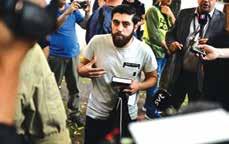
“I want to show that we have to respect each other – we live in the same society. If I burn the Torah, another the Bible, another the Quran, there will be war here. What I wanted to show is that it’s not right to do it,” Alush added.
U.S. diplomat Deborah Lipstadt said that the U.S. is “deeply concerned” about the burning that Sweden approved.
“While the United States supports freedom of expression and the right to peaceful assembly as elements of democracy as well as supporting the right to freedom of religion or belief for all, such acts will create an environment of fear,” Lipstadt said. “This will impact the ability of Jews and members of other religious minority groups from freely exercising their right to freedom of religion or belief in Sweden.”
Amidst these events, Swedish officials have assured Israel that they are working towards criminalizing the burning of holy books. However, they added that it will be a long time before such a rule can be put into law.
India is on its way back to the moon after a rocket lifted off from Sriharikota, a launch site off the country’s East coast, on Friday afternoon local time.
The mission, Chandrayaan-3, is largely a do-over after the country’s first attempt at putting a robotic spacecraft on the surface of the moon nearly four years
If the robotic lander and rover aboard Chandrayaan-3 succeed in landing intact, that will be an accomplishment that no country other than China has pulled off this century, adding to the national pride India takes in its homegrown space program. A cadre of commercial space startups is also popping up in India.
Last month, India reached an agreement with the United States to send a joint mission to the International Space Station next year. The Indian Space Research Organization — India’s equivalent of NASA — is also developing its own spacecraft to take astronauts to orbit.
On Friday, at 2:35 p.m. local time (5:05 a.m. Eastern time), a rocket called Launch Vehicle Mark III lifted off from the Indian space base on an island north of the metropolis of Chennai.
As crowds waving Indian flags and colorful umbrellas cheered, the rocket rose into the sky. Sixteen minutes later, the spacecraft separated from the rocket’s upper stage, and a round of cheering and clapping erupted in the mission control center.

“It is indeed a moment of glory for India,” Jitendra Singh, the minister of state for India’s Ministry of Science of Technology, said in remarks after the launch, “and a moment of destiny for all of us over here at Sriharikota who are part of the history in the making.” (© The New York Times)
On Thursday, Israeli Defense Minister Yoav Gallant made an official visit to


22 Azerbaijan, where he met and spoke to the country’s president, Illham Aliyev, in Baku, the country’s capital.

During Gallant’s meeting with Aliyev, the two went over various topics pertaining to the region and current events and discussed how Israel and Azerbaijan can work together and grow their partnership in order to tackle issues that face both nations.
over the past few years, Israel and its allies have foiled over fifty terrorist plots planned by Iran.
“In recent years, Iran has been leading a worldwide terror campaign, with unprecedented scope, targeting Israelis and Jews around the world,” the defense minister said.
“There have been more than 50 attempted attacks in recent years. Most of them were ready to go and were foiled at the last moment,” Gallant added, thanking Israel’s defense establishment and the allies who assisted in the counter-terrorist measures.
continue regular monitoring.”
The Prime Minister, who is seventy-three, released a video that evening saying that he feels “very good.” Bibi’s wife, Sara, and his son Avner stayed with him at the medical center.
President Isaac Herzog, Yair Lapid, and others wished Bibi a complete and speedy recovery.

“Prime Minister Netanyahu is a fighter,” tweeted U.S. House Speaker Kevin McCarthy. “Please join me in praying for him and for Israel.”
“Minister Gallant expressed his appreciation to the President for his leadership and personal commitment to deepening the bond between their countries, starting with the opening of the Azerbaijani embassy in Israel,” read the defense minister office’s statement. “The discussion built on the previous meeting held between the leaders this year, within the framework of the Munich Security Conference.”
Later that day, Gallant spoke to reporters in Azerbaijan, and noted how
In recent times, Israel’s and Azerbaijan’s relationship has flourished. A Baku embassy opened in Israel last March, and in May, Israel’s president, Isaac Herzog, visited Azerbaijan.
This relationship is fueled by the fact that Israel and Azerbaijan benefit each other. From 2016 to 2020, 69% of Baku’s arms imports came from Israel. Israel also helped Azerbaijan win a war against Armenia in 2020 by supplying more weapons to the country. Additionally, Azerbaijan’s geographic proximity to Iran is very helpful to Israel in its shadow war against the Islamic state.

More than 30% of Israel’s oil is supplied by Azerbaijan.
On Friday, Prime Minister Benjamin Netanyahu went on a trip to the Sea of Galilee. Due to extreme heat, and the fact that he went on his trip without water or a hat, the Prime Minister became dizzy and lightheaded the following day.
On Saturday, Netanyahu was rushed to the Sheba Medical Center, where the doctors determined that the incident was caused by dehydration. While the hospital said that his heart “is completely normal” with no signs of heart arrhythmia, the PM’s team decided to implant a subcutaneous Holter – a medical device used to monitor a patient’s heart – “as is customary” in order to “allow the close medical professional team of the prime minister to
Netanyahu responded to McCarthy, tweeting, “I am feeling fine and ready to hit the ground running to continue strengthening the unbreakable bond between our two nations. Looking forward to see you again soon.”
Former vice president Mike Pence joined McCarthy in his wishes for Netanyahu’s good health and recovery, tweeting: “Praying for a swift recovery for my Friend and a Great Friend of America, Prime Minister Benjamin Netanyahu. G-d Bless Netanyahu.”
Currently, the PM has no replacement, as his former deputy prime minister, Aryeh Deri, was fired due to past bribery convictions.
As the Palestinian gunman rode through a West Bank highway, the terrorist fired shots from his M-16 assault rifle, hitting three Israelis driving in a car. One of the victims is in serious condition now, while the other two have minor injuries.
The attack happened on the morning of Sunday, July 16, near Tekoa, an Israeli settlement.

The victims are a thirty-five-year-old father, Elroi Kapach, who is in stable condition but has been seriously injured, as well as his daughters, Rachel and Avigayil.
His daughters, ages 9 and 14, were mildly wounded from window glass shattered by the terrorist’s shots. All three victims were taken to Jerusalem to the Shaare Zedek Hospital.
The terrorist was then pursued and caught by the Israel Defense Forces and has been identified as Amar al-Najjar. Two other suspects were arrested in Bethlehem in connection with the attack. The gun and car used for the attack were taken by the IDF.
Amar al-Najjar, 26, has been incarcerated in Israel before. He is a member of Hamas, a group which is considered a terrorist organization by Israel and other countries.
“As we proved today, any time it’s necessary, we will prove… every terrorist will pay a heavy price,” Gallant tweeted, praising the IDF for apprehending the suspects. “We will chase after and reach our enemies.”
Gallant added that he wishes Kapach and his daughters a quick recovery.

Conflict in the West Bank has escalated since 2022, as Israel and Palestinians have been clashing over evictions, rockets, and settlements, with many deaths and injuries as a result. The UN and human rights groups have accused both sides of wrongdoing and urge a peaceful solution.
This week, Morocco announced that Israel had informed Rabat of its decision to recognize its sovereignty over the contested Western Sahara region.
A statement from the Moroccan Foreign Ministry said that King Mohammed VI received a letter from Prime Minister Benjamin Netanyahu affirming Israel’s move to “recognize the sovereignty of Morocco over the territory of Western Sahara.”

Rabat also said that Netanyahu’s letter noted Israel is “positively examining” opening a consulate in Dakhla, the regional capital. Netanyahu also wrote that the move will be “reflected in all relevant acts and documents of the Israeli government.”
The ministry added that the prime minister’s letter noted that the decision would be “transmitted to the United Nations, to regional and international organizations of which Israel is a member, and to all countries with which Israel maintains diplomatic relations.”
Foreign Minister Eli Cohen on Monday welcomed the move, saying in a statement that it would “strengthen the relations between the countries and between the nations, as well as the continuation of cooperation to deepen peace and regional stability.”
Ties between Israel and Morocco have been shaky in recent months. Rabat and Jerusalem are still working to fully cement relations since announcing the normalizing of ties in 2020 under the Abraham Accords. As part of that deal, brokered by the Trump administration, the U.S. recognized Morocco’s unilateral annexation of Western Sahara. Despite pressure, the Biden administration has not reversed U.S. recognition of the disputed territory.
Last month, Morocco postponed a meeting of Israel and its Arab allies that it had been due to host this summer, in response to spiraling violence in the West Bank. Foreign Minister Nasser Bourita
24 said at the time that he hoped the meeting could still go ahead at a later date when circumstances were more “favorable.”
On Monday, the IDF appointed its first-ever military attaché to Morocco, as security ties between the countries expand.
The Western Sahara dispute dates back to 1975, when colonial ruler Spain withdrew from the territory, sparking a 15-year war between Morocco and the Polisario Front movement seeking independence in the territory.
Rabat controls nearly 80 percent of the Western Sahara and sees the entire territory, home to abundant phosphates and fisheries, as its sovereign territory.
Speaking at a Knesset Foreign Affairs and Defense Committee meeting on Tuesday morning, military chief Lt. Gen. Herzi Halevi said calls by reservists to refuse to serve in protest of the government’s plans to overhaul the judicial system cause harm to the Israel Defense Forces.
“Anyone who calls for not showing up
[for duty] harms the IDF and harms the security of the state,” IDF Chief of Staff Halevi said.
“Our goal these days is to combine competence and cohesion” in the military, Halevi added.

planned changes to the judiciary.
On Monday night, 160 reservists of the elite Yahalom combat engineering unit added their names to the growing list of reservists, announcing their intention to suspend their volunteer reserve duty, according to the Ynet news site.
“In the various arenas, both far and near, the IDF is required to be vigilant and ready to strengthen deterrence. The current security challenges require us to be highly prepared in terms of competence and cohesion, even when there is tension between them. The goal is to keep them together,” he said.
In recent weeks, protests against the judicial overhaul have rippled through the IDF, with reservists from dozens of units joining in threats to cease their voluntary service. According to a list published on Sunday, nearly 4,000 reservists have signed letters threatening to not show up for voluntary duty in protest of the

At a ceremony last week, Halevi said reservists “don’t have the right” to refuse to show up for duty. On Friday, Halevi reportedly told reservists during a drill that “those who call to not show up for reserves as a protest are directly harming the IDF. If we don’t train today, the competence of the army will suffer, and when it is necessary to activate you, we will be less prepared.”
Yisrael Beytenu party leader MK Avigdor Liberman said Tuesday that Halevi should resign if he is unable to keep up the military’s competence.
“The chief of staff’s role always was to provide security and maintain the IDF’s competence. In today’s circumstances, this is impossible. Therefore, the chief of staff must resign, he has no other choice,” Liberman said at a conference hosted by the Calcalist financial daily.
“We are allowed to disagree, we are allowed to debate and discuss, we are allowed to protest, but we are not allowed to harm, in the name of one political opinion or another, the IDF,” Defense Minister Yoav Gallant said last Tuesday, during an event commemorating 75 years since the sailing of the immigrant ship Exodus.
“As someone who spent most of his adult years in command of troops from all segments of Israeli society, and as someone who knows the current [security] situation, I can say clearly that in the effort to protect the security of the state and in the face of the threats facing us, we need all the soldiers and all the commanders,” Gallant said.
“Just as the company commander and the battalion commander need all the soldiers in the company and battalion, so do I, as the defense minister of Israel, need the entire IDF, the entire Shin Bet, the entire Mossad, all the people they have, from all parts of the public, in order to succeed in the complex mission of protecting the State of Israel and the lives of its citizens,” he continued.
Gallant said the military must be kept “united” and not allow “extreme statements from any side” to harm the IDF.
The military has said that it would discipline or potentially dismiss active-duty soldiers who refuse to show up for duty when ordered to but stressed that no action would be taken against reservists who only threaten not to show up.
Last Wednesday, the California State Board of Education unanimously voted in favor of the new 2023 Mathematics Framework for California Public Schools. The new framework will significantly change the way K-12 students are taught math in California and will put an emphasis on social justice and “anti-racism,” according to a 1,000-page document which details the upcoming system.
The document also noted that instead of teaching abstract math concepts, the curriculum will focus more on relevant, concrete matters. The framework additionally seeks to “instill confidence in learners by dispelling myths about who can and cannot learn math” and will hopefully allow “students to ‘see themselves’ in curriculum and in math-related careers by making math instruction culturally relevant and empowering,” the document says.
“Cultural and personal relevance is important for learning and also for creating mathematical communities that reflect California’s diversity. Educators can learn to notice, utilize, and value students’ identities, assets, and cultural resources to support learning for all students. Additionally, because culture and language can be intertwined, attending to cultural relevance may also enable teachers to attend to linguistic diversity – a key feature of California and relevant to the teaching and learning of mathematics,” the document adds.
In April 2021, the state tried to implement similar changes, but those plans were pushed off until now due to criticism at the time.
According to the 2021 version of the framework, one of its goals was to discourage the notion of objectivity in math, instead, teaching the students that mathematics can be subjective and opinionated.


“The concept of mathematics being purely objective is unequivocally false, and teaching it is even much less so,” part of the 2021 document read. “Upholding the idea that there are always right and wrong answers perpetuate objectivity as well as fear of open conflict.”
In reaction to the attempted overhaul in 2021, hundreds of math and science professors signed a letter, openly criticizing the proposal.
“Subjecting the children of our largest
state to such an experiment is the height of irresponsibility,” the professors wrote.
Republican House Representatives of the state had similar concerns at the time.
“Imposing a one-size-fits-all model on the students of California will instead stifle creativity, free thinking, and innovation,” a group of GOP Reps, including Kevin McCarthy and Young Kim, wrote two years ago in a letter to Linda Darling-Hammond, the president of the State Board of Education.

Edward Caban, who grew up in the Bronx as the son of a Puerto Rican transit police detective, on Monday became the first Latino officer to lead the New York Police Department in its 177-year history.

Mayor Eric Adams announced the appointment of Caban, who had been serv-
ing as acting commissioner, in a morning news conference in front of the 40th Precinct in the South Bronx, where Caban began his career as a police officer in 1991.
The move came just over a month after Commissioner Keechant Sewell, the first woman to serve in the role, resigned after only 18 months, frustrated in her attempts to act with autonomy, according to people with knowledge of her experiences.
Caban previously served as first deputy commissioner. He will oversee roughly 36,000 officers and 19,000 civilian employees.
“This is an amazing moment not only for the Spanish-speaking community –this is an amazing moment for the entire city and country,” Adams said to a crowd of police officers and city leaders who chanted, “Eddie, Eddie, Eddie.”
Caban, whose rise from the precinct to headquarters was punctuated by run-ins with departmental oversight agencies, is taking over the nation’s largest police department at a critical juncture.
Morale has improved following successful contract negotiations with the city, but union leaders say the department is still losing officers to early retirement or other agencies, with officers feeling overworked or disheartened in the wake of protests decrying police brutality.
Shootings in New York City dropped about 25% through the first half of this year compared with the same period last year, but suburbanites and many New Yorkers say they remain anxious they will be victims of crime on the street or subways.
At the same time, some New York officials say the department is leaning too heavily on aggressive tactics in an effort to control crime.
On Monday, Adams credited Caban with helping his predecessor preside over the department as shootings and homicides dropped, a decrease that reflected a national trend.
Adams also praised Sewell, saying Caban had “a tough act to follow.”
“I am humbled to be on your team,” Caban said to the mayor. “To have your trust and support and to lead the greatest department on the globe.”
Caban pledged to continue to keep

crime low and to prioritize department morale. (© The New York Times)
physical evidence, the investigation will not be able to single out a person of interest from the hundreds of individuals who passed through the vestibule where the cocaine was discovered.”
According to reports, the locker which had the cocaine in it was not in the cameras’ view. Additionally, officials aren’t even sure when the bag was placed there.
The White House’s failure to prevent this from happening and the Secret Service’s inability to identify a suspect has been criticized by certain politicians.

Oversight and Accountability Committee that they have a list of five hundred individuals whom they suspect of the crime but would not drug test them, said GOP Rep. Marjorie Taylor Greene. GOP Rep. Nancy Mace added that the Secret Service could not access visitor logs and other relevant details until they received permission from the Biden administration, based on the Presidential Records Act, since the cocaine was spotted near the Situation Room which is in the Biden administration’s jurisdiction.
dispute, the Appellate Division of the State Supreme Court in Albany said that the competitive, court-drawn districts put in place for last year’s midterms had only been a temporary fix.

The U.S. Secret Service recently launched an investigation after a bag containing less than a gram of cocaine was found in the White House on July 2. But the case was hastily closed soon after when it was discovered that there was insufficient DNA evidence, making it impossible to determine who the owner of the drugs could be.
“There was no surveillance video footage found that provided investigative leads or any other means for investigators to identify who may have deposited the found substance in this area,” the Secret Service said in a statement. “Without
“Y’all have all been to the White House. You give your Social Security number, you get, I mean, I’m sure they have facial identification and everything else, and to say that they don’t know who it is, to me, somebody should lose their job over this, a lot of people,” Rep. Tim Burchett said. “Somebody walks in the White House, the most secure building in the United States of America – in the world, actually – and can place something in a locker. What if it was a biological entity?”
Former President Donald Trump expressed his doubt that the Secret Service doesn’t know who’s responsible for the drug’s placement, claiming that “they know everything.”
On Thursday, July 13, the government agency met with and informed the House
At the time of the drug’s discovery, the Secret Service ordered a brief evacuation of those in the area, due to what the agency called “precautionary closures.”

A New York appeals court on Thursday ordered the state’s congressional map to be redrawn, siding with Democrats in a case that could give the party a fresh chance to tilt one of the nation’s most contested House battlegrounds leftward.
Wading into a long-simmering legal
They ordered the state’s bipartisan redistricting commission to promptly restart a process that would effectively give the Democratic-dominated state Legislature final say over the contours of New York’s 26 House seats for the remainder of the decade.
“In granting this petition, we return the matter to its constitutional design. Accordingly, we direct the IRC to commence its duties forthwith,” Elizabeth A. Garry, the presiding justice, wrote in the majority opinion, referring to the Independent Redistricting Commission. (Two members of the five-judge panel dissented.)
Republicans vowed to appeal, leaving a final decision to the state’s highest

court, the Court of Appeals, just a year after it stopped an earlier attempt by Democrats to gerrymander the maps.
The current district lines were drawn by a neutral court-appointed expert last spring to maximize competition. The new map served that purpose, helping Republicans flip four seats en route to taking control of the House.
If Thursday’s ruling stands, both parties believe Democrats could conceivably draw maps that pass legal muster while making reelection almost impossible for incumbent Republicans — including Reps. Mike Lawler and Marc Molinaro in the Hudson Valley, as well as Anthony D’Esposito and George Santos on Long Island and in Queens, among others.
New Democratic seats in New York could help offset gains Republicans are expected to make in North Carolina, where a newly conservative top court is allowing the party to replace a more neutral map, and potentially in Ohio. Democrats also won an unexpected victory at the U.S. Supreme Court in June that could net the party a handful of seats in the South. (© The New York Times )
Scottsdale Water’s existing residential and commercial rebate programs that offer water saving options and maintain the beauty and functionality of Scottsdale’s neighborhoods,” the city’s council added.
Scottsdale, Arizona, has implemented a new ordinance which prohibits the use of natural grass in front of one-family homes built after August 15.
The decision, which was unanimously approved by the Scottsdale City Council, has been put into place in order to save water, a measure necessary due to the droughts that have been plaguing Arizona.
“By adopting this ordinance, Scottsdale aims to lead the way in water conservation practices, setting an example for other communities across the region,” the executive director of Scottsdale’s water department, Brian Biesemeyer, said.

“It’s a positive step that supports responsible use of our water resources and an initiative that works in tandem with

This isn’t Scottsdale’s first attempt to save water. In the recent past, approximately 657 million gallons of water have been conserved, according to the city council, ever since officials of the city requested that citizens reduce their water usage by 5% and the city government reduce its usage by 9% for its operations. In June, construction restrictions were implemented in Phoenix, also in an effort to conserve water.
In Phoenix, temperatures have been reaching 110°F every day in July thus far, and over the weekend, the Phoenix heat peaked at 117°F. In Scottsdale, temperatures reached 113°F on Saturday, and Tucson saw peak weekend temperatures of 108°F at around the same time.
According to the Arizona State Climate Office, many parts of Arizona have been experiencing a drought since 1994.
For the first time since 1960, both Hollywood actors and writers are on strike at the same time.
The main issue which prompted the Screen Actors Guild (SAG-AFTRA) to join writers in the walkout on Thursday, July 13 was actors’ concern about how studios will use artificial intelligence.
that it had given actors a “groundbreaking AI proposal” along with “historic” raises, but the actors instead chose “a path that will lead to financial hardship for countless thousands of people who depend on the industry.”
Before the strike started, the studios tricked the guild into two more weeks of negotiations, during which “they stayed behind closed doors, they kept canceling our meetings, wasting time,” said Drescher, adding that the studios likely just wanted to buy time in order to “promote their summer movies,” since if the strike would’ve started before then, the actors would not have been able to promote the newly released films.
The actors’ union hasn’t gone on strike since the 1980s. During that time, the walkout lasted over three months.

United Airlines pilots reached an agreement with the company on Saturday on a contract valued at $10 billion that would increase pay up to 40% over four years.
The proposed contract offers another big wage victory for pilots in the United States after a deal with Delta Air Lines was approved in March. The substantial raises are a reflection of a shortage of pilots in the United States and the strong recovery in demand for air travel.
“This is a moment of history, a moment of truth – if we don’t stand tall right now, we are all going to be in trouble,” asserted the guild’s president, Fran Drescher, at a press conference. “We are all going to be in jeopardy of being replaced by machines and big business.”
These worries come after recent proposals in which studios allegedly offered a single day’s pay to background actors in exchange for permission to scan and replicate their faces for use “in any project … with no consent and no [further] compensation,” said SAG-AFTRA’s chief negotiator, Duncan Crabtree-Ireland.
The Alliance of Motion Picture and Television Producers (AMPTP) had a different account of the situation, claiming
In addition to the higher compensation, the agreement provides better job security, work rules, vacation, retirement and other benefits.
At a major airline such as United, pilots easily earn six-figure salaries. The most senior pilots, who typically fly larger planes on international routes, can earn several hundred thousand dollars a year.

In a statement, United, which is based in Chicago, said the deal would help its “United Next” strategy, an expansion plan that includes the purchase of larger planes to increase the number of seats per flight in North America by almost 30% and the number of premium seats per flight by 75% by 2026.
Union officials said the agreement was the result of four years of negotiations and represented a “landmark” deal in the

32 airline industry as travel demand rises after the steep drop during the height of the pandemic.
“The tireless dedication demonstrated by United pilots over the past several years ensured our solidarity, which was instrumental in achieving this historic agreement,” Capt. Garth Thompson, chair of the United Master Executive Council of the Air Line Pilots Association International, said in a statement.
The Air Line Pilots Association, the largest airline pilot union in the world, represents 74,000 pilots at 42 airlines in the United States and Canada, including 16,000 pilots at United.
The union and management will now complete the final language of the deal. The agreement must then be approved by a vote of the members of the pilots association, which is expected in the next several weeks.
In March, Delta approved a contract that increases wages 34% by 2026 and includes improvements to scheduling, retirement and other benefits. Delta’s deal raised the standard for pilot compensation and benefits. (© The New York Times)
tims. And that is why I say that’s one of the worst, if not the worst.”
At the beginning of this year, investigators on the Gilgo Beach serial killings obtained a sample of the suspect’s DNA from pizza crust that Heuermann threw in the garbage. Based on DNA evidence, cell phone data, and credit card bills, the authorities identified the Long Island man as the serial killer.
Heuermann, who is fifty-nine, pleaded not guilty, and was reportedly in tears as he insisted that he is not responsible for the murders.

Rex Heuermann, a Long Island architect, has been charged with the murder of three women and is suspected of killing a fourth woman as well. These charges come after about thirteen years of investigations.
The victims, Melissa Barthelemy, Maureen Brainard-Barnes, Amber Lynn Costello and Megan Waterman, are called the “Gilgo Four” and were found dead near Gilgo Beach.
“The acts that (were) committed were the worst I’ve ever seen,” said Anthony Carter, Suffolk County’s Deputy Police Commissioner. “He’s a demon, and it’s really hard to get into the mind of somebody that’s capable of committing the crimes that he committed. This person intended to do what he did to these vic-
The task force that investigated the case included detectives from the DA’s Office, the FBI, the New York State and Suffolk County Police departments, and the Sheriff’s Department.
“There are still things that we have to do. There are still human remains that have to be investigated further in Gilgo,” Carter said. “I can’t begin to imagine the pain that these families have had to endure over the last decade and to know that this demon was capable of doing such an evil act to these families, it is just, you know, beyond comprehension.”
Carter added that over the next few days, it’s a possibility that more victims will be identified.
The personal information in the emails could be used to conduct targeted cyberattacks or to track the movements of Pentagon personnel – although there’s no evidence that happened in this case.
Johannes “Joost” Zuurbier, a Dutch internet entrepreneur, was the first person to raise awareness of this problem. He had received the emails because his company was contracted to manage the .ML domain. Since 2013, Zuurbier said, he has raised the issue with various U.S. officials, including the U.S. Embassy in Mali earlier this year.
Zuurbier’s contract to manage the .ML domain expired last week, he said, prompting him to raise awareness of the issue in the media.
The issue was first published in the Financial Times.

Deputy Pentagon Press Secretary Sabrina Singh says that the problem is not as big as it could be. None of the leaked emails were sent from official Department of Defense email addresses, but the department has blocked its email accounts from emailing .ML email addresses as a precaution.

She added that the “only thing that went through” were emails from personal accounts, like a Gmail or Yahoo account. The department strongly discourages using personal email accounts for official business, Singh said.
The misdirected emails have grown less frequent in recent years, but still come by the hundreds per day, Zuurbier said. Many of the emails are spam, but some are sensitive.

Over the past few years, millions of emails intended for employees at the Pentagon were instead sent to people in West Africa. The inadvertent mixup occurred because of the similarities between U.S. military email addresses, which end in “.MIL,” and those originating from Mali, which end in “.ML.”
The email snafu reveals the security risks to U.S. national security officials that can arise from an innocent typo.
More than 800,000 borrowers will have $39 billion in federal student loan Did
word “goodbye” is derived from the words “G-d be with ye.”


debt eliminated under a government effort to remedy years of mistakes by the loan servicers that collect payments on the government’s behalf.
Millions more people will have their loans adjusted as part of the program. That process will continue into next year.
The relief will go to those who have federal loans owned directly by the Education Department and who enrolled in income-driven repayment plans or would have qualified for loan forgiveness if they had done so. Those plans cap the payments that borrowers owe to a percentage of their income. Under those plans, borrowers must make payments for a term that is typically 20 or 25 years. At the end of that period, any remaining balance is forgiven.
More than 8 million people use income-driven repayment plans, but for decades, many of the companies that bill borrowers made extensive mistakes in tracking payments and in guiding borrowers through the payment process. Those errors put millions of borrowers further behind by years in their quest to pay off their loans.
“For far too long, borrowers fell through the cracks of a broken system,” Education Secretary Miguel Cardona said Friday.
The planned move was announced

two weeks after the Supreme Court struck down President Joe Biden’s plan to eliminate $400 billion in student loan debt for tens of millions of borrowers. The court ruled that the president lacked the authority to eliminate debts so broadly without explicit congressional authorization.
But the far smaller adjustment on Friday, which is separate and has not led to court challenges, falls more squarely within the education secretary’s power to administer loan repayment programs.
The debt elimination — which will happen in the next few weeks, the Education Department said — is part of a plan the Biden administration announced last year to address the problem of servicers’ mistakes. The department decided to automatically and retroactively credit millions of borrowers for late or partial payments and for long stretches spent in forbearance before the pandemic.
The 804,000 borrowers whose debts will be eliminated are those who, after the adjustments, have made the required 240 or 300 monthly payments (depending on their payment plan) to have their remaining debt forgiven.
Borrowers eligible for relief will not have to apply — their debts will be automatically discharged. (© The New York Times)
Sometimes, you just never know.
Last week, a pair of previously unknown and “exceptionally rare” portraits by Rembrandt sold for over $14.2 million after they were discovered in a private collection in the UK.

Depicting relatives of the Dutch master, the intimate paintings are the last Rembrandt portraits still in private hands, according to Christie’s auction house.
The winning bidder’s identity has not been revealed.
Signed and dated 1635, the eightinch-high pictures are of an elderly couple related to the painter by marriage: wealthy plumber Jan Willemsz van der Pluym and his wife Jaapgen Carels, who were from a prominent family in the Dutch city of Leiden. Their son was married to Rembrandt’s cousin.
The paintings have a pretty straightforward lineage. They had stayed in the sitters’ family until 1760. They were then sold to a private collection and in 1824 were put up for sale with Christie’s, who had described them as “Rembrandt — very spirited and finely colored.”
Since that sale almost two centuries ago, the paintings remained in Britain in the same family’s private collection and were unknown to experts. The most recent owners have not been named. It’s also possible they didn’t know that they owned Rembrandt pieces. The discovery was made while the contents of their house were undergoing a routine valuation.
You just never know.
If you’re looking to make some money, consider finding an old iPhone or two.
On Sunday, a first-generation iPhone sold for a whopping $190,372.80 at auction. The unopened 4GB model was bought for nearly 400 times its original price after 28 bids on LCG Auctions. The sale comes months after another iPhone from 2007 was sold in February for $63,356.
“The original 4GB model is considered a ‘Holy Grail’ amongst iPhone collectors,” LGC Auctions wrote in its listing for the latest sale. “Its extreme scarcity is directly related to its limited production.”
The starting bid was $10,000. LGC Auctions, which expected the phone to sell for $50,000-$100,000, noted it’s “proven to be a popular high-end collectible.”
Apple is currently selling the iPhone 14 at prices that start at $799.
The original 4GB iPhone, released on June 29, 2007, was discontinued just over two months after it was launched because of lagging sales, even after the company slashed the price by a third to incentivize customers. It was initially priced at $499 for the 4GB model and at $599 for 8GB of storage.
Company CEO Steve Jobs introduced the iPhone in early 2007. He said it would “reinvent” the telecommunications sector, calling it “magic” and “super smart.”

The one that sold on Sunday was still in its original factory wrapping. It has a 2-megapixel camera and a web browser. The phone has never been activated.
This is not the first time that someone paid big bucks for an old phone. Last August, someone bought a first-generation iPhone for $35,414. Another was sold for $39,339 in October.
The company’s founding documents, co-signed in 1976 by Steve Jobs, Steve Wozniak and Ronald Wayne, sold for a staggering $1.59 million in 2011.
Britain’s Berkhamsted School in 2019.

Think of all the smores that can be made.
He added that the department “regularly” turns down license plates that share the same message.
A special license committee meets every Monday to review reported license plates, before determining which ones violate Nevada statute.
The DMV reviewed more than 700 license plates from July 2022 to early March. Denied license plates include the puzzling “GGGGGGG” and the overly rude “U 1D1OT.” GOT2BNICE.
Key West, where Key lime pie originated. The winner of the sweet contest was Joshua Mogle, a 38-year-old Altoona, Iowa, tire manufacturing manager.
Mogle plunged face-first into a 9-inch pie smothered with whipped cream during the challenge, whose rules forbid contestants to use their hands. He wore goggles to protect his eyes from the sweet cream.
The gooey competition has become a subtropical substitute to Nathan’s Famous Fourth of July hot dog eating contest.
A Mexican candy company has earned a Guinness World Record by creating a massive marshmallow weighing more than a grand piano.

Dulces Mazapán de la Rosa created the marshmallow outdoors at Plaza Fundadores in Guadalajara as part of celebrations surrounding the state of Jalisco’s 200th anniversary.
The company said it took a team of about 100 people around 53 hours to prepare the giant, fluffy treat.
The marshmallow weighed in at 1,429.47 pounds – more than a 1,058-pound Steinway D274 grand piano, Guinness World Records said.
The sticky confection beat the previous record of 205.25 pounds, set by
In Nevada, license plates can’t be rude.
A few months ago, a plate reading “GOBK2CA,” short for “Go back to California,” was recalled by the state’s Department of Motor Vehicles after it received a complaint. Now, the vehicle owner is appealing the recall.

A section of the Nevada Administrative Code applied to the recall prohibits defamatory references to a person or group.
“In this case, the defamed group is Californians,” DMV spokesperson Eli Rohl told the Las Vegas Review-Journal.
While New Yorkers were chowing down on hot dogs, residents of Key West, Florida, were munching on Key lime pie.
On July 4, the Keys held its annual Key Lime Pie Eating Championship in

Experts believe Key lime pie was developed in the late 1800s in Key West. In 2006, the tart, creamy dessert was designated Florida’s official pie by the state legislature.
Mogle consumed the confection in three minutes and 35 seconds, besting 24 rivals in the culmination of Key West’s five-day Key Lime Festival.
What’s his strategy for consuming so much pie?
“Eat… eat… eat… always have pie in my mouth,” he explained.
Easy as pie.










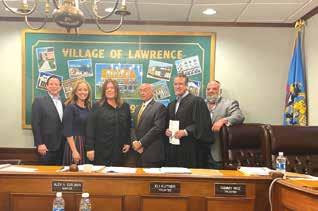






When you think about The Shaar, what comes to mind?
For some people, it’s the serious shteiging by young men who have never tasted the sweetness of Torah before. For others, it’s the geshmak farbrengens and kumzitzes with lively singing and dancing. Or maybe it’s a life-changing Shabbos meal with a local family.



No matter what comes to your mind, it will invariably be an experience that has transformed a young man’s life. Because that is the essence of The Shaar – forever transforming the lives of young men who did not have the benefit of growing up in a religious family or having a Jewish education.

The Shaar has become a magnet for young professionals and college students from across the United States who are searching; looking for an enriching, tra-
jectory-changing spiritual experience as they begin their adult lives. There is a full day of multi-tracked learning for those Shaar members who have put their careers on hold in order to learn full-time, and a robust and vibrant three-hour evening learning program for those Shaar members who work during the day.
Local community members marvel at the incredible energy that Shaar guys bring when they come to homes for Shabbos meals. There’s Torah discussions, singing, dancing, intense ruach, camaraderie, and a palpable sense of people growing in Yiddishkeit. That is why so many local Five Towns families have become so committed to regularly mentoring and hosting Shaar students.
Last month was the 21st Shaar wedding in two years! Over half of the Shaar couples have stayed on after marriage in the Far Rockaway and Lawrence community, continuing to shteig at the Shaar while building their careers and their beautiful Jewish families.
The Shaar has transformed so many young men to date, but there are so many
more neshamos who need to be brought back to Klal Yisrael. Thankfully, the Shaar’s programs are full to capacity, so the need is real and the demand is growing.

The Shaar is now holding its annual Neshama Matching Campaign. We ask that you step up for Klal Yisrael’s future by supporting the Shaar in their holy work of inspiring and building a new cadre of young men to become proud, committed Torah Jews of the future.

Donate now to benefit from the extraordinary zechus of Kiruv Rechokim happening right here in the Five Towns. Please donate $395 (= Neshama) – or more – at www.rayze.it/shaar to help the Shaar inspire more neshamos this year!



It’s absolutely amazing to see the veritable smorgasbord of sports and specialties that take place on a daily basis at Hillel Day Camp.
Our Second Grade girls went to Casa de Spin where they created some really cool spin art. Our Second Grade boys looked like future pro golfers navigating a glow in the dark miniature golf course. Our Third and Fourth Grade campers impressed us all with their bowling skills. Our senior division campers headed out on their overnight trip to Club Getaway, while our CIT’s climbed and soared to great heights at Adventure Park.
At Hillel Day Camp, we emphasize having fun while playing sports. It is our goal for every camper to have a positive and fun experience playing sports so they may continue playing even into adulthood. Coach Daniel Orenstein heads the Hillel Day Camp sports staff. He has been working as a Physical Education teacher in New York City for the past 17 years.
The focus for this year is to introduce fundamental gross motor skills


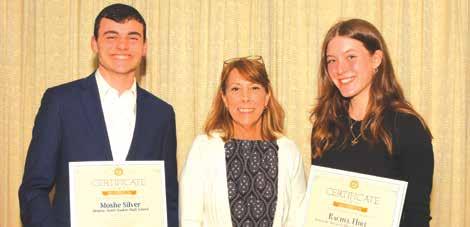
and sports skills like hopping, leaping, skipping, galloping, dribbling, striking, catching, & throwing to our younger campers. These skills will better allow our campers to participate in team sports and leagues both at Hillel Day Camp and in extracurricular sports outside of camp. Their sports sessions have been exciting, as they have been honing team-building abilities while participating in various activities like ball games, hula hooping, relay races, and parachute games. The highlight is definitely the enthusiastic cheering from campers as they root for their friends during soccer, basketball, hockey, kickball, softball, and many other sports.
Our older campers participate in a wide variety of sports leagues that encompass basketball, softball, soccer, hockey, and kickball. Leagues at Hillel Day Camp, run by our professional sports staff, are fun and competitive. Our coaches have many years of experience playing and coaching in Yeshiva and secular school sports.

MTA started their summer tour, visiting two incredible camps where many of our talmidim and alumni are attending and/or working. Our first visit was to Camp Kaylie, where we had the opportunity to catch up with current talmidim, recent alumni, and even more distinguished alumni like Rav Aryeh Lebowitz, shlita, and Rav Shalom Rosner, shlita. Doughnuts and drawstring swag bags were distributed to all, and everyone is looking forward to the ‘23-‘24 school year.
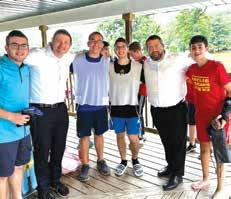

Our day continued with an inspiring

visit to Camp HASC where many of our alumni are counselors and staff. Rabbi Schenker shared a dvar Torah, as well as a recollection of his own summers spent at Camp HASC. A sushi dinner was served at our reunion, and it was a great time to catch up with and see the growth in so many of our alumni. It is clear that the talmidim are hard at work but enjoying the incredibly unique opportunity of being a part of the HASC experience.
Stay tuned for next week’s edition of MTA’s Summer Camp Tour...











Camp Kaylie, a beloved summer camp located in Wurtsboro, NY, warmly welcomed the State Police Department on Wednesday, July 13, to express the camp’s deep appreciation for the officers’ dedicated service. The camp organized a special lunch event, inviting the police officers to join the campers and staff for a memorable occasion filled with gratitude and camaraderie.
The event began with a heartfelt speech from one of the campers, teenager Moshe Cohen. He told the officers, “Every day you provide important services that help keep us safe. You are appreciated more than you know! Thank you for serving, for doing a job that puts others first, and for being heroes in the community.”
Rabbi Shalom Rosner, Camp Rabbi, utilized the opportunity to share an idea







drawing inspiration from our daily tefillah (prayer service). He highlighted a specific prayer that should be said individually and not fulfilled through someone else’s recitation—the prayer of gratitude.
Rabbi Rosner explained that expressing personal gratitude is a deeply personal
and meaningful act, one that should not be delegated to others. By thanking the officers in person, the camp community aimed to fulfill this principle of expressing thanks directly. It was a really special moment for both the campers and their special guests!


Following Governor Hochul’s February 2023 announcement that Far Rockaway would receive a $4.5 million grant through New York State’s NY Forward program, Queens Borough President Donovan Richards Jr. and the Queens Chamber of Commerce announced this week an open call for proposals from Far Rockaway residents to help determine how that funding should be allocated.
“From historic investments in healthcare, libraries and affordable housing, Far Rockaway is in the midst of a true renaissance. With this important investment through Governor Hochul’s NY Forward plan, we will make this tightknit community an even stronger place to live, work and play,” said Borough President Richards. “Together with all our community leaders and residents across Far Rockaway, I know we will jointly put forth a number of impactful proposals that will benefit all our families who proudly call this community home.”
“The NY Forward Program will help kick start our economic recovery, ensuring that downtowns throughout the state have the resources they need to create jobs and opportunities for New Yorkers, and we are delighted that Governor Hochul has awarded $4.5 million to Far Rockaway through this initiative,” said Queens Chamber of Commerce President and CEO Tom Grech. “I look forward to working with Borough President Donovan Richards and all stakeholders in the area to ensure that this money funds projects that further enhance Far Rockaway’s vibrant small business community.”
The open call for project proposals is open to any organization or individual with ideas for capital improvements within the Far Rockaway – NY Forward study area, which includes commercial sections of Mott Avenue, Central Avenue, Cornaga Avenue, Beach Channel Drive and Beach 19th, 20th and 21st Streets.
To be eligible for consideration, projects must:
Contribute to the economic revitalization of Downtown Far Rockaway through the creation or retention of jobs, support for local small businesses, the activation of public spaces, showcasing local artists and the improvement of local quality of life.
Qualify as capital construction, including the development or rehabilitation of real estate or the improvement of public spaces.
Have a sponsor with the ability to lead project planning and implementation, while entering into a contract agreement with the State.

Have a defined scope and budget. All projects must be fully funded once funds requested through NY Forward are accounted for.
Project submissions will be evaluated by NY Forward’s Far Rockaway Local Planning Committee (LPC), a group of community leaders appointed by Governor Hochul and co-chaired by Borough President Richards and Queens Chamber of Commerce President and CEO Tom Grech.
In addition to the open call for proposals, there will be several public engagement sessions where Far Rockaway residents can provide input on the NY Forward planning process. The first public engagement session took place on Monday, July 17 at 6:30 pm, with additional sessions being announced in the weeks ahead.
“This planning open call is an opportunity for all voices of the Rockaway community residents to be heard. To vocalize the needs of the community as the community grows in size and need. We all need to vocalize our thoughts on this forum so that we are heard, and change can occur to support our community,” said JCCRP Executive Director Allison Deal.
YLX: The Yid Learning Experience launched its 10th season this summer. The first two weeks were a hit! The boys learned about the fascinating mitzvah of Lo sisa shema shav, specifically the halachos pertaining to accepting and speaking lashon hara. On Monday, the second week, The White Shul location had a surprise visit from the acclaimed speaker and entertainer Rabbi Eli Scheller from Lakewood, New Jersey, who regaled the boys with a true story from his youth. His message: use the summer to dream!
YLX was conceived and launched by Rabbi Aryeh Dachs over ten years ago. “The success of this program is truly in-

credible,” says Rabbi Dachs. It started as a small group of boys in Beis Medrash Heichal Dovid in Lawrence and has blossomed into two locations: Heichal Dovid for high school aged boys and The White Shul for boys in middle school. The YLX boys get together Monday-Wednesday nights to daven Mincha and Maariv, learn, eat dinner, and socialize with their friends and YLX rebbeim. On Thursday nights, the boys and rebbeim get together at Shaar Hashamayam, the Young Israel of Wavecrest Bayswater, for an evening of barbecue, basketball, and a bonfire.



Rabbi Dachs explains, “Our Thursday night event is very special. The boys run everything, from the barbecue to the

bonfire and basketball games. It is an organized chaos that I love! It takes me back to late nights in camp. I am so glad to bring that to boys who are local in the summer.”
The YLX summer program is indebted to the generous individuals and eat-

eries in the community who sponsor the program. There is no charge to join YLX. YLX 2023 will run through August 10.

To register for the remainder of YLX 2023, email YidLearningExperience@ gmail.com.














Singles Doing Chesed held a successful, ground-breaking, inaugural event at the Tomchei Shabbos of Queens warehouse this past Monday evening, July 17. The chesed-oriented and helpful singles came from all over the tri-state area and beyond to help pack boxes for Tomchei Shabbos while also seizing the opportunity to socialize and become acquainted. A light dinner was served, and when the Tomchei Shabbos tasks were completed, the singles were treated to an enjoyable interactive game which enabled them to get to know each other better. It is hoped that many shidduchim will result from this event as well as from the other functions that the Singles Doing Chesed team already

have scheduled for the near future. Please note that if you missed this event, there is still time to join in as there will be an additional Singles Doing Chesed event happening in conjunction with Tomchei Shabbos of Queens scheduled for Monday July 31. For more information about it or to register for this event, please reach out to SInglesdoingchesed@gmail.com. Singles Doing Chesed is an organization where Orthodox professional singles (ages 2432) have the opportunity to help out local chesed organizations and connect with like-minded singles. Singles Doing Chesed is a new rising star organization – please stay tuned for additional events from them in the near future, b’ezras Hashem.

NEFESH International, the largest organization of Orthodox mental health professionals, has for 30 years been serving the needs of mental health professionals and the community. NEFESH is sponsoring an event for all mental health professionals to discuss clinically relevant issues, community issues involving our relationship with our community and our rabbonim, and networking, so we can meet with other professionals and resources throughout the community to better serve our clients. We invite mental health professionals from Queens and Nassau County to join us this Sunday, July 23, at 9:30 AM at Young Israel of Woodmere to learn from each other and meet one another. NEFESH has responded to the needs of community over the past 30 years, facilitating the training of Orthodox indi-
viduals to serve our Orthodox communities and providing Shabbos-friendly trainings for professionals to improve their skills and provide our community the best resources available. Toward this end, NEFESH sponsors an annual conference, this year December 27-31 at Hyatt Regency Hauppauge on Long Island. For more information, please visit our website, www.nefesh.org.
Nefesh is also excited about a new endeavor, the NEFESH Shabbos of mental health awareness scheduled for Shabbos Parshat Toldot, November 17-18, 2023.
Nefesh, along with other mental health and synagogue organizations, is spearheading this initiative to address mental health issues in our community. For more information, visit our website or contact us at NEFESHcares@NEFESH. org.
Around the Community
Camp Areivim Late Night to American Dream Dreamworks Water Park
Summer Fun at Camp Matov


























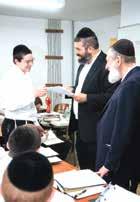






From minor ailments to major medical crises: Dealing with unexpected health situations on Shabbos can be challenging.
Through his Hebrew-language halachah sefarim, Rabbi Avrohom Yaged has earned a stellar reputation for clarifying complex halachah topics in an easy and understandable way. Rabbi Yaged is a dynamic rav who has become the address for many modern-day questions.
Now, for the English-speaking public, Rabbi Yaged brings us A Guide to Refuah on Shabbos, which includes both the general principles of healing on Shabbos and the halachos of how to deal with specific medical situations.
In writing the sefer, Rabbi Yaged worked closely with Harav Yaakov E. Forchheimer, the senior halachic authority of Beis Medrash Govoha, who reviewed all the halachos and whose piskei halachah appear throughout the sefer.
What is considered a life-threatening situation? How high does fever have to be to pose a danger to life? What if a child needs stitches? What about painkillers or medicines? May an allergic person carry an Epi-pen? What are the halachos of going to the hospital on Shabbos to give birth?
A Guide to Refuah on Shabbos discusses these and so many other halachos, offering clear guidelines to help navigate this complex and vital subject.

A Guide to Refuah on Shabbos includes a comprehensive index to ensure easy access to the relevant halachos, as well as detailed sources for those looking for a deeper understanding of the topic. A Guide to Refuah on Shabbos is an essential “halachic first aid manual” a practical guide that should – yes, that must – be on the bookshelf of every Jewish home.
The following is an excerpt from this incredibly helpful new book.
All foods and drinks that are typically eaten by healthy people may be consumed on Shabbos, even when the per-
son’s intention is to heal a minor ailment. Since it is not evident that he is doing so for the purpose of healing, the decree that one may not take medicine does not apply. However, if the foods or drinks are not usually consumed by healthy people, then they may not be consumed by a healthy person to relieve a minor ailment.
1. A person suffering from a sore throat or a cold may drink tea with lemon and honey (as long as no bishul, cooking, is involved) or chicken soup, since these are things that healthy people typically have.
2. One may bite into an orange or lemon and suck out the juice to soothe his throat, as healthy people would do this as well. Doing this involves no problem of sechitah.
3. Someone with a sore throat may suck a cough drop or candy on Shabbos, since healthy people would have such a candy as well.
4. Someone with a sore throat may not gargle with any liquid that people normally drink, since it is obvious that he is doing so for refuah. He may swallow the liquid and drink it in the normal fashion and does not have to swallow it in one gulp.
5. If the liquid is one that people can safely drink but do not commonly do so (such as cooking oil), then drinking it is prohibited, since it is evident that he is doing it for refuah.
6. Someone who has a sore throat may not chew raw garlic or swallow it whole. However, he may put garlic into a salad.
7. One may eat plain honey to soothe his throat, since it is a food that healthy people would eat.
Headache
8. Someone who has a headache may drink black coffee, even if he wouldn’t usually drink it, since it is something that healthy people would drink.
9. Someone who has indigestion may not take Alka-Seltzer or similar medicines on Shabbos. However, he may eat
regular foods that can relieve indigestion, such as yogurt, milk, and eggs.
10. Tums may be taken on Shabbos for indigestion since healthy people would eat them too, because they taste good, or as a calcium supplement.

11. One may swallow a raw egg to improve his voice. Note: A raw egg is not muktzeh.
12. Someone with a toothache or pain in his gums may not rinse his mouth with vinegar or with any other strong-tasting liquid, such as an alcoholic beverage, since it would be obvious that he is doing this for refuah. However, he may drink whiskey or any other alcoholic drink in the regular fashion.
13. Someone who has a toothache may not dab or pour an alcoholic beverage on the painful area.
14. Some hold that a person suffering from a bad toothache may rinse his mouth with an alcoholic drink before swallowing it.
15. One may not rinse his mouth with saltwater to alleviate mouth sores, even if the saltwater was prepared before Shabbos.
Breath Freshening
16. Mouthwash may be used to freshen one’s breath.
17. Chewing gum and mint candies may also be used to freshen one’s breath.
18. Two foods that healthy people commonly eat separately but not in combination may not be eaten together if it is
obvious that this is being done for refuah purposes. An example would be drinking a mixture of lemon, honey, and whiskey to soothe the throat.
Vitamin C
19. Foods may be eaten solely for the sake of their vitamin content. For example, someone who has a cold may eat an orange just for its vitamin C. Similarly, one may eat liver just for its iron. Chapped Lips
20. A person whose lips are chapped may eat bread with butter or margarine smeared on it to lubricate his lips. He may even rub his lips together, as this is all considered the normal way to eat such food. Since butter and margarine are foods, this involves no issue of memarei’ach.
Camp avnet, also known as avnet Country Day sChool, gives hunDreDs of C ampers the time of their lives eaCh summer. w ith two C ampuses, three pools, anD thousanDs of aCtivities eaCh week, eaCh Day at avnet is always roCking!



t his week, we spoke with Daniel Stroock, C amp DireCtor, to hear more about the energy, exCitement, anD nonstop fun that takes plaCe at Camp avnet every Day of the summer.

Daniel, Avnet has been around for more than six decades. What has changed and what has stayed the same over all those years?
It’s really incredible that Avnet Country Day School has such a rich history in the community. Everyone remembers the iconic Long Beach location in the old HALB building. The beach and boardwalk were an extension of the experience, and the setting was idyllic. There was also a second Dix Hills location for many years which was a 10-acre sports camp. It was considered a great alternative to sleepaway camp. When HALB moved to the heart of the community in 2017, Avnet found a new home at the Hirt Family Campus (elementary school) to go along with the already thriving Lev Shlomo Campus (DRS). This enabled us to double our programming. While Avnet’s location has changed, our values as part of the HALB family have stayed the same. What matters most is giving our campers a summer to remember!
What sets Avnet apart from other local camps?
There are a lot of great camps in the area, but Avnet is a standout because of the generations of families who have spent their summers with us. After so many years, it’s quite typical for current campers to have parents and grandparents who are eager to share their stories with me. Parents fondly remember their time at Avnet, and they want their children to get the same attention and reach the same milestones. Countless kids have learned to swim with us. I myself was a Long Beach camper and still have my “swim progress” card hanging in my office – but I won’t say what year it was issued! I’ve heard of parents comparing their vintage “camper of the week” trophies with the new ones their kids bring home.
Last year, you launched SPARRK. Are you doing it again this year?
We’re really proud of the SPARRK program, and it’s a
focal point of the summer in year two! We created the program to encourage exemplary behavior and promote good middot. SPARRK points are awarded for excelling in the key criteria of Safety, Participation, Avnet Ruach, Respect and Kindness. We have score boards on display throughout both campuses. Bunks can make a “purchase” from a list of amazing bunk prizes. Prizes start with small treats and build up to all sorts of bunk celebrations like a “spa” day, tie dye party, ice cream sundaes, pizza and even a game truck. It fosters a feeling of achdus within each bunk as the campers work together towards their goal.
How many campers are in Avnet? Where do they hail from and how do you help to make each camper feel at ease?
We are blessed to have a phenomenal enrollment! This has caused us to close down registration for the last two years months before our season began. While we hate turning anyone away, we have to maintain a set ca-
pacity to keep our campers safe. It’s important to us that every camper receives personalized attention so they can feel comfortable and learn new skills.
Our campers really have an opportunity to grow socially and make new friends, since they represent many different communities and schools. They come from the Five Towns, Far Rockaway, Bayswater, Great Neck, Oceanside, West Hempstead, Long Beach, Atlantic Beach, Lido Beach, and Queens. Of course, many HALB students attend Avnet, but we also draw campers from YCQ, Shulamith, South Shore, HANC, HAFTR, Har Torah, MDS and some of the local public schools. Avnet is, in and of itself, a summer destination for many. We even have campers joining us from Israel and all over the U.S. when they visit the area to see grandparents and family.
Tell us about your two amazing campuses.
It’s true that when HALB moved to Woodmere, Avnet doubled the fun! We
have extensive facilities that extend across both the elementary school and DRS campuses. Many of our campers, regardless of where they are based, take part in activities on both campuses during their day. There is constant activity across our baseball fields, basketball courts, hockey rink, heated pools, gyms and in our spectacular auditorium.
There are seven divisions at Avnet. That’s a lot! Tell us about them.
We have seven divisions since our campers’ range in age from 3-14. There are five divisions housed in our Hirt Family Campus and two divisions in our Lev Shlomo Campus. Having the right staff is essential. Our upper staff is entirely comprised of experienced educators, most of whom hold advanced degrees in special education and counseling. We also have close to 300 counselors and specialty staff members.
Leah Koegel heads our Tipot or preschool division. We have two divisions for first through third grade: Ma’ayanot Boys led by Moshe Spern and assisted by Megan Herskowitz; Ma’ayanot Girls led by Miriam Steiner and also assisted by Megan. Girls entering 4th through 5th grade are in our Agamim division, which is headed by Ariana Wolfson and assisted by Chani Feldman. Our Naharot division for 6th through 8th grade girls, also headed by Ariana and Chani, offers more mature programming.
On our Lev Shlomo Campus, we have
two divisions for boys. The G’vaot division is for 4th and 5th graders, while Harim is for 6th through 8th graders. Ashley Alibayof and Rabbi Asher Dworetsky head these divisions, and they are assisted by Shua Behar.
Malkie Behar is our Director of Operations. She runs our office year-round and has a phenomenal ability to connect with and remember almost every family and staff member.
How do you keep your littlest campers happy and excited each day?
Our youngest “Tipot” campers are fully engaged in the Avnet experience. We’re not a “preschool camp,” but we adjust our activities to their developing abilities, so they learn to participate and build skills. The Tipot have Art, Gymnastics, Zumba, Drama, Country Cooking, Music & Movement, and various sports just like the older children. When it comes to aquatics, they also have the opportunity to learn to swim in real pools along with their older peers.
Speaking of swimming, summer is all about swimming! Tell us about Avnet’s swimming program.
Swimming is a major focus at Avnet. We have three on-site heated pools that allow for a capacity of over 250 campers at a time. Headed by Yaffa Sebag, we are fortunate to have a large, well-trained lifeguarding staff to keep the children safe and build their skills. We offer both
instructional and free swim. Our youngest campers begin their aquatics careers with their attempts to swim across the pool. Once they have done so, they get an “I Learned to Swim at Avnet” shirt.
I’m sure you go on great trips and host special programs.
Besides the standard activities, we plan many on-campus and off-campus adventures. We hosted both a carnival and a petting zoo last week. This week, we’re looking forward to having Lazer Tag and a game truck on site. Next month, we’re excited that the circus is coming to town with the National Circus Project.
Our off-campus trips include Jump Town USA, Active Kidz, Launch, Laser Bounce, Adventure Playground, Sky Zone Trampoline Park, Casa De Spin, Top Golf, Once Upon a Tree Top, Dave & Busters, and Adventureland. We send all of our preschoolers, as well as our elementary school girls, to gymnastics each week. The boys have bowling as a regular part of their schedule.
The older kids had an incredibly sweet time at Hershey Park last week. The G’vaot and Harim also enjoyed a Long Island Ducks game. The Naharot and Harim campers will go on an overnight to Club Getaway. We’re very excited to be sending our 4th & 5th graders, as has been our tradition, to Camp Mesorah to experience all the great things sleepaway camp has to offer but with the comfort of


3 Heated pools
7 Divisions
1:4 Ratio of staff to campers
45 Periods in a week per group
64 Years of camping fun and experience
300 Tickets to Hershey Park
9,000 Towels handed out each week
More than 1,800 activity periods happening PER WEEK!
36,000 Ice cream/ ice pops enjoyed per summer
66,000 8 oz. water bottles handed out per summer to keep our campers hydrated throughout the day

being there with their Avnet counselors. Sounds like so much fun! What’s a “typical” day like at Avnet?
Each day is a brand-new adventure, but there is a set routine between 9 a.m. and 4 p.m. We plan the summer from the perspective of our campers, so the day is packed with a variety of specialties and sports we know they love. Our specialties include Chinuch, Country Cooking, Culinary Creations, Arts & Crafts, Fine Arts, Music & Movement, Nature, Orienteering, and Zumba. STEM is a favorite activity which allows campers, and even staff, to engage with their creative side and use critical thinking skills. We introduced Drama this summer, which is giving the campers a chance to hone their acting abilities.
Shua Behar is the Sports Commissioner for the Harim and G’vaot boys. Our sports include softball, soccer, basketball, hockey, tennis, volleyball, gaga and dodgeball. While there are competitive leagues which generate enormous excitement, we also make time for sports clinics so all our young athletes can hone their skills.
Of great importance, and immense pride to us, is our amazing Chinuch staff: Morah Rivie Blum, Morah Suzi Scharf,
Danielle Forman, Rabbi Hillel Lichtman, Rabbi Jay Nathanson and Rabbi Dovi Weinberg.
There is so much to do each day! Do you sleep? How do you manage to keep the camp running smoothly?
Sleep is overrated! But seriously, behind the fun at Avnet the key word is “schedules.” We have over 40 bunks, and each bunk has 9 periods in a day over
nator and the popular manager of the SPARRK program. They keep each day running smoothly.
We’re in the middle of the Three Weeks. Are there special activities or a special focus in camp during this time?
We try to teach our campers to respect the importance of the Three Weeks while balancing summer fun. This starts at the preschool level. Our chinuch groups discuss the time of the year and




number of staff it needs every year?
We understand that our staff is looking for an exciting summer just as much as the campers. We’re demanding of them during the day, and that’s why we provide frequent staff night activities including game shows, scavenger hunts, staff color war, dinners, movies, and open gym nights. This allows the staff to bond and relax after hours.
What makes you happiest to hear about campers’ experience at Avnet?
Our main goal every summer is to make kids happy. It sounds simple, but it means everything to us. When I walk around campus, the most fulfilling thing is seeing the pure joy and excitement on the children’s faces. There is nothing like hearing their laughter as they experience all the activities Avnet has to offer. This is possible because our staff operates as a team with a shared mission of bringing joy to our campers.
the course of a 5-day week. That means we’re offering more than 1,800 different activity periods per week! Ilana Mann, our talented Program Director, manages all of our intricate scheduling, and she makes sure each group has an amazing activity to go to at any given time. Ilana works with Esther Gottlieb, who is our Program Coordi -
its significance, and we convert our free swim time into a “swim-a-thon” to benefit Chai Lifeline. Our swim-a-thon is going on this week, and anyone can donate to this great cause by visiting https:// chaiathon.rallybound.org/Donate and clicking on team Avnet HALB.
How does Avnet manage to draw the
During the months of pre-camp planning, I’m filled with memories of our amazing campers, and it motivates me to make each summer better than the one before. I love it when kids run up to me bursting with pride or call me over to watch them play sports. They are eager to show off their latest art project, cooking creation, or “camper of the week” trophy. We’re creating memories together, and that is what Avnet is all about!
"
w hen i walk arounD Campus, the most fulfilling thing is seeing the pure joy anD exCitement on the Chil Dren’s faCes."

U You ask your spouse to go for a walk together because you have no doubt that they will decline.
U You understand why Costco sells a 42-bottle deodorant pack.
U Chickens are laying hardboiled eggs.
U Every time I think about ice, water pours out of your ears.
U You drink six iced coffees a day, instead of the five that you usually have.
U The four seasons are: tolerable, hot, really hot, and ARE YOU KIDDING ME?!

U You eat hot chilies to cool your mouth off.
U You finally admit that you could never live in Florida all year.
U Your dream house is any house in Alaska.
U You learn that a seat belt makes a pretty good iron.
It’s pouring rain outside and Yanky tells Baruch, “Let’s go for a walk.”
Baruch says, “Yanky, can’t you see—it’s raining outside.”


Yanky replies, “Don’t worry, I have a large umbrella.”
They go for a twenty-minute walk. Not only do they not get wet, but their umbrella doesn’t get wet either.

How did that happen?
Answer: They went for a walk inside.
1. What word is used to describe “the pleasant smell of rain”?

a. Ambrosia
b. Petrichor
c. Will-o’-the wisp
d. Utopia
2. Which city gets the most annual rainfall, with an average of over 467 inches of rain per year?
a. London
b. Seattle
c. Mawsynram, India
d. Any city that my kid’s camp is in and that I have to go to on visiting day
3. What is the average speed of a falling raindrop?
a. 3-7 MPH
b. 15-25 MPH
c. 50-75 MPH
d. 160-200 MPH
4. The French island territory of Réunion in the Indian Ocean has the record for the most rainfall in a 24-hour period, achieved in
January 1966. How much rainfall did they get?
a. 8 inches
b. 23 inches
c. 42 inches
d. 71 inches
5. Which U.S. state receives the least amount of rainfall annually?
a. Wyoming
b. Utah
c. Nevada
d. Arkansas
6. Which of the following is a term for someone who loves rain?

a. Pluviophile
b. Rainiologist
c. Moistist
d. Heliophile
7. What is the average annual rainfall in New York state?
a. 50 inches
Three guys walk out of a bar. When they reach their car, they realize that they had forgotten the keys in the car.

Jimbo says, “I’ll go see if anyone has a metal coat hanger to pick the lock.”
b. 73 inches
c. 112 inches
d. 247 inches
8. Which state gets the most rain?
a. Florida
b. Michigan
c. Hawaii
d. Montana
Answers:
Wisdom Key:
6-8 correct: You must be part of the pluviophile society – a society of one!
3-5 correct: You are cloudy with a change of showers.
0-2 correct: Poked your head with an umbrella or something?
Bubba objects, “If you do that, people will think we are stealing the car.”
Billy Bob says, “Hurry up you two and find a solution – it is gonna rain and the car’s roof is down!”
This week’s parsha, Devarim, is a continuation of last week’s parsha of Maasei. This is because it also forms a narrative review of events that occurred to the Jewish people during their forty years of life in the desert of Sinai.
Just as last week’s parsha reviewed for us the stations where the Jews encamped during those forty years, so does this week’s parsha review for us
key events that befell the Jewish people during those decades of supernatural life and wanderings. But there is a fundamental difference between these two narrative views of past events. The review in Parshat Maasei is essentially presented in an objective, even detached manner. It is full of facts, names, and places, but it is basically an unemotional and factual report regarding a long forty-year journey of the people of Israel.
This week’s parsha contains a review of facts and events by Moshe. It is a personal and at times emotional and painful review of those years in the desert. Moshe bares his heart and soul and shares his frustrations and emotions with us.
Parshat Devarim, in fact, all of Chumash Devarim, is a record of how Moshe personally saw things, and it records his impressions and feelings regarding the events of the desert of Sinai. In many ways, it is one of the most personal and emotional books in the entire canon of

different, and everyone’s view of events is also different one from another. Thus, everyone’s service of G-d and Torah, albeit within the parameters of established and recognized halacha, must contain nuances of difference.

The importance of the Torah emphasizing to us that the book of Devarim is Moshe’s personal record of events is to stress to us this recognition of individuality that exists within every human being and how that affects one’s view of everything, spiritual and physical, in life.
Tanach. It is not only Moshe’s words that are on display before us in the parsha. It is his viewpoint and assessment of the Jewish people and its relationship to G-d that is reflected clearly and passionately in his words.

Opinion and passion are key to the service of G-d according to Jewish tradition. Judaism does not condone “holy rollers” in its midst, but the entire idea of the necessity of kavanah/intense intent in prayer and the performance of mitzvot speaks to a personal view of the relationship to G-d and Torah and a necessary passion and viewpoint. Everyone is
Moshe’s recorded personal anguish at witnessing the sins of Israel in the desert is a greater indictment of those sins than just the description and listing of the sins themselves would have been. Life is personal, never objective. Moshe’s personal view of the events of the desert makes these events real and tangible to us. We are also involved in the narrative because of our empathy with Moshe. This is what makes the entire book of Devarim so real and important to us. People speak to people. Moshe speaks to us. Shabbat shalom.

Adapted for publication by Binyomin Wolf
Rav Yaakov Yitzchak of Peshischa, known as the Yid Hakadosh, zy”a, studied a few pesukim from Sefer Devarim every day and encouraged his chassidim to do the same in order to increase their fear of Heaven. He called Sefer Devarim the best mussar sefer. The Maharal, Reb Tzadok Hakohein, and others explain the deep essence of Sefer Devarim, but on a simple level, we must understand the unique nature of the sefer and why Shabbos Chazon, the Shabbos before Tisha B’Av, always occurs on Parshas Devarim.
There is a pasuk in Shmuel (2:1:18) which refers to a mysterious book called “Sefer Hayashar,” “the Book of the Upright.” The Gemara (Avoda Zara 25a) offers a number of opinions regarding the identity of this book:
Rabbi Chiya bar Abba says in the name of Rabbi Yochanan, “This refers to the book of Avraham, Yitzchak, and


Yaakov [sefer Bereishis] who were called upright...” Rabbi Elazar says, “This refers to the Repetition of the Torah [sefer Devarim]. Why is it called the Book of the Upright? Because the pasuk (Devarim 6:18) says ‘And you shall do what is upright and good in the eyes of Hashem.’” Rabbi Shmuel bar Nachmeini says, “This refers to the book of Shoftim. Why was it called the Book of the Upright? Because the pasuk (Shoftim 21:25) says, ‘In those days there was no king in Israel; each person did what was upright in his own eyes.’”
The Maharsha, commenting on this Gemara, points out that it is understandable why Bereishis would be called the Book of the Upright since its central theme is the lives of our upright forefathers. It is also understandable why Shoftim would be called the Book of the Upright because the people at that time were the antithesis of that which is upright. Why, he asks, would Sefer Devarim be called the Book of
the Upright based only on one pasuk that uses the word “upright”? Indeed, the word also appears in Sefer Shemos. The Iyun Yaakov, a commentary on the Ein Yaakov, answers that Devarim, not Shemos is called the Book of the Upright because the word “upright” appears four times in Sefer Devarim and only once in Shemos, but this explanation is not satisfying. The Navi must have used the title “The Book of the Upright” to describe the book’s essence and not based on a tally of how many times the word “upright” is used in each book.
The Maharsha offers a beautiful explanation. By and large, all of the individual mitzvos are given in the other four books of the Torah. They are given as a list of details; a string of “thou shalts” and “though shalt nots.” The purpose of Sefer Devarim is to wrap all of those details into a unified whole called a “Jew,” a spiritual identity which is greater than the sum of its parts.
The purpose of Sefer Devarim is to teach a person how to go above and beyond each of the individual details of Jewish life to become someone who does “what is good and upright in the eyes of Hashem.” Such a Jew connects the dots of each of the mitzvos into one single transcendent reality. He lives not just to fulfill each of his obligations but to make his Father in Heaven proud.
The Gemara (Taanis 15a) says, “Not everyone will merit light and not everyone will merit joy. The tzaddikim merit light, and the upright merit joy.” Rashi points out that the upright are on a higher level than the tzaddikim. The commentaries ask how Rashi could explain that the upright are greater than tzaddikim. Aren’t tzaddikim also upright? It must be that while tzaddikim keep all of the individual mitzvos, the upright weave all of those details together and go beyond the letter of the law. An upright person sanctifies him-
self by avoiding even certain things which are permissible because he listens to the voice of Hashem within himself. Hashem’s will is not the sum of everything which is technically permissible or forbidden. An upright Jew asks himself what Hashem wants
In the Talmud, Rabbi Yehuda normally does not derive anything from the juxtaposition of seemingly unrelated pesukim based on the principle that the pesukim of the Torah are not written in chronological order. But the Gemara (Yevamos 4a) says that Rabbi Yehuda does derive teachings based on the juxtaposition of pesukim in one book: Sefer Devarim. Why? Because a pasuk in Tehillim (111:8) says, “Steadfast, [semuchim, juxtaposed] forever, made in truth and uprightness,” and Sefer Devarim is called the Book of the Upright. Because the pasuk uses the word for “juxtaposed” with the word “upright,” Rabbi Yehuda infers that one can learn from juxtaposed pesukim in the book known as “upright.” Because Sefer Devarim is the Book of the Upright, in which everything about Yiddishkeit is connected, Rabbi Yehuda can derive laws from even seemingly unrelated pesukim which are found side by side. In other words, because of Sefer Devarim’s identity as a book which connects all of the seemingly disparate details of halacha, one can derive laws from even the seemingly insignificant order of the pesukim.
The lack of uprightness was the central theme of Yeshaya Hanavi’s rebuke of the Jewish people in the haftara of Shabbos Chazon (Yeshaya 1:2, 4). He wrote, “Children I have raised and exalted, yet they have rebelled against Me... Woe to a sinful nation, a people heavy with sin, children of evildoers, corrupt children. They have abandoned Hashem, they have angered the Holy One of Israel, they have turned backwards.” One might think that these harsh pesukim must refer to the worst nonobservant Jews who are heretics and idol worshipers.
But it is clear from the pesukim later in the perek that the Navi is speaking to very “frum” Jews! The Navi says (Id. at 12, 14-15), “When you come to appear before Me [in the Beis Hamikdash on Pesach, Shavuos and Sukkos], who requested this of you, to trample My courts? ... Your New Moons and your appointed seasons My soul hates, they are a burden to me. I am weary of enduring them... Even when you pray at length, I do not hear; your hands are full of blood.” The Navi is speaking to Jews who were careful to come to the Beis Hamikdash three times a year. This shows that they were also careful with all of the laws of purity and impurity. They also kept
Shabbos and Rosh Chodesh. And not only did they daven, but they “pray at length!” Yet Hashem despises their service?!
Why did Hashem reject their service? Because they attempted to keep all of the details while forgetting about
ca. As Reb Shlomo was about to pass the rosh yeshiva, he saw that a young woman, a “hippie” he knew from Los Angeles, was sitting right next to the rosh yeshiva. Reb Shlomo knew what the girl was going through and that she had just separated
Shlomo slept for a few hours during the flight but woke up to find the rosh yeshiva standing next to him. He told Reb Shlomo, “I want you to know, I got a little taste of what you’re doing. Thank you so much.”
Reb Shlomo concluded that the letter of the law may be that one should not talk to women. And while one must know the proper way to do such things, Hashem’s will at that time was that the rosh yeshiva talk to the girl and strengthen her. For a long time after that flight, the girl would tell Reb Shlomo, “I want you to know, on that El Al flight with that big rosh yeshiva, he literally saved my life.”
We must look beyond checking off all of our religious obligations from our Yiddishkeit checklist and ask ourselves, “What does Hashem want from me right now? What would make Him proud?”
the heart of Yiddishkeit. They were not upright. They did not study the ultimate mussar sefer, the book of Devarim. They kept only “checklist Yiddishkeit,” without ever asking, “What does Hashem want? What will make Him happy?” They made no effort to fulfill “And you shall do what is upright and good in the eyes of Hashem.” They managed to keep the mitzvos but turned away from G-d. Hashem told them through the Navi, “This is not what I asked of you! This is not what I wanted!” Hashem told them (Id. at 16-17), “Wash, cleanse yourselves... learn to do good, seek justice.” The way to rectify their sin was not to become frummer but to become more upright.
How do we see this today? My parents were at a hotel in the Catskills which was full of many frum Jews, both chassidish and litvish. As the guests were leaving the hotel, they were packing up provisions from the hotel’s catering department for the road. They did not limit themselves to a few cookies for the road, however. Many people loaded up shopping bags full of food to bring back home. He saw one older man accidentally drop a shopping bag he was carrying from the hotel kitchen. Six or seven bags of hot dog buns fell out of the bag. This man may have davened a beautiful Shacharis and gone to the mikvah that morning, but here he was stealing from the hotel. Where is the uprightness?
Reb Shlomo Katz circulated a story told by Rabbi Shlomo Carlebach that brings this idea to life. Reb Shlomo knew one major rosh yeshiva who stopped talking to him because of his unusual outreach activities. He was still cordial to Reb Shlomo but always let him know that he did not approve of what he was doing. One day, Reb Shlomo saw this rosh yeshiva on an El Al flight from Eretz Yisroel to Ameri-
from her non-Jewish boyfriend. She had gone to Eretz Yisroel but had to return to the States. As he passed the rosh yeshiva, Reb Shlomo told him, “Heilige rosh yeshiva, you have twelve hours. Do you know what kind of mitzvah G-d put under your nose? You could talk to this girl and give her strength forever.” The rosh yeshiva looked at Reb Shlomo as if to say, “Me, talk to her? Are you crazy? I have to learn!” But the rosh yeshiva was a great man. Reb
May we merit to live upright lives and may this Tisha B’Av be transformed from a day of mourning into a day of celebration as we greet Moshiach with the arrival of the final redemption.

The purpose of Sefer Devarim is to wrap all of those details into a unified whole called a “Jew,” a spiritual identity which is greater than the sum of its parts.
There is a midrash that describes the four exiles of Jewish history:
Galus Bavel, Galus Paras u’Madai, Galus Yavan and finally Galus Edom, after the Romans destroyed the second Beis Hamikdash, leaving us in our current exiled state for more than 1,900 years. But how many of us feel in our daily lives that we are in exile, that there is a lowered spiritual state of our people? An honest assessment is not a comfortable one, but it rings true. Many of us do not feel the pain of Galus because after over 1,900 years, we don’t even remember that once upon a time, we were living in a world where we experienced Geulah.
Chazal described the period we are living in as the Ikvus d’Mashiach, the footsteps of Mashiach, where each Jew has the very difficult challenge of writing that final chapter in Jewish history, or in a sense, the history of the entire universe.
When the first Beis Hamikdash was destroyed, the Jewish people went into exile for 70 years and then bounced back. We rebuilt the Beis Hamikdash in the same spot where the first one stood. It did not have the same presence of G-d that was felt during the first Beis Hamikdash, but there was a sense of triumph that we had picked ourselves up from the ashes of the first churban.
Rabbi Yaakov Emden shares a fascinating idea in his commentary on the siddur. He says that when the second Beis Hamikdash stood, they celebrated on Tisha B’Av with eating and drinking – it was a day of yom tov, of tremendous celebration.

Unfortunately, 420 years later, on the same day, the unfathomable happened and the Beis Hamikdash was again destroyed and a day that had become a yom
tov once again became a day of tremendous pain and suffering for the Jewish people. The same day, the same exact place. The Gemara in Rosh Hashanah drives this point home by saying that fasting on Tisha B’Av is mandatory because
strength to rebuild. And now, fast forward to the length of the Galus, and it is easy to understand why we feel so stuck.

One of the greatest enemies we face in Galus is time. Galus drags on, and we feel grounded by it. The Belzer Rebbe offered
ly, life without the Beis Hamikdash has become normal for our generation.
The central question on Tisha B’Av is Eichah, “How did we get here?” Normally, we understand it as utter despair, but I think there is a deeper dimension. When we ask on Tisha B’Av, “How did we get here?” we subtly remind ourselves that we were not always here. We are waking ourselves up to realize that we don’t have to accept life in Galus. If we find the strength to pick ourselves up and do teshuvah, we will leave Galus behind once and for all.
Rabbi Nachman of Breslov was approached one time by a chassid who was feeling bad about his mistakes and was convinced that there was nothing he could do to change the spiritual damage.
Rabbi Nachman famously said to him, “Im ata ma’amin sheyochlim mikalkel, ta’amin sheyochlim metaken, If you believe you can damage the world, believe you have the ability to correct the world.”
Tisha B’Av is the day that we start believing in Geulah in a real way again.
the holiday marks the anniversary of a double destruction and a day of multiple losses. The Baalei Tosfos points out that the 17th of Tamuz is not that different in terms of multiple tragedies but wisely explains that it is not just that on Tisha B’Av many bad things happened. Rather, it is that the exact same thing happened on the same day and in the same spot.
It is very easy to understand why we did not have the physical and emotional
an interesting thought on the pesukim at the beginning of Sefer Shemos. When the Jewish people first came to Mizrayim, Chazal tell us that Yaakov Avinu davened on our behalf that we should not get stuck in Galus. The Belzer Rebbe notes that it says, “These are the names of the Jewish people who are coming to Egypt” – a Jew has to see oneself as being in the present tense when he or she is in Galus rather than a permanent plan. But unfortunate -
Let’s use Tisha B’Av to start believing in Geulah in a real way, because if we make it real, it will produce real results. It has been a long Galus, and many feel that their souls and bodies are tired. But G-d can give us the strength to finish writing that final chapter in Jewish history at any moment.
May we be zocheh to see the Beis Hamikdash rebuilt speedily in our days.
Galus drags on, and we feel grounded by it.
Many attorneys are familiar with the case of Pierson v. Post. It is often the first case studied in law school when property rights are taught.
The trouble started in 1802 at an uninhabited beach near Southampton, New York. Lodowick Post, a local resident, was out with a hunting party when his hunting dogs caught the scent of a fox and began pursuing it. As they drew near the fox, Jesse Pierson, another local resident, saw the fox—though he denied seeing Post and his party—and promptly killed it and carried it off for himself. Post filed a lawsuit against Pierson, claiming that because he had already begun pursuing the fox, the property of the fox’s pelt and carcass were rightfully his and not Pierson’s. The local justice ruled in favor of Post. Pierson appealed the ruling to the New York Supreme Court of Judicature, which reversed the justice’s decision and ruled in favor of Pierson.

The dispute required determining at what point a wild animal becomes “property.” The judges chose not to follow common law precedent on wild animal capture, and so were forced to synthesize reasoning from a variety of well-known historical legal treatises. They concluded that Post did not acquire the fox just because he was chasing after it. Therefore, Pierson was entitled to keep the fox. However, they added, if Post had mortally wounded the fox or actually ensnared it thereby depriving the animal of its liberty, then Post would indeed be the rightful owner.
What if Post and Pierson were Jewish and adjudicated this case in beis din? What would the Beis Din of Southampton rule? The primary premise of the New York Supreme Court would seem to be sound. Someone does not acquire an animal just by looking at it or chasing it. One needs to make a kinyan on an object to acquire it. However, beis din would go
further than the court. Even wounding the animal or ensnaring it is not necessarily enough to acquire the animal.
The Mishna states, (Gittin 59b) “Animals, birds, or fish that were caught in traps are not acquired by the one who
else already trapped. However, unless the trapper made an actual kinyan on the animal, the trapper cannot sue the offending party in beis din. Rebbe Yosei rules that a trapper acquires an animal when he merely traps it and can enforce this right
if Post effectively trapped the animal by wounding it, Pierson may not take the animal. But if Pierson took the animal, Beis Din will not take the animal away from him. If Post had the fox trapped in a cage, then Beis Din would take it away from Pierson. The aforementioned would seem to be the ruling of the Shulchan Aruch (CM 273:14) and the majority of commentators.
The Ketzos HaChoshen (273:4) seemingly disagrees. An animal can be acquired with “meshicha ” or “hagboah .” Pulling an animal or picking it up are both bona fide methods of acquisition. However, one doesn’t need to actually pull an animal or pick it up. One can call the animal. If it moves towards the caller, the caller has performed a kinyan meshicha. Similarly, one doesn’t actually have to pick up an animal. If one holds food above an animal’s head and it jumps to get the food, hagboah was performed. (Tosfos in Kiddushin 26a) Likewise, the Ketzos argues that if one puts food on a hook and causes a fish to swim towards the food, he has acquired the fish. This is true even though the fish is only caught on a hook and not in a cage or net. This ownership is even enforceable in Beis Din. Similarly, if one mortally injured a fox and caused it to move by chasing it, that individual has acquired the fox. If an interloper nevertheless took it, Beis Din would take it away from him.
set the traps until he actually takes possession of them. Nevertheless, if another person comes and takes them, it is considered robbery on account of the ways of peace. Rebbi Yosei says: This is fullfledged robbery.”
The Gemara explains that the dispute between Rebbe Yosei and the Sages centers around whether one may enforce this right in court. The Sages rule that one cannot take an animal that someone
in beis din. The halacha follows the Sages. (CM 370:4 with Be’er HaGoleh)
However, the Gemara adds a caveat. If the trap actually holds the animal, as is the case with a cage, then the trapper fully acquires the animal even according to the Sages. It is only when the animal cannot move because of a hook or a leg snare, that the trapper does not acquire the animal.
Therefore, Beis Din would rule that
Perhaps the New York Supreme Court in 1805 followed the opinion of the Ketzos and ruled that mortally wounding a fox is sufficient to acquire ownership (coupled with the fact that the hunter caused it to move).
Rabbi Avrohom Sebrow is a rebbe at Yeshiva Ateres Shimon in Far Rockaway. In addition, Rabbi Sebrow leads a daf yomi chaburah at Eitz Chayim of Dogwood Park in West Hempstead, NY. He can be contacted at ASebrow@ gmail.com.
Ilove Philadelphia! I do not recall how many times we have been there, but it is surely close to twenty times. Neither do I remember if I was ever there before I got married. But I do remember the many occasions and places that formed my favorable impression of the City of Brotherly Love. When my sister got married in 1978, the new couple lived in Bala Cynwyd, a suburb of Philadelphia. We went there for Sheva Brachos, and when their son Henoch was born, we came for the bris. We went to them twice for Shabbos before they moved to Brooklyn. In 1981, I was stuck over Shabbos at the Philadelphia Yeshiva when a Friday snowstorm prevented me from returning to New York from Washington, D.C. Pesi and I stayed in Philly over Shabbos three times, all in the historic area where, at the time, there were three Orthodox shuls to choose from. One of those occasions was when Pesi was exhibiting and selling her jewelry creations
 By Hershel Lieber
By Hershel Lieber

at a trade show which started on a Sunday. The other times we went to absorb the experience of Shabbos within the atmosphere of Colonial America. We also went to Philadelphia a number of times with our children and grandchildren during Chol Hamoed trips. In 2016, we went on a two-day trip with our dear friends David and Susy Avigdor, exploring some of city’s main attractions. Our children once bought us tickets to the Philadelphia Symphony Orchestra, and we turned that into a two-day stay. Like I said, “I love Philadelphia,” and there are some very good reasons why I do!
I am sort of a history buff. World history and more so American history were my favorite subjects in high school. My first exposure to American history was when we learned about the Thirteen Colonies and the American Revolution in elementary school. This was in the Bobover Yeshiva, and we had a very good teacher who brought the American struggle for independence from England to life. The cities of Boston, New York, and Philadelphia played a great role both prior and during the Revolutionary War. Boston, and to a lesser extent New York, have some buildings that represent that era, but Philadelphia is home to the nation’s most historic square mile. Many of these buildings played some role in the formation of our nation, but no building carries as much significance as Independence Hall, where both the Declaration of Independence and the United States Constitution were adopted.
Walking around this historic area is a delightful treat. On one occasion, we took a walking tour with a guide who filled us in on so many interesting facts about this vicinity and the famous personalities that lived there. When we approached the Liberty Bell, we took pride in reading the inscription which quotes the Torah verse, (Vayikra 25:10)
“Proclaim liberty throughout all the land unto all the inhabitants thereof.”
Other buildings that we visited in the area included Carpenter’s Hall, the site of the First Continental Congress, and the Betsy Ross House where the nation’s first flag was sewn. The city was the nation’s capital between 1890-1900 and both George Washington and John Ad-

ams lived there. Another famous son was Benjamin Franklin whose personal history is intertwined with this great city. Philadelphia takes a leading role in American Jewish history as well. Although there were some personalities who were loyal to King George III, the majority of Jews supported the cause of independence from England. The
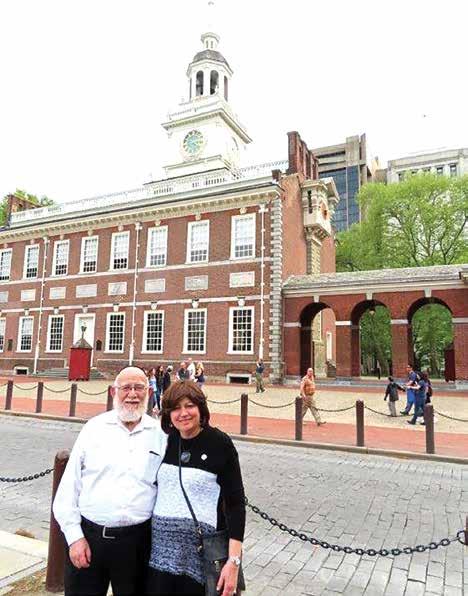
Mikveh Israel Congregation, which was started by Spanish and Portuguese Jews from England and The Netherlands, counted among its membership the American patriots Jonas Phillips, Rebecca Gratz, and the well-known Haym Solomon, who financed the Revolutionary War. The shul is still in existence and is quite active. The present modern building was inaugurated in 1976, two hundred years after the American Revolution, and is located smack in middle of the historic square. By the time Isaac Leeser became the congregation’s rabbi in 1828, the synagogue became the most well-known in the United States.

One more interesting fact: The National Museum of American Jewish History, which was started at Mikveh Israel in 1976, moved into its own 100,000 square foot building in 2005. We visited the museum on three occasions, and though I have a fair amount of knowledge about our country’s Jewish history, we were overwhelmed by the museum’s collection and the professionalism employed in making the exhibits relevant to all visitors. On one particular visit, we took a docent’s tour of the entire exhibit. After the tour, she complimented my knowledge about many facets of the exhibit. I continued my conversation


with her about her Jewish background. She told me that she lives nearby and is a member of one of the city’s numerous Conservative congregations. She added that her older daughter had become Orthodox and her younger daughter was also moving in that direction and that they both lived in Israel. I asked her how she felt about that. She responded that at times she feels that her children abandoned her lifestyle and took on a difficult and obsolete path in their Judaism. I acknowledged her feelings but added that when her daughters will eventually marry and start families, she will be the proud grandmother of children to
whom being Jewish matters. That dream is not something that many of her contemporaries will realize. She nodded in affirmation and declared that “yes, this is truly my dream, and I should feel more positive about their Orthodox affiliation.”
Back to the Philadelphia we love. The city has an enormous number of attractions for tourists. Over the years, we probably have been to most of them. The Philadelphia Museum of Art has a world class collection covering every period, as well works from major artists. The Franklin Institute specializes in scientific education and research. Both this mu-

seum and the Philadelphia Zoo capture the interest of both adults and children. We recently took a tour of City Hall and were ushered up to the cupola, which gave an eagle’s eye view of downtown Philly. Fairmont Park, whose 2,000 acres are divided by the Schuylkill River, is a most relaxing place to spend a spring or fall afternoon. Many historic houses are contained within its confines. The outlines of the boathouses on the riverside are lit up at night. Franklin Square with its carousel is a great spot for families. Many years ago, we discovered the Masonic Temple (not a religious institution) where we took a one-hour tour of its decorated lodges and halls. They are a sight to behold! Whether one has an affinity towards a specific style or not, the Oriental, Ionic, Corinthian, Renaissance and Egyptian Halls should not be missed. We went there three times, and on two occasions, we took along some
friends. I know that we have not seen all that Philly has to offer, but I still hope to travel there again in the near future.
and kosher food. Besides a few shuls in the city center, there are quite a few in the Northeast section of the city as well
ened at Mikveh Israel. I also davened in Bnei Avraham on Lombard Street in the neighborhood about forty years ago and again recently with my friend David Avigdor. The shul eventually became affiliated with Chabad. I remember one time where I joined the mispallelim at a Rosh Chodesh breakfast after Shacharis.
Kosher food in Philadelphia is not an issue. The center city once had a great kosher vegetarian restaurant called Mama’s where we ate on a few occasions. There are newer eateries in that area and others are located in the Northeast and nearby suburbs.
Two features that are very important to religious Jews are very well covered when visiting Philadelphia – shuls




as in Main Line and Bala Cynwyd. The first time we stayed in the historical section and during our latest trip, we dav-
I know that this article seems somewhat of a tourist promotion of Philadelphia. Maybe so, but I think that many people who live within two and three hours from this great city will find Philly the perfect destination for a one- to three-day excursion.
Hershel Lieber has been involved in kiruv activities for over 30 years. As a founding member of the Vaad L’Hatzolas Nidchei Yisroel he has traveled with his wife, Pesi, to the Soviet Union during the harsh years of the Communist regimes to advance Yiddishkeit. He has spearheaded a yeshiva in the city of Kishinev that had 12 successful years with many students making Torah their way of life. In Poland, he lectured in the summers at the Ronald S. Lauder Foundation camp for nearly 30 years. He still travels to Warsaw every year – since 1979 – to be the chazzan for Rosh Hashana and Yom Kippur for the Jews there. Together with Pesi, he organized and led trips to Europe on behalf of Gateways and Aish Hatorah for college students finding their paths to Jewish identity. His passion for travel has taken them to many interesting places and afforded them unique experiences. Their open home gave them opportunities to meet and develop relationships with a variety of people. Hershel’s column will appear in The Jewish Home on a bi-weekly basis.

The Mikveh Israel Congregation, which was started by Spanish and Portuguese Jews from England and The Netherlands, counted among its membership the American patriots
Jonas Phillips, Rebecca Gratz, and the wellknown Haym Solomon
When people plan for an upcoming event, trip, appointment etc. that is set to happen sometime in the future, they pick a date and hope for the best. We tell ourselves that no matter how far into the future the event will take place, everything will work out and go smoothly.
As my mom would often say, “Da mensch tracht un Got lacht, Man plans and G-d laughs.” I cannot say how often this phrase comes to mind when stuff happens.
With kids living all over the observant Jewish world, New York, Canada and Israel, we are always trying to figure out where we will be for school breaks and holidays. Some people travel for adventure, knowledge and experience; we travel to be with our kids and grandkids. We want to know them and need to see them.
Holidays are usually locked into specific dates and times. As educators, the summer dates are flexible. Every summer, we take advantage of the longer break and try to go to Israel; we have been taking this trip since our daughter and her family moved there – 20 summers straight and we love every single minute.
This summer, not wanting to be in Israel for two fast days, we went later than we usually go. Months ago, we picked a random date to take advantage of the lower prices available when you book in advance. This choice of departure date resulted in us missing a number of special events, weddings, bar mitzvahs and other occasions that, had we known, we would have accommodated.
The perils of early planning and booking.
So when we landed in Israel last week, how could we have known to avoid the demonstrations at Ben Gurion Airport in Tel Aviv? The news has been in headlines for weeks: Netanyahu wants to decrease the power of the judiciary and people are not happy.

Some people are so unhappy that they periodically organize noisy demonstrations which close down major high-
ways and disrupt important events and, on our arrival day, the airport.
Many travelers hearing about the planned protest changed their flights.
After an uneventful freezing flight with horrible food and three bad movies, we landed. New check-out procedures are pretty awesome biometric machines that make for a smooth entrance into the country. We got our luggage – four huge duffels and one smaller one without wheels – what were we thinking? We also had four carry-ons, two wheelies, a huge bag and a knapsack.
Lest you think we need so much for a month-long stay, only two of the bags were for us.
We gathered our things, ready to meet three of our granddaughters (one was in camp and the boys are still in yeshiva) who had been tasked with meeting us at the airport train station. Their father Josh was supposed to meet us with his car, but the demonstrations and highway closings nixed that. Plan B was for the girls to get everyone “Ravkavs,” bus/ train passes like a MetroCard, and get us home by train.
The train. It was built about five years ago connecting Tel Aviv to Jerusalem. We rode it the first time when Josh, our sonin-law, was working on the Anu Museum in Tel Aviv University. From Tel Aviv to Jerusalem, it’s a quick 20-minute ride through the mountain tunnels. There are numerous escalators and elevators that shuttle you from the bowels of the system to flat ground.
The ride is convenient, simple, and quick. That is, when there are not hundreds of noisy protesters, police, security guards, army personnel, incoming and departing passengers, and regular folk.
Oh, and four duffel bags, a fifth without wheels, two wheelies, a handbag and a backpack.
Imagine the crowded, noisy, boiling hot scene at the terminal. Surprisingly, all was sort of smooth until we got to the entrance of the train station, just to the left of the airport terminal. That is where
we had to give up our wagons and carry the bags by hand.
My granddaughter Ariela at the lead, carrying two 50 lb. duffels (one without wheels), was told by a uniform-wearing security guard something we could not hear but sounded serious.
I asked Ariela what he said.
“Who cares? Just follow me,” she responded. Ariela is 5 feet tall and less than 100 lbs. soaking wet. She is an upand-coming makeup artist who is accustomed to traveling to clients all over Israel while carrying a heavy bag filled with her tools and makeup supplies.
With a lot of difficulty for me and my not-so-happy knees, we made it down the stairs to the platform and waited in the heat and noise for a train that goes to Jerusalem. It was so hot, noisy and crowded that when any train pulled in, it did not seem to matter if it was going to Modiin, Herzliya or wherever, people got on regardless of their destination.
Finally, the train to Jerusalem pulled in. No one offered to help any of our heavy duffel-bearing girls or even my great-grandfather husband with a huge backpack, pulling a 50-pound duffel. Many offered to come to the rescue of this white-haired great-granny pushing a wheelie with a handle.
It would have been funny had it not been so exhaustingly difficult.
We made it to Jerusalem where the fun began in earnest; we schlepped and struggled off the train and ride, bags and all, up an escalator or two to the elevator platform. Hordes of weary people awaited us there; everyone trying to get on an elevator to transport them to the next level. Among the people with luggage and baby carriages was an elderly mother and middle-aged son. The mother was sitting on a white plastic chair waiting in the middle of the crowd. When the elevator opened in front of them, the son positioned his mother to get in while carrying the chair onto the elevator with them.
Kibbud aim at its best; a little difficult considering the crowds, the smell, the
heat, the sweat and the need for moving the masses.
Alas, the task of getting us home was not complete; Josh was waiting with his car five blocks from the train exit we were taking. We climbed up two concrete staircases, walked the five blocks to finally get to our meeting point, Josh and the car that was supposed to pick us up from the airport.
Ariela, who had been carrying two heavy duffel bags for over an hour, spied her father waiting and said in a loud voice that could have stopped the heavy traffic, “Tatty, you didn’t need to come; we could have just walked home.” Home is more than 30 blocks away from the Jerusalem Train Station.
Unfazed Josh responded, “I bought you ice cold drinks!”
When you pick the date for travel, you never know what will greet you. Being back in Israel makes it worth all the heat, noise, protests and clamor. I don’t suppose the date we pick actually makes a difference.
Shalom from the Holy Land.
Mrs. Barbara Deutsch is currently the associate principal at HANC 609 and a longtime reflective educator, parent, grandparent, and new great-grandparent. Even after all these years, she still loves what she does and looks forward to working with kids every single day.
 By Dan STiEBEl
By Dan STiEBEl
There have been many impressive Jews throughout the ages, but only one is known to history as “The Great Jew.” His name was Sinan. He was a pirate. Had he been alive today, his actions would have scandalized the Jewish world. Modern sensibilities cannot abide wholesale theft, robbery, and murder.
However, Sinan’s Jewish contemporaries saw in him a hero. They knew that Sinan and his Jewish corsairs (pirates) were not mere freebooters; they were also avengers. The Iberian powers of Spain and Portugal had recently destroyed those corsairs’ ancestral Jewish communities, and the pirates were determined to dish out payback.
To those Jews, the Ninth of Av did not merely represent the memory of distant national tragedy. It also marked the symbolic end of Iberian Jewry just a generation or two earlier.
Many of Sinan’s pirates were probably too young to remember life in that vibrant, ancient Jewish community, but their parents and grandparents would have certainly remembered.
Interestingly, Jews first ended up in the Iberian Peninsula of Spain and Portugal as a direct result of an event commonly associated with the Ninth of Av – the destruction of the Second Beis Hamikdash. After sack-
ing Jerusalem, the Romans sold many of its residents into slavery, shipping them off to remote corners of the Empire, including Iberia. The Romans were gone after a few centuries, but Iberia’s Jews would remain for over a millennium. They led a vibrant spiritual life, producing many of Judaism’s greatest rabbis, including the Rambam, Ibn Ezra, and the Ramban. They rose from being slaves and exiles to occupying some of the highest positions in the land. Shmuel ibn Naghrilla, the prominent eleventh-century Jewish poet, served as the top general of the Kingdom of Granada, in today’s southern Spain. Don Isaac Abarbanel was the treasurer of the Kingdom of Portugal, besides being a philosopher, poet, and Torah commentator. The merchant ships sailing in and out of Iberia’s ports were laden with goods for its Jewish merchants. Explorers sailing their ships in unknown oceans would find themselves bearing using maps and navigational instruments made by Jews. Those explorers would soon make Spain the richest, most powerful country in Europe, but Spain’s Jews would not get to enjoy those riches.
On March 31, 1492, as Columbus prepared for his great voyage of discovery, Spain’s rulers issued the infamous Alhambra Decree, expelling all of Spain’s practicing Jews by July 31 – the 9th of Av. Four months. That’s
the time Jews had, either to convert to Christianity or to leave. The priests who suggested that date were of Jewish extraction and knew just how symbolic it was. They hoped that the Jews, facing yet another crushing blow on the Ninth of Av, would finally despair of a religion which seemingly just rewarded them with endless suffering.
Many of Spain’s Jews did, in fact, agree that staying Jewish was not worth the terrible price. The 80-yearold Crown Rabbi, Avraham Senior, led the way by publicly converting to Christianity, and roughly a third of Spain’s Jews followed suit. The remaining Jews scrambled to sell their goods, businesses, and estates ahead of their upcoming exile. They found that raising cash was almost impossible. Spain’s Catholics weren’t eager to pay for Jewish property that they would soon be able to loot, and the courts turned a blind eye as Christian debtors delayed payments to their Jewish creditors until it was too late.
However, lack of money turned out to be the least of their problems. The fleeing Jews had to choose a new home, and the cost of choosing badly was appallingly high.
Many of the refugees fled to Morocco, where city after city barred its gates in their faces. Those towns were
already struggling with famine, and they did not want to share their last crusts with a mass of starving refugees. Some Jews starved to death. Others were captured by local Moors and sold into slavery. Many others returned to Spain, impoverished and broken, and converted to Catholicism.
Other Jews fled to Portugal, where they secured a temporary home in exchange for paying hefty bribes. But just a few years later, Portugal followed Spain’s lead and forcefully converted or expelled its Jews.

Despite those setbacks, many Jews – perhaps even a hundred thousand of them – managed to reach relative safety. Most settled in different Mediterranean ports, some migrated as far as Poland, and a few even realized the age-old dream of returning to the land of Israel.
Some historians believe that a third of Spain’s three-hundred-thousand Jews perished from hunger, disease, and slavery in the years following their expulsion. Many of the survivors and their descendents, exiles and New Christians alike, were deeply scarred by the Alhambra Decree. Time couldn’t heal their hurt, but it would slowly turn the searing pain into red-hot anger that would periodically explode in bitter acts of revenge over the next six generations.
Initially, the Jews who arrived in North Africa’s Barbary ports were the best suited to strike back at the Spanish tormenters – they had the will and their new homes provided the means. For generations before the Jews’ arrival, piracy had formed the backbone of many of those Muslim ports. Privateers – pirates whom local rulers licensed to loot the enemy– would roam the Mediterranean, hunting for Christian shipping. Occasionally, privateer captains would team up for even more daring enterprises: swarms of corsairs would land on Europe’s coasts, carrying fire and sword wherever they went. They sacked villages, cities, sometimes even entire districts; the corsairs carried off everything they could lay their hands on, including as many locals as possible, before setting fire to what remained. Upon returning to their home port, the pirates would gift the local ruler his share of the booty and proceed to sell the rest of their goods to local merchants. The captives, unless promptly ran-
somed by friends or family, would be sold into slavery.
Piracy, raiding, and even slaving, terrible as they might seem to a modern audience, were almost universal back in the 16th century. Even the Knights of St. John, founded to nurse and care for sick Christian pilgrims, were by then little more than glorified freebooters. Based in the Mediterranean island of Malta, they subsisted by plundering Muslim ships and enslaving their crews. In the New World, English, Dutch, and French privateers were doing their best to relieve the Spanish and Portuguese of their gold almost as quickly as the Iberians could mine it. The most successful privateers soon became popular heroes, and monarchs often saw fit to reward their most enterprising freebooters with knighthoods.
In other words, people in the 16th century believed that piracy was a legitimate form of warfare (except when they themselves happened to be its victims.) As such, young Jews who grew up in North Africa’s pirate cities viewed privateering as a legitimate, easy, profitable way to strike back at their people’s enemies.
Those of them who became Barbary corsairs found natural allies in their Muslim counterparts: they raided together, and even joined hands to fight pitched battles against Christian fleets. However, the Jews made sure to maintain their own unique identity.
Jews formed their own special pirate crews. Their ships flew a unique banner, embroidered with the Star of David. They kept kosher aboard their ship and always sailed back to their home ports for the High Holidays. Despite being heavily outnumbered by their Muslim colleagues, the Jewish corsairs were so successful that reports by 16th century Dutch and English sailors specifically mention them as a menace.


Much of the Jewish corsairs’ reputation rested on the deeds of a single captain. Some contemporary sources called him Coron; some, Sinan Rais (Sinan the Chief). Others referred to him just as “The Great Jew.”

Much of Sinan’s early life and background is shrouded in mystery. He came from an Iberian Jewish family. Did the Spaniards expel Sinan and his family from their homes in 1492? Or was Sinan born in North Africa
years after his ancestors fled Iberia to escape an earlier pogrom?
How did Sinan rise to become a corsair captain, and later an admiral of the Ottoman navy?
Sadly, nobody really knows the answers to these questions. But we do know a lot about his actions once he rose to power. Sinan fought and robbed the Christians in the Mediterranean, built a fleet to help local Indian rulers fight the Portuguese in the Indian Ocean, and even served as the governor of the pirate city of Algiers, today the capital of Algeria.
Sinan won his first major recorded victory in August of 1534: the capture of Spain’s strategic North African port of Tunis, the capital of today’s Tunisia. Tunis lies on the imaginary line that divides the Eastern and Western Mediterranean, a line running from the toe of the boot of Italy through the island of Sicily and across to Tunis. By capturing Tunis, Sinan acquired a base from which his corsairs could control the main shipping lanes between the two halves of the Mediterranean, and with a little bit of luck, they could possibly even cut the Spanish and Portuguese off from the Eastern Mediterranean.
Sina’s victory horrified Spain. Shocked into action, Emperor Charles of Spain organized a great crusade to recapture Tunis, which he was going to lead personally. Spaniards, Germans, Italians, Genoese, and even a thousand of the freebooting Knights of St. John assembled under the Imperial banner. Ten months after Sinan captured Tunis, Emperor Charles launched his counter-attack. Sailing aboard an armada of four hundred ships, Emperor Charles and his thirty thousand men arrived in front of Tunis and laid siege to the city.
Sinan and his garrison defended the city’s key fort for twenty-four days. When the Emperor’s artillery finally breached the fort’s walls, Sinan withdrew into the town with the remnants of his garrison. Sinan’s commander, the Grand Admiral Hayreddin Barbarossa, knew that Tunis was lost, but he wanted to bathe the city in Christian blood before it was all over. Barbarossa ordered his garrison to slay the city’s twenty thousand Christian slaves. Sinan was appalled. He warned his commander that the atrocity “would place us outside the pale of humanity forever.” Trying to get Barbarossa to reconsider, Sinan raised additional practical considerations: killing
so many people would waste precious time, and there was no sense in destroying so much valuable property while there was still a hope of victory, however unlikely. Barbarossa rescinded his order. He probably regretted his decision when local fifth-columnists snuck into the city dungeons and freed the slaves. The newly-released Christians promptly attacked the city’s arsenal, overpowered the guards, and opened the city’s gates to Emperor Charles’ army.
Despite the setback, Barbarossa continued to trust his Jewish lieutenant. Sinan rewarded his chief’s trust three years later during the decisive naval battle off the Greek port of Perzeva. Once again, the two admirals disagreed on tactics, and again Barbarossa capitulated. This time, he did not regret his decision: Sinan’s tactical brilliance secured a crushing victory over the combined fleets of Spain, Malta, the Papal States, and multiple Italian port cities. The victory at Perzeva broke the back of the “Holy League,” a Christian alliance the Pope had assembled to loosen the Ottoman stranglehold on the Eastern Mediterranean. Though he could not have known it at the time, Sinan had just guaranteed Ottoman supremacy in the Mediterranean for a generation. He then followed up on his victory by blockading the Gulf of Cattaro (today in Montenegro) and forcing the Spanish garrison to surrender.
Then disaster struck. Sinan’s young son was traveling to meet his father when his ship was intercepted by Emperor Charles’ navy. The captive boy was handed over to the Lord of Elba, who baptized him and raised him at court. Barbarossa desperately sought to secure the release of his lieutenant’s son. He repeatedly tried to ransom the boy, but Elba refused to hand him over. As Elba told Barbarossa’s final envoy in 1544, it would be immoral to hand the now-Christian boy over to an infidel. But Barbarossa was unfazed. The old, red-bearded freebooter knew just how to help the Lord of Elba overcome his bout of conscience: Barbarossa landed in Elba’s coastal town of Piombino, sacked the city, and blew up its fort. He got the boy back.
The long captivity Sinan’s son suffered did not temper his father’s humane instincts. In 1551, Sinan captured the Knights of St. John’s main stronghold, the Libyan port of Tripoli. He hauled the captured Knights to Constantinople, paraded them in front of the Ottoman Sultan – and set them free.
Despite Sinan’s compassionate streak, he was a man of his time and a product of a cruel period. In his last
recorded action in 1553, Sinan led a hundred-fifty corsair ships on a massive raid on the coasts of southern Italy and Sicily. The corsairs robbed what they could and destroyed what they couldn’t. The luckier of their victims fled in time, eventually returning to rebuild their gutted villages. The rest were killed, held for ransom, or sold into slavery.
Sinan’s talent is highlighted by his successors’ failures. A dozen years after Sinan’s last known raid, the Ottomans attacked the Knights of St. John’s home island of Malta. Despite being heavily outnumbered, the Knights thrashed the invaders, destroying an army of over thirty five thousand men. Six years later, a combined Christian fleet pulverized the Ottoman navy in the battle of Lepanto. From then on, Ottoman power in the Mediterranean was on the wane. Although Barbary corsairs continued to operate until the French captured the pirate kingdom of Algiers in the 19th century, they never came close to realizing Sinan’s dream of driving the Christians from the Mediterranean.
However, as Sinan’s dream was gradually dying, other Jews were working to break the Iberian powers’ stranglehold on the New World. In fact, the New World had its own Sinan-like character. His name was Moses Cohen Henriques.
Much like Sinan, Moses Cohen Henriques was a Jewish privateer who worked with Spain and Portugal’s traditional enemies. In Henriques’ case, those enemies were the Protestant powers of The Netherlands and England.
But that is where the similarity between the two men ends. Henriques was not a great admiral. His strength lay in his unique ability to access top-secret information.
But perhaps the most important difference of all is that Henriques’ ancestors converted to Christianity in order to avoid expulsion from their home in Portugal. Those New Christians, also known as Conversos, soon found that even sincere conversion was not enough to guarantee the peace and security they were seeking. The outside world still suspected them of practicing Judaism in secret. The Spanish government was so worried that its Conversos would flee abroad and return to Judaism that it effectively banned New Christians from leaving the country. In both Spain and Portugal, the Inquisition was always on the lookout for “Judaizers” –New Christians who had returned to practicing Judaism
in secret. Zealous neighbors or servants, jealous business rivals, or even fellow Conversos would constantly denounce suspected Judaizers. The Inquisitors would then try to obtain incriminating evidence against the denounced Conversos, usually by torturing the suspect until he confessed his crimes, both real and imaginary. The paranoid Inquisitors often believed that they were on the verge of discovering a great nest of heresy. They would therefore often pressure their unhappy victim to name his Converso co-conspirators. With each torture session, the prisoner would continue inventing new details and naming new suspects, until he finally convinced the Inquisitors that he had told them the whole truth. The Inquisition would then charge the prisoner and, of course, find him guilty of the crimes he confessed to. A few lucky prisoners got away with paying heavy fines. Others were flogged, sentenced to years of forced labor, or burned at the stake.
Moses Cohen Henriques was one of the lucky ones. Henriques was one of Portugal’s leading merchants –until the Inquisition suspected him of being a secret Jew and tested the validity of that hypothesis by means of torture. Henriques managed to flee to the Netherlands, determined to exact revenge and to create a safe haven for secret Jews like himself.

As one of Portugal’s leading merchants, Henriques was used to “thinking big.” When he turned to a career of piracy, Henriques went for the biggest prize of all: the flota, one of Spain’s famous treasure fleets.
The flota was a convoy of dozens of trading ships which sailed from Seville to the New World every spring. After dropping off some of the ships in various small ports along the way, the flota would sail to the port of Vera Cruz (in today’s Mexico) and land its cargo of European goods. The ships would then winter in Vera Cruz before heading home, loaded with gold and silver from the New World. The flota’s exact date of departure was one of Spain’s most deeply guarded secrets – but it was not always as secret as the Spanish hoped. As the flota sailed from Veracruz, in the summer of 1628, the Dutch navy, guided by Henriques, intercepted it near Cuba. In one of the single largest acts of piracy ever recorded, the Dutch captured the modern equivalent
Despite being heavily outnumbered by their Muslim colleagues, the Jewish corsairs were so successful that reports by 16th century Dutch and English sailors specifically mention them as a menace.A map of the Iberian Peninsula in the 15th century
of a billion dollars in gold and silver – money that the bankrupt Spanish treasury urgently needed in order to finance its constant wars in Europe.
The Henriques-guided Dutch capture was the first and only time the flota was successfully intercepted. The English, Dutch and French tried to capture the flota an astounding 50 (!) times over the years. But without Henriques’ intelligence-gathering capabilities, they all failed.
The following year, Henriques was back to doing was he was best at: snooping. This time, his target was the Portuguese town of Recife, in the north of the Portuguese territory of Brazil. Henriques was plotting to turn Recife into the first place in the Americas where his people could safely live as Jews – under Dutch protection. He met with Recife’s leading Converso merchants, informed them of the upcoming Dutch invasion, and persuaded them to support the invaders once they landed. The Dutch arrived in the following year, and, guided by Henriques’ intelligence and supported by the local Conversos, they captured all of Northern Brazil within just two weeks.
Recife’s Conversos were finally able to come out of the closet. Many shed their Christian mask and, together with the newly-arrived Dutch Jews, formed the first openly-Jewish congregation in the Americas, which they named Tzur Israel.
Henriques himself settled in Recife as a privateer, licensed by the Dutch. He bought an empty island off the coast to serve as his base and manned his ships with adventurous Jews like himself. Henriques even had his own synagogue on the island, which he named Magen Avraham.
Even as Recife’s Jewish community prospered, some Conversos couldn’t shake off the premonition that the freedom they were enjoying was temporary. They were right to worry. Dutch Brazil lasted for only twenty-four years before the Portuguese recaptured it, forcing Recife’s Jews into exile. Some found a new home in the Dutch colony of New Amsterdam, becoming the first Jews to ever walk the streets of New York.
While Dutch Brazil was the only American colony in which practicing Jews could live openly, it wasn’t the only place where Jews were safe from the Inquisition:
there was also the Spanish Island of Jamaica. Yes, the Conversos still had to pretend to be good Catholics. The Spanish Conversos even had to pretend they were Portuguese, since Spain banned its New Christians from emigrating to America.
The authorities might have guessed that the island’s Portuguese Catholics were actually Spanish Jews, but they didn’t care. Jamaica’s rulers wanted their island to prosper, and since the local Portuguese Catholic merchants helped power the island’s economy, the authorities did not care whether they were really Spaniards, Jews, or even smugglers. Inquiries into the true identity or actions of the Conversos were unhelpful – and therefore banned.
The Inquisition resented being kept out of Jamaica, but the island’s unique legal status left it powerless to do anything about it. Unlike the rest of Spanish America, Jamaica did not actually belong to the Spanish crown; it was the private property of the Columbus family. Even better, Columbus had somehow secured for his heirs the right to control Jamaica’s Church.
However, by the 1620s, both the Spanish Crown and the Inquisition were trying to reclaim control of Jamaica, and the island’s “Portuguese” knew they were living on borrowed time. Things soon went from bad to worse. When the sixty-year Spanish-Portuguese union came to an end in 1640, Jamaica’s Spanish ranchers used Portugal’s secession as an excuse to attack anything Portuguese, including the Columbus heir who owned the land they farmed, who happened to have been a distant relative of the king of Portugal, and his loyal Converso backers.
The Conversos were getting desperate: the Crown, the Inquisition, and the local Spaniards all wanted them gone, and the island’s feeble owner was clearly incapable of standing up to them. The Conversos had to replace the Columbus heir with a ruler who could actually protect them. They were so desperate that when an English privateer appeared in 1643 and sacked Jamaica, the Jews welcomed the people who looted their town as liberators and begged the pirates to seize the island. But the privateers only wanted plunder, and so they sailed back home to England. However, the captain did report

to the English authorities that Jamaica was ripe for capture, though the authorities did nothing at the time. Twelve years later, an English expeditionary force invaded the nearby island of Santo Domingo. The attack was a disaster. The local Spaniards routed the invaders. The English commanders, not wanting to return home empty-handed, decided to seize Jamaica as a consolation prize. It was one of the easiest captures in history. The English fleet, guided by a “Portuguese” pilot, sailed into Jamaica’s harbor. The English landed unopposed and began marching on the island’s capital, still without meeting a sign of the enemy. It shouldn’t have been that easy. The Spaniards in Santo Domingo warned their Jamaican compatriots that the English were on the way, carefully describing the invasion force and the defense methods that worked best in Santo Domingo. However, the governor of Jamaica never received the warning. In his book Jewish Pirates of the Caribbean, historian Edward Kritzler hypothesizes that the “Portuguese” merchants who controlled Jamaica’s port intercepted the warning message. Instead of forwarding the warning to the governor, the merchants handed it to the island’s top “Portuguese” officers, two of whom hurried to negotiate Jamaica’s surrender almost as soon as the English landed.
Nevertheless, the Conversos could not be sure that they were safe: they feared that the Spaniards, who were still masters of the Caribbean, might someday recapture the lone English island. Since Jamaica’s unhealthy climate perpetually killed off the English garrison, the local authorities decided to entrust the island’s defense to the buccaneers – wild, freebooting anarchists from the nearby island of Tortuga (some of them Jewish). The Jamaican government issued the buccaneers with privateering licenses, and Jamaican merchants happily equipped the buccaneer ships in exchange for a share of their loot.
The early buccaneers were wild and endlessly intoxicated. They elected their captains and deposed them at will, which allowed them to live a messy, undisciplined existence. The English admirals saw the buccaneers’ potential: they believed that combining the freebooters’ reckless bravery with some military discipline could
As the Jews anxiously waited for the promised ships, Portuguese soldiers swooped in and herded them into nearby barracks, proceeding to baptize them by force.A depiction of an auto da fe
turn them into an unstoppable force. They were right. Admirals like Henry Morgan were soon able to expand the range and scope of the now-disciplined buccaneers’ raids. As well as attacking Spanish treasure ships, the buccaneers captured and sacked some of Spanish America’s riches ports. The buccaneers were so successful that they eventually alarmed even the English government, which finally decided to crack down on their robbing.
Ironically, the man in charge of stamping out piracy was Sir Henry Morgan, who was himself knighted for successful buccaneering. He pardoned his old friend and advisor, Moses Cohen Henriques, and they lived out their days on the island.
The swashbuckling tales of Jews who attacked Spain and Portugal in the high seas form only one part of the story of Jewish resistance to the Alhambra Decree. Some Jews, like Alfonso de Zamora, fought back using spiritual means.

Alfonso was a young Spanish rabbi who fled with his family to Portugal in 1492, where they hoped to find a new home. That dream was shattered in 1506, when King Manuel of Portugal ordered the Jews to either convert or leave his kingdom in the next ten days. Jews who chose to leave were to head to the port of Lisbon, where Manuel promised to supply them with ships that would ferry them out of the country. However, it was a trick. When Alfonso and his family arrived in Lisbon, there were no ships waiting to take them away –just twenty thousand desperate Jews like themselves. As the Jews anxiously waited for the promised ships, Portuguese soldiers swooped in and herded them into nearby barracks, proceeding to baptize them by force. Brokenhearted, Alfonso and his family returned to their Spanish hometown of Zamora.
Outwardly, Alfonso embraced his new life as a Christian. Alfonso seemed happy to work for Cardinal Cisneros, one of the presumed architects of the Alhambra Decree. By then one of Spain’s greatest biblical scholars, Alfonso worked with other Converso professors on Cisneros’ pet project, producing the first printed polyglot bible. Alfonso appeared to be such a devout Christian that he even published an open letter urging Jews to convert to Christianity.
The reality was that Alfonso was not the devoted Christian he pretended to be.
For starters, Alfonso’s open letter was a joke. As a former rabbi, Alfonso would have known that his refutation of Judaism was unpersuasive. The verses Alfonso quoted in support of the divinity of the Christian “god” were either misquoted or taken out of context. Alfonso’s arguments were convoluted, self-contradictory, and often impossible to follow. In fact, the letter was so sloppy and out of character that it is almost impossible to believe that a scholar of Alfonso’s caliber could have written it. The likely explanation is that Alfonso, forced by the Church to write a refutation of Judaism, decided to do his best – to make the Church and its scholars appear as ridiculous as possible.
Similarly, an analysis of Alfonso’s academic work shows that he never really embraced Christian thinking and theology. Alfonso wrote his works from a Jewish perspective, secretly enriching his commentaries with concepts he borrowed from Jewish scholars such as Rashi, Radak, and Ibn Ezra.
Historian Dr. Ahuva Ho, who studied Zamora for two decades, speculates in her historical novel Dagger in the Heart that Alfonso might have viewed his academic work as an act of revenge against the church: just as the church forced Christianity on him, Zamora was busy contaminating church texts with Judaism.
Be that as it may, it is clear is that Alfonso’s reliance on Jewish commentators was based on sincere affection and admiration. Alfonso firmly believed that they were greatly superior to their Christian counterparts.
As Alfonso revealed in his personal diary, he thought that the Church was corrupt and that its Inquisitors were just ignoramus idiots who covered up their stupidity with violence.
Similarly, Alfonso hated Spain. He believed that the manners of its nobles were hypocritical and that its culture was decadent. Only Spain’s peasants struck Alfonso favorably; perhaps Alfonso saw them as fellow victims of Spain’s rulers and Church.
We might be forgiven for suspecting that Alfonso’s dislike of the Church and of Spanish society wasn’t entirely rooted in their cruelty, decadence, or even intellectual incapacity. Alfonso hated them because he still saw himself as a Jew, a former brilliant rabbi whom the Spanish Crown and Church forced into a lonely spiritual exile in their idolatrous society.
It is likely that Alfonso used his diary as a means of alleviating his loneliness and affirming his connection to Judaism. He wrote most of the passages in elegant,
scholarly Hebrew. Whenever he wrote about the Jews in his diary, Alfonso always described them as “we.” Alfonso even composed a Hebrew poem lamenting the destruction of Spanish Jewry.
In other entries, Alfonso paints a picture of his life as a secret Jew. In one entry, Alfonso described how he would make special trips to draw his drinking water from a distant well, so as not to drink from the nearby well that was the property of the “idolatrous” Church.
Nevertheless, the diary is not a happy story of a tenacious Jew who remained loyal to his faith. It paints a sordid and depressing tale of a lonely, tormented man trapped into living a life he loathed. In some passages, Alfonso cried out to G-d to grant him peace of mind; in others, Alfonso described his longing for the Land of Israel and lovingly described that faraway Promised Land as a country of flowing rivers and beautiful trees with branches bending under the weight of their luscious, sweet fruit.
Alfonso never managed to leave Spain, but the fate of his diary suggests that at least some of his descendants fulfilled his dream. Alfonso’s diary was smuggled into Constantinople, where a Dutch manuscript dealer bought it in the 17 th century.
Although we don’t know who safeguarded the diary and smuggled it out of Spain, the logical assumption is that the smuggler was both a close relative of Alfonso and a practicing Jew. The diary was so incriminating that Alfonso (or his heirs) probably would not have risked entrusting it to outsiders; likewise, it is unlikely that the smuggler would have risked his life by carrying that incriminating diary unless he cared deeply about Alfonso and Judaism.
If Alfonso’s descendants did indeed revert to practicing Judaism openly, they were by no means the only Conversos to do so. To this very day, more and more descendants of Iberia’s secret Jews, inspired perhaps by a grandmother’s memory of an obscure Jewish ritual her own grandparents used to perform, have chosen to rekindle their Jewish souls.
Iberia’s Jews – both those who chose exile and those who maintained their identities in secret – have proven themselves significantly more tenacious than Spain’s monarchs could have possibly predicted in 1492 when they planned on destroying Spain’s Jews by the 9th of Av.
The author thanks Dr. Ahuva Ho for contributing much knowledge, insight, and time to this piece.
In one of the single largest acts of piracy ever recorded, the Dutch captured the modern equivalent of a billion dollars in gold and silver – money that the bankrupt Spanish treasury urgently needed in order to finance its constant wars in Europe.The Tzur Israel synagogue in Brazil

Based on a story told over by Rabbi YY Rubinstein
Prepared for print by Daniel Agalar
Benny Rubinstein, a man in his 30s, faced a daunting challenge. He suffered from keratoconus, a serious eye condition that caused his cornea to distort unevenly. With double vision plaguing him, he knew that he might need a cornea transplant before the age of forty. However, there was a ten-year waiting list for such a procedure, and many doctors warned him that it was only a matter of time before he would go blind.

Benny’s eyesight was not just a personal matter; it was his livelihood. He was a photographer, and his ability to see clearly was essential for his work. But despite his circumstances, Benny remained hopeful.
One day, Benny found himself on a flight from Manchester to Israel, where he was scheduled to photograph a wedding. His original flight, with a stopover in Berlin, was unexpectedly canceled. Determined not to miss the wedding, Benny swiftly purchased a ticket for the next direct flight from Manchester. He boarded the plane and settled into a seat in the last row.
To his surprise and delight, a flight attendant approached him shortly after takeoff and asked if he would like to be upgraded to first class. Benny enthusiastically agreed, grateful for the unexpected upgrade. As he settled into his plush new seat, the man sitting next to him introduced himself as Andrew Fink, an ophthalmologist from Manchester.
As the two struck up a conversation, Dr. Fink discovered that Benny was originally from Gateshead. Intrigued, he shared, “I studied medicine at the University of Newcastle, and during my time there, a rabbi from
Gateshead came to teach us Torah. Do you by any chance know Rabbi YY Rubinstein?”
Benny couldn’t believe his ears. “He’s my father,” he proudly replied.
Dr. Fink was astonished. “Incredible! I loved your father’s classes. He had a profound impact on my life.”
had more in store.
“Your father had a significant influence on my life, and I am forever grateful,” the doctor told him. “I want to perform this procedure for you free of charge.”
Several weeks later, Dr. Fink carried out the procedure, successfully restoring Benny’s eyesight. To Benny’s relief, his sight remained stable thereafter. With renewed vision, he not only continued his photography career but also embarked on a mission to digitize Talmudic scripts, benefiting thousands of Torah scholars worldwide.
Reflecting on this extraordinary turn of events, it became clear that Benny’s father, Rabbi YY Rubinstein, had once enlightened Dr. Fink’s eyes with the depth and meaning of Torah. Now, 34 years later, Dr. Fink reciprocated by bringing clarity and light to Benny’s eyes through the gift of clear vision.
This remarkable story serves as a reminder of the power of Torah to inspire and uplift others. Each of us has the ability to share the beauty and wisdom of Torah, bringing immeasurable clarity and light to the world around us.
Benny then opened up about his medical condition, sharing his bleak prognosis. Dr. Fink listened attentively and asked probing questions. After careful consideration, he delivered surprising news. “Your doctors are mistaken! There is a new procedure that has been developed in the United States and recently approved by the Israeli Health Ministry. It has the potential to heal your eyes.”
Benny was stunned by the revelation, but Dr. Fink
Daniel Agalar is the founder of Stories to Inspire, an organization dedicated to sharing curated inspirational stories from renowned rabbanim. With a widely popular podcast that has surpassed 4 million downloads, Daniel’s passion for spreading positivity shines through. Join the daily WhatsApp broadcast by messaging 310-210-1205 or explore over 4,300 stories on his website at www.storiestoinspire.org. The stories can also be accessed on the hotline at 718-400-7145.
Now, 34 years later, Dr. Fink reciprocated by bringing clarity and light to Benny’s eyes through the gift of clear vision.
This is not really a dating question, but you have very smart people on your panel, and I would appreciate their insights.

My son is married for four years, BH. We are so happy with the shidduch. Our daughter-in-law is a gem. They have two kids now – a two-year-old and an infant.
I am always happy to help my kids and babysit. I don’t live near them, though. I live around a 40-minute drive away. That being said, I am probably there at least twice a week, either to babysit for them when they go out or to help them with the kids. I am happy to do it. I love my kids and my grandkids.
But I am noticing that my mechutanim are very not involved. At all. They don’t babysit. They don’t come to visit. They live only a 10-minute drive. My daughter-in-law and son get along very well with them, but my mechutanim seem to never help them with babysitting or even to come visit. My husband and I have a very good relationship with my mechutanim as well.
It’s a weird pattern. And in a way, I’m beginning to feel “resentful.” Any time the kids go away on vacation, my husband and I take the kids. I’m so happy to do it, even though it’s hard work, but I also wonder why my mechutanim never do so. They have other kids who they babysit a lot for. They visit those kids a lot, too. (My son never talks to me about this; it’s just from what I pick up from them.)
Anyway, it’s a weird confluence of feelings I have over this.
Any advice for me? Aside from just letting it go?
Being available to help your kids with babysitting and visiting so frequently has been your choice. That does not depend on your mechutanim and their choices.
Your resentment counts, however. I suspect that the effort involved in driving in and back, the frequency of the babysitting, and the care needs of very young grandchildren add up to the negative feelings. The exhaustion of tending to two babies is significant, too. You are giving the couple what adds up to two full days a week. Ease back or pay for a babysitter once a week. You need a life, too.
After you have settled into a new routine and some time has elapsed, you
may notice that your mechutanim will get more involved. Or not. They don’t have to. Parents do not owe married kids babysitting or other commitments. That being said, if they help the others and visit frequently, they may participate more in the lives of your joint couple. Keep in mind that some adults enjoy babies, and some don’t. Some prefer to deal with grandkids with whom they can read, sing, play games, and play sports. Do not keep score with the other side. It’s not healthy. Find other activities of meaning to focus on. Be good to yourself as well as the kids.
Thank you for trusting us with your question and for your kind words.
This must be so hurtful and feel very unfair. Hosting and babysitting is a huge bracha which you seem to appreciate. You know your married kids need the help, and you want to do everything you can to be there for them. That’s a beautiful thing. However, when “the other side” seems to be MIA, you can’t help but feel resentful. Although this will not make things better, you should just know you are not alone with these feelings. Some feel as if they’re the main babysitter. Others feel as if they are the main hostess for the young couple, while others may feel that they are the main supporters. We marry off children young in our community, and many promise childcare help as well as financial support. One can marry off a child and watch as the mechutanim pull away financial support very early on, leaving one side as the primary supporters until the couple gets on their two feet. One may watch as the mechutanim give generously to their other young couples for years, while for yours, the burden falls squarely on your plate . In all these situations, trust me, the marrieds notice the silence from one side. My reasoning for describing other similar scenarios is so you truly can feel less alone in your predicament.
The only way to get through these tough feelings is to do two things: 1) Appreciate what you have; and 2) Have zero expectations. Anything above nothing will be a pleasant surprise. The only reason you’re disappointed that the other side does not help out, leaving you as the primary helper, is because you expect more from them. I’m suggesting you throw all expectations out the window and just enjoy your nachas. You’re so, so lucky, and I’m sure your kids feel lucky to have such kind and generous parents supporting and helping out. Trust me, they notice.
You never know a family’s capacities, limitations, or intentions behind a decision. I understand your confusion

and developing resentment. I would encourage you to inquire gently with your son out of concern, without painting your in-laws in a bad light and further causing him to develop resentment. Inquire from a place of practicality and logistics (in case you can’t watch them) rather from a place of ethics or personal opinion.
Always strive for peace, not conflict.
I’m a little confused.
Are you writing to complain that your mechutanim are delinquent in their babysitting duties, or are you writing to thank Hashem that you have a great relationship with your son and daughter-in-law and that you get to spend a lot of quality time with your grandchildren?
Some parents get along really well with their married child and spouse, and some don’t. Some parents don’t mind, and actually enjoy, babysitting for their grandchildren, and some don’t. Some parents look forward to their grandchildren growing up with loving feelings toward them, and some simply don’t seem to care.
You may never find out why your mechutanim act the way that they do, and it would not be prudent for you to pry into the issue.
Instead, enjoy and cherish the moments of nachas with which Hashem has blessed you. You will never look back on life and think, “I’ve spent too much time with my grandchildren.”
You will never look back on life and think, “I’ve spent too much time with my grandchildren.”
The Navidaters
Dating and Relationship Coaches and Therapists


Thank you for writing into the panel. Perhaps part of the “weird confluence of feelings” is a bit of resentment, and I think that’s a fairly human, reasonable emotion to have in light of the “unfairness” of the situation. When a burden falls entirely on our shoulders and seemingly the other party is getting away scot-free, it can breed all sorts of resentment. Also, perhaps a basic curiosity as to why the unfair division of labor exists.
Perhaps some may disagree, but I think it is OK to explore the idea of approaching your kids and without any resentment or anger or judgment, and ask them the following: “If Dad and I are ever unavailable to watch the kids, do you have other coverage?” Relationships are sometimes complicated, and there may be things you
have no idea about. There may be good reasons why your kids ask you and not the other grandparents. I have no way of knowing if this is the case or even remotely true, but sometimes some grandparents make it hard for adult children to ask for help with the kids. There can be all sorts of strings attached or hoops to jump through. Your kids may not like how the other grandparents interact with the other grandchildren. There may be an issue you know nothing about. Or, you may make it so comfortable and easy for them to ask you that they continue to do so.
Think very carefully before asking your kids about any sort of dynamics existing between them and your daughter-in-law’s parents. Though things may seem hunky dory, there is some rea -
son the kids’ other grandparents never babysit. And sometimes finding out brings lots of consequences that you may not want.
In the meantime, continue to enjoy all the wonderful, precious quality time with those grandkids!
Sincerely, Jennifer
Jennifer Mann, LCSW is a licensed psychotherapist and certified trauma healing life coach, as well as a dating and relationship coach working with individuals, couples, and families in private practice at 123 Maple Avenue in Cedarhurst, NY. To set up a consultation or to ask questions, please call 718-908-0512. Visit www.thenavidaters.com for more information. If you would like to submit a dating or relationship question to the panel anonymously, please email JenniferMannLCSW@gmail.com. You can follow The Navidaters on FB and Instagram for dating and relationship advice.
Throw all expectations out the window and just enjoy your nachas.
Looking down at my family’s chat, I saw a picture of a house. Two more photos of the same building – but from different angles – popped up next. The green-blue siding looked very attractive alongside the brick facade and dark roof. The white fence stood out of place framing the property. Zooming in, I could see a face peeking out from behind the fence, looking back at the camera, humored by the situation. I had received similar pictures a few weeks ago with the fence absent and windows gutted. Also missing was the confused man.
I don’t usually track houses as it’s not something that often interests me. This property is different, though, and has a special history. Built in 1954, my grandparents soon became the first owners. My mother was raised in that home from birth. My parents and I moved into that house just before my second birthday and the birth of my (then) new baby brother. My grandfather had passed away years earlier and the house was converted into a legal mother-daughter prior to our move. In
her newly built apartment, my grandmother was always close to us grandkids as we and our parents lived in the main house.
Few children have pictures of themselves running down the same front lawn their mother did, only her photos are black and white. My bedroom closet had notes from my mother’s childhood friends inscribed to her on the back wall. Despite living there for nearly 20 years, I never saw the attic, its entrance being hidden behind a panel in the ceiling of the linen closet. That concealed door was a potential nightmare maker for kids.
Months ago, when the siding was still white and the shutters painted maroon, my parents sold their abode to move closer to their children and for a place for my father to daven. The new owners already started making changes, hoping to increase its resale value. On the occasions that a family member is in the area, they forward pictures to the group as we curiously see how our childhood home is being transformed
to house another family. I will also reassure our readers that my sibling explained to the gentleman behind the fence why she was taking photos, and he seemed to have found it amusing.
Recently, I spoke with friends about the role places and things have in our families’ childhood memories. It was an interesting discussion that was never fully resolved – mostly because we switched topics. Regardless of the role that items and buildings have in our memories, it’s undeniable how important those memories are.
Memories are not mere specks of information we pull from our brains when prompted. Memories are often how we define that portion of our life. A man that remembers his amazing sixth grade rebbi will think fondly of that year, while another boy from the same class will feel pain if all he recalls is being bullied.
Years ago, as a new parent, I was told cynically that a lot of what we do with little kids is wasted since they don’t remember it anyway years later. I thought

a lot about what that person said. She’s correct that kids don’t remember a good portion of their early childhood years. All those songs we sing to babies, nights we soothe toddlers, and skinned knees we kiss of preschoolers are beyond their recall. Is it all a waste?
It would be so disappointing if I said, “Yes, it’s totally meaningless.” I think all the love and care we put into each child – even if they don’t remember a thing we did – has still made an impact. Yes, some might argue that it’s buried somewhere deep inside their brains but is inaccessible. But I don’t think we need to get that technical.
We’re more than our memories; we’re also our experiences. A baby will never remember a lullaby but will grow up feeling loved. A toddler is barely aware of their late night waking, yet they still feel soothed. A preschooler has learned trust in their adult, long after their booboo has healed.
The moments we spend with our children we are building individuals. We are raising them in an environment
of love and trust, guidance and direction. Whether or not they remember the actual chol hamoed trip is irrelevant – they feel connected to those who brought them. The games you played in the car may or may not tickle the back of their brain, but they certainly recall feelings of warmth.
Young children who grow up in a family of love may never remember any of those moments, but they will become teens who know to whom to bring their troubles. When we talk to our kids and keep communication open, they will continue doing so as they naturally gain their independence.
The teen who doesn’t appreciate our insistence on mutual respect or good middos now may one day look back and appreciate the gifts we’ve given them. The many little lessons we impart daily may take years to settle, but with love they can flourish and grow into a young adult who has absorbed each teaching (or enough of them).
They have memories they may not remember but experiences we can hope they will absorb. Where does this bring us?
Each day, we have the opportunity to build that relationship and create
meaningful memories. We can spend time with our children, showing them we love them and value them. We can dance, sing, and act silly together. Listen to their thoughts and hear their ideas – you may be surprised by what they say.
The important part is to make our time together meaningful and focused. This means we put down our phones, laptops, and even books. We want to maintain eye contact and be involved with them. When they speak, we really want to listen.
We’re not merely their event planners and chauffeurs; as they play during outings, we want most of our time together to be spent actively engaged and interacting with them. It’s surprising how
many adults think their job is done once they park the car. Take a drink and a few minutes to relax before getting involved in whatever mischief they’re making. We can take a break when we need to, but we want our child to remember we were a part of things, not just conducting a business meeting on the bench.
adults. Yes, many parents may choose to splurge on more expensive destinations, but the most important ingredient is you.
Taking pictures and creating things together are another tool to keep the memories strong. That small trip we took may be soon forgotten, but their smiling face in a picture will bring them back to it again. For similar reasons, I will try to photograph a child with a project or something we baked together. Anything that can last for a long time, such as carpentry, will also keep their memories fresh.
Summer is one of the easiest times to do this. Bonding time can always happen at home, but outdoors is full of amazing opportunities. The warm, inviting weather calls us outside to an infinite number of memory-creating experiences. Parks, hikes and playgrounds are low-cost options that keep nearly every kid happy. Swimming, sports, and just plain running around create cheerful kids and exhausted but loving
It’s not the things we buy them but the time we spend connecting to our children that will last them through the years. Taking the time now to spend meaningful time together and building positive experiences will, b’ezras Hashem, build adults who will pass that on to the next generation.
Sara Rayvych, MSEd, has her master’s in general and special education. She has been homeschooling for over 10 years in Far Rockaway. She can be contacted at Rayvych Homeschool@gmail.com.


Each day, we have the opportunity to build that relationship and create meaningful memories.
Going gluten-free is probably one of the biggest trends in the health industry for quite some time now. The truth is that for many people, eliminating gluten may really have no benefit. There have been numerous claims and confusing information regarding gluten and how it impacts one’s health. Certainly, there are individuals who need to avoid gluten for health reasons such as celiac disease or a gluten intolerance. Whether needing to avoid gluten or not, many people in the health and wellness industry recommend going gluten-free. This has led millions to avoid gluten since they think it is the answer to all their health problems, especially weight loss. Is gluten really that bad for you?
Let’s first break down gluten and understand what it truly is. Gluten is the overall name for the proteins found in wheat like rye and barley. Gluten plays an important role that helps food stick together by acting as a glue by maintaining its shape. The protein in gluten, glutenin and gliadin, are elastic and bind to each other to help give baked goods a strong final product.
It’s crucial to take note that gluten can be found in many foods that you may not expect and even in some medications. The most common sources of gluten are known as the big three: barley, rye, and wheat. Barley is often found in food

coloring, soups, and beer, while rye and wheat are most commonly found in cereals, pasta, sauces, and salad dressings. While some people with celiac disease can tolerate oats, some respond negatively to the protein in oats just as they would to gluten. Oats provide many nutritional benefits, and if you decide to eat oats and cannot tolerate gluten, it’s crucial to make sure the oats are labeled gluten-free.
After understanding this, let’s dive deeper into who should be avoiding gluten. First and foremost, it is essential for those with celiac disease to follow a gluten-free diet. Celiac disease is known as an autoimmune condition because the body’s immune system actually attacks itself. Around 1% of the population in the world and around 2 million people in the United States alone are impacted by celiac disease. Next, if you have a wheat allergy, which is more common in children but found in adults as well, then you should avoid wheat. Lastly, when an individual does not have an allergy to wheat or celiac disease but still experiences the same symptoms when they eat gluten, then they can be diagnosed as Non-Celiac Gluten Sensitivity (NCGS). Individuals with non-celiac gluten sensitivity report that following a gluten-free diet helped greatly to improve their symptoms. Common symptoms in those with non-celiac gluten sensitivity that consume gluten are gas-
trointestinal symptoms like abdominal pain and bloating. Besides these conditions, other conditions may improve by following a gluten-free diet such as irritable bowel syndrome, inflammatory bowel disease, and autoimmune diseases.
Certainly, those with celiac disease and NCGS need to follow a gluten-free diet, but it’s uncertain if those without specific health conditions should change their diet. Those who eliminate gluten without it being medically necessary may not really experience any benefits.
You may find that you feel better restricting gluten, and there are many reasons for that. Essentially, eliminating gluten usually means cutting out many processed foods. Gluten is found in numerous fast foods like baked goods, sugar cereals, bars, and other processed foods. Besides the gluten found in these products, these products are also usually high in sugar, fat, and excess calories. The increased energy and weight loss from avoiding gluten may very well be the result of eliminating those unhealthy foods. For instance, eating behaviors that include excess sugar and refined carbs have been associated with weight gain, digestive issues, fatigue, poor mood and symptoms. Therefore, avoiding certain foods may help improve your health regardless of if it’s related to gluten or not.
In all, it’s essential to follow a glu-
ten-free diet if you have a health condition like celiac disease or a gluten allergy. For those without gluten-related conditions, following a gluten-free diet may not lead to all the health benefits you may think it will. If limiting gluten helps you feel better, then limiting or following a gluten-free diet may be best for you. Making sure to incorporate fruits, vegetables, healthy fats and protein will help you benefit from those important nutrients. It’s also important to keep in mind that a product labeled gluten-free does not make it healthier. There are so many gluten-free cakes and cookies in the market that use the label gluten-free to market them as healthier. Lastly, it’s not certain that eliminating gluten will have any benefits without an intolerance. Therefore, it is up to you to judge how you feel and decide if going gluten-free will benefit you.
Consult with a healthcare professional if you are thinking about making any significant health changes.
Tehila Soskel is a registered dietitian nutritionist with a private practice in the Five Towns. She sees clients for weight loss, diabetes, and other various diseases. Appointments can be made for in-person or virtual sessions: 516-457-8558, tehilasoskelrd@gmail.com, tehilasoskelnutrition.com.

9.5-inch nonstick crepe pan for perfect crepes (savory or sweet).
◦ 3 eggs
◦ 1 cup flour
◦ 1½ cups water
◦ 1 teaspoon canola oil
◦ ½ teaspoon kosher salt
◦ ¼ cup chopped dill
Mushroom-Cheese Filling
◦ 1 Tablespoon canola oil
◦ 1 medium onion, diced
◦ 1 teaspoon kosher salt
◦ 1 (8-ounce) box brown cremini mushrooms, sliced
◦ 1 (3.5-ounce) box shitake mushrooms, sliced
◦ 2 tablespoons feta or goat cheese

◦ ½ teaspoon dried thyme
◦ Sour cream, optional, for garnish
◦ Dill, optional, for garnish
Prepare the crepes: Combine all crepe ingredients in a food processor; process until smooth. Let stand for 15 minutes.
Heat a crepe pan over high heat. Spray with nonstick cooking spray, then coat with ¼ cup batter, spreading over the surface of the pan. Cook until top is set, about 1 minute; set aside.
Prepare the mushroom-cheese filling: Heat oil in a large sauté pan over medium heat. Add onion; cook for about 5 minutes, until soft.
Add salt; cook for 2 minutes.
Add mushrooms, cheese and thyme; cook until soft, 5-7 minutes. Make sure to mix in the cheese as it melts.
Once the filling mixture has cooled, fill the crepes, folding over to serve.
Garnish with sour cream and dill, optional.
People often think that crepes need a sweet filling, but I really suggest you try some savory crepes. These are a great savory option for lunch or dinner, especially for the Nine Days. I recommend getting yourself a dedicated

This column features business insights from a recent “Mind Your Business with Yitzchok Saftlas” radio show. The weekly “Mind Your Business” show –broadcasting since 2015 – features interviews with Fortune 500 executives, business leaders and marketing gurus. Prominent guests include John Sculley, former CEO of Apple and Pepsi; Dick Schulze, founder and Chairman Emeritus of Best Buy; and Beth Comstock, former Vice Chair of GE; among over 400+ senior-level executives and business celebrities. Yitzchok Saftlas, president of Bottom Line Marketing Group, hosts the weekly “Mind Your Business” show, which airs at 10pm every Sunday night on 710 WOR and throughout America on the iHeartRadio Network.
On a recent 710 WOR “Mind Your Business” broadcast, Yitzchok Saftlas (YS) spoke with guest Norm Trainor (NT), founder and CEO Of The Covenant Group, on the subject of avoiding executive burnout.
* * *
YS: What are the causes of executive burnout, and how can we avoid it?
NT: We are living in an era where more and more people are experiencing burnout. There’s a tremendous amount of uncertainty in the world today, and that brings ambiguity and a sense of distress or discomfort.
There are five elements that are critical to our sense of well-being and a life well lived. Letting any of those elements
slip away can cause burnout. The first is our Self and Health. Often, we don’t fully appreciate it until we lose it. The second is Family. It is critical to keep our family at the forefront of our focus in our life. The third is Relationships, which are key to a sense of well-being. The fourth is Work, which, in many respects, defines who we are. Work gives us three things. It gives us meaning, structure, and relationships. At its best, work makes us whole. And the fifth element is Community. We are communal beings. We live in different communities, and the extent to which we feel a part of those communities fulfills us. If you think of those five elements as balls that we’re looking to keep in the air, four of them are like crystal – Self and Health, Family, Relationships, and Community. If you drop those balls, they can shatter. But
Work is more like a rubber ball. All of us experience failure in our careers, but it can always bounce back up.
One of the ways in which you can avoid burnout is to apply three R’s. The first is Recognition. Self-awareness and self-insight provide for greater self-management. The second is Resilience. Adversity is something we all encounter, particularly in our work. And the degree to which we can be resilient and respond to that is critical to a life well lived. Finally, the third is Routine. What are the routines that that restore us and help us avoid burnout?
How important is the first element of Self and Health, and what are your tips for maintaining that?
As we mature each decade, there are
more and more demands imposed on us. Success brings with it complexity, and we tend to start taking less care of ourselves. For example, research shows that in North America, the typical male puts on 10 pounds a decade. So, if you think about it, throughout your 20s, 30s, 40s, 50s, and 60s, you put on 40-50 pounds. As a personal example, I’ve always made time to work out or exercise. But the pandemic was not kind to me, and afterwards, I weighed 255 pounds. Marcus Mackay, a health and wellness coach, became a client of ours in November 2019. And he had a vision of building an online health and wellness business that integrated four aspects that are critical to our self and health. The first is Mindset. Mindset shapes everything. The second is Training, the routines we put in place
to stay in shape. The third is Nutrition. As the saying goes, “Garbage in, garbage out.” And the fourth is Recovery. Often, we don’t fully appreciate how important it is to restore ourselves. Sleep, for example, is really important. So, I became a client of Marcus’s. I wanted to lose 35 pounds of fat and put on 10 pounds of muscle. And he’s put me right on target to achieve that. He taught me that you have to get clear about what your intention is and put routines in place to ensure you achieve that. Your health and wellness are a priority. Without that, all the other areas of your life tend to slip.
In terms of living a purpose-driven life, how important is the second element of Family?
One of the challenges of being an executive is there are many demands. And often, those demands are in conflict. For example, work and family. One thing that is important to understand is balance. Work-life balance is an illusion. Balance, by definition, means in equal measure. But I’ve never met a successful person who does things in equal measure. The key, though, is what are your priorities? For example, Mark Maybank is one of the brightest and most capable executives I’ve ever met. He’s had an incredibly successful career. However, like many people, he’s been touched by crisis and challenges. And one specific crisis was when his wife was in a horrific bicycle accident. They had three young children at the time, and Mark literally stepped away from his career as a CEO to care for his family. He managed his own personal financial well-being, while looking after the recovery of his wife and taking care of his children. Mark has tremendous clarity with regard to his priorities. He brings focus and discipline to every area of his life. The two most important indicators of what you value are how you spend your time and your money. Family has to be a priority in structuring your time.
Could you share a bit more about the third element of Relationships?
We know that networks have a material impact on wealth creation. Whether those networks are digital or human, the quality of your network, the depth and breadth of your relationships, will be key to the impact you have in your life and to the success and wealth that you create. That’s why maintaining relationships is so important. But, if you want to maintain relationships, you have to work at them. For example, I have a close friend named Ian Telfer. We first met when we

were both at the University Of Toronto, and we’ve been friends for over 50 years. Ian is in the Canadian Business Hall Of Fame. He and his wife, Nancy, have given away millions of dollars. The impact that they’ve had in so many areas of their life is incredible. But despite all of the work that they do, our friendship has still continued to expand over the vast majority of our lives. Even though Ian lives in Vancouver and I live in Toronto, we still insist on working on that relationship. Managing relationships is so important. If you want relationships to work, you have to work at them. You have got to find ways to stay connected, and that can take
was 48. He was already successful, but he and his wife had a dream. They had a desired goal. Their youngest child was just going off to college, and they were about to become empty nesters. They lived in Indiana, and they wanted to have a home in Florida to spend half of the year. Dean is a successful financial advisor, and he wanted to be able to work remotely. And so, those factors were the keys to designing the business that was right for Dean. Since then, Dean has decreased his work year from 250 days a year to 160. He takes 16 weeks a year off. And then, on those 160 days at work, he focuses three days a week on client-facing activities. The
“Norm, do you realize you’re the longest tenured attendee at our Annual General Meeting? This is your 45th meeting.” 80% of success in life is just showing up. And so, what you have to decide is, in terms of the communities that are important to you, whether they’re local, global, industry specific, or tied to a personal or charitable interest, how are you going to get involved? You get involved with your time and with your money. Like I said, if you want relationships to be effective, you have to work at them. And that applies to communities as well.
many forms. Relationships like that can really nurture us. It’s a key element in a life well lived.
Moving on to the fourth element of Work, how can we measure success and fulfillment in our day-to-day work?
Work is the area of our life that probably consumes the greatest amount of our time. We’ve found that executives and entrepreneurs who aspire to make a difference have four areas that they are looking at to measure their success. One is that they want to make more money. And making more money may have nothing to do with lifestyle and everything to do with meaning. But fundamentally, that’s the measure of their success. The second is that they want more quality time in their work. They want to focus on what they’re uniquely suited to do and to work at the highest level of their capability. The third is that they want more free time. They want more time that’s not tied to work. The fourth is that they want to achieve financial stability and independence. They want to work as a choice, not as a necessity.
A great example of how to find the right mix of living life fully and expressing yourself at work is Dean Harder, a successful entrepreneur, with whom we’ve worked for a number of years. When we started working with him, he
other two days are his recreation days. Dean has radically transformed his time at work and has increased his revenue five times in that period. So, fundamentally, what Dean has done is reengineer his life for those four measures of success.
Finally, what tips can you share regarding the fifth element of Community?
We are social beings. Communities feed us. Just as it takes a village to raise a child, so too, it takes a village to become successful in business and fulfilled in life. That’s why it’s important to think both strategically and tactically about the communities in which we want to be involved, whether it’s thinking about the neighborhood in which we live or looking for communities that are tied to our business. It can take many forms.
I’ll give you a personal example. Financial services are an important aspect of the work I do. And there are many aspects to financial services, such as insurance, banking, wealth management, etc. Financial services take a number of forms, and there are many associations within those sectors. One of them is the Life Insurance Marketing Research Association, which represents life insurance companies around the world. I was in Boston in 2019, at the L.I.M.R.A. Annual General Meeting, and the then-Chair of L.I.M.R.A. came up to me and said,
There’s been a lot of research done on career stages. And most of that research identifies four distinct phases we go through in our careers. First is the Apprentice Phase, where we’re learning about what’s required in terms of knowledge and expertise. Second is the Specialist Phase, where we become deeply immersed in gaining the expertise to be a leader in our field. Third is the Mentor Stage, where we now want to give back and develop others. Often, that’s when people begin to move up in an organization. And the fourth stage is the Integrator Stage, where we begin to tie together what we may have previously excluded, because we were too focused on the early stages of our career and getting started. At the Integrator Stage of our life, which usually is 15-25 years into our career, that’s where we get to become more involved in community. It might be social involvement, philanthropic, or tied to where our expertise lies. But we expand our reach. The benefit to executives, and one of the ways in which we avoid burnout, is that now, those people in our community nourish us and that helps us become more whole at that stage in our lives.
“The two most important indicators of what you value are how you spend your time and your money.”
COVID-19, there is an argument that it is ethnically targeted. COVID-19 attacks certain races disproportionately. COVID-19 is targeted to attack Caucasians and black people. The people who are most immune are Ashkenazi Jews and Chinese.
- Democratic presidential candidate Robert F. Kennedy Jr. at a campaign event last week
We don’t know whether it was deliberately targeted or not, but there are papers out there that show the racial or ethnic differential and impact.
- Ibid.
He definitely knew it was going to end like this.
I told them that last year, when I drove 11 hours to be given a list, that I’m not like Amazon.
Whether we like it or not, people want to see a bit of gratitude.
- Ibid.
The earth just broke the record for the hottest day in 120,000 years. In fact, we broke in on three separate days. National climate emergency now.
- Tweet by Ilhan Omar
Show me that record from 120,000 years ago. Was Biden in Congress?
- One of many responses, pointing out the absurdity of Omar’s tweet
[Law enforcement] couldn’t conduct interviews of potential cokeheads known to be in the vicinity of where the bag of drugs was found because it didn’t want to infringe on their civil rights, Secret Service spokesman Anthony Guglielmi told NBC. Hah! Tell that to the hundreds of people rounded up by the FBI for just being in the vicinity of the Capitol on January 6, 2021.
- Miranda Devine, New York Post , after the White House announced that it has ended the investigation into who left cocaine there

He quite literally and figuratively went out with the biggest bang in human history that you could go out with, and who was the last person to murder two billionaires at once and have them pay for the privilege?
- Ibid.
My career ended in a very brutal way. According to my manager, I lost around $50 million, with all the NBA contracts and endorsement deals that I could’ve signed.
- Former NBA player Enes Kanter Freedom, in testimony to Congress that the NBA destroyed his career because he is outspoken about China’s terrible human rights violation
I played 11 years in the NBA. I had 100s of teammates and 100s of coaches, yet not one of them reached out to me or texted me to say good luck with whatever is coming next. They were so scared that if I ever do an interview, that I would mention their name saying he texted me or he supported me.
- Ibid.
When we invest in clean energy and electric vehicles and reduce population, more of our children can breathe clean air and drink clean water.
- Vice President Kamala Harris in what was hopefully just another gaffe, during a speech about climate change
His issue of transportation is fundamentally about just making sure that people have the ability to get where they need to go.
- Ibid., during a speech about infrastructure and transportation
I think the first part of this issue that should be articulated is AI is kind of a fancy thing. First of all, it’s two letters. It means artificial intelligence.
- Ibid, at a conference about AI
[People] start their day picking up the news, the morning papers… and they see some of the most horrific events that may happen throughout the previous day. Plays on your psyche.
- NYC Mayor Eric Adams responding to a reporter inquiring about the crime spike and people’s fear of it
I am the symbol of black manhood in this city, in this country…. I’m the mayor of the most powerful city on the globe, and people need to recognize that. People need to recognize that!
- Mayor Adams in defense of screaming at a Holocaust survivor at a meeting about rent control
Biden doesn’t like you, that I can tell you. He won’t even see Netanyahu. Netanyahu was the first person to call him — that made me feel great — he was the first person to call, and he won’t even see Netanyahu.
– Former President Donald Trump speaking at a fundraiser for the Israel Heritage Foundation in Bedminster, New Jersey
Why does President Biden go out of his way to snub, criticize and give marching orders to the government of Israel? At least rhetorically, the President and his Administration treat Prime Minister Benjamin Netanyahu and his governing coalition worse than they do the ruling mullahs in Iran.
- From an article by the Wall Street Journal editorial board


Either they’re telling the truth, and that is something that obviously would be the biggest story in human history, or we have people in really important positions in government who are crazy, and who are out there making up stories, and who are still in positions of importance.
- Sen. Marco Rubio (R-FL), vice chairman of the Senate Intelligence Committee, on Fox News talking about various government officials testifying about the existence of UFOs
Either one is a big problem. So we’ve got to figure out which one of these two it is, because the second one in particular would be very troubling.
– Ibid.
 By David Ignatius
By David Ignatius

President Biden last Monday headed to a NATO summit in Vilnius, Lithuania, in what seemed an enviable position: The alliance is stronger than ever before; its ally Ukraine is slowly advancing on the battlefield and receiving more weapons every week; and Russia is in disarray at home.
Yet if the Ukraine war is going so well for Biden and the West, why does it still feel so fraught with danger – and why is its eventual outcome still so uncertain? That’s the paradox that should haunt the allies as they gather in the Lithuanian capital: Can they move from a strategy of sustaining Kyiv to one for victory?
Jake Sullivan, Biden’s national security adviser, discussed these issues with a small group of journalists Friday as he prepared for the Vilnius trip. What struck me, listening to Sullivan, was that even with America’s unmatched and often astonishing intelligence supremacy, there’s so much that the United States still doesn’t know about the dynamics that shape this war.
Let’s start with the fundamental question that Biden and his advisers have weighed since the invasion was launched in February 2022: How can the United States and its NATO partners help Ukraine repel Russia’s invasion without triggering a direct NATO-Russia conflict that might lead to use of nuclear weapons?
Sullivan said Biden tries to steer U.S. policy between what he called “two caricatures” about the Russian nuclear threat. The first is “that the Biden administration is paralyzed by the nuclear threat and therefore won’t support Ukraine sufficiently,” Sullivan said. “I think that is nonsense.” He cited the “extraordinary quantity and quality” of U.S. weapons deliveries – the latest being Biden’s decision, announced Friday, to ship U.S. cluster munitions to sustain Kyiv’s counteroffensive and extend its timetable for success.
Sullivan sharply rejected the idea, voiced increasingly by some Washington strategists, that Biden is overplaying the Russian nuclear threat and deterring NATO from all-in support for Kyiv. The hawks, he said, argue: “This nuclear threat is complete nonsense. Don’t worry about it at all. It’s to be completely discounted.”
Sullivan rebuffed the no-worry approach: “It is a threat. It is a real threat. It’s one we need to take seriously. And it’s one that does evolve with changing conditions on the ground.” As the philosophers say, this issue of nuclear risk is “contingent.”
It’s neither inevitable nor impossible.
The national security adviser said that in weighing nuclear risks, the administration has done “a tremendous amount of consultation … about all of the possible contingencies in this conflict,” which presumably would center on a Russian tactical nuclear attack if Ukraine breaks through and Russian conventional forces are collapsing. He noted that China and India “see it similarly” and are “trying to indicate to Russia that it would be a terrible move for Russia … to actually deploy
weapons in Ukraine.”
The disarray in Russia complicates nuclear assessments, and here, again, what was fascinating was how much Sullivan said the intelligence community doesn’t know about the June 24 revolt by Wagner militia leader Yevgeniy Prigozhin. “We don’t know exactly where Prigozhin is. We know he’s moving around. So, he’s not holed up somewhere. He’s at liberty so far as we know. Why, under what conditions, based on what assurances – that’s all a mystery to us,” he said.
The bottom line of the Prigozhin affair, Sullivan said, is that Russian President Vladimir Putin “is clearly not coming out of this thing stronger.” The fact that Putin quelled what he called an “armed mutiny” with a negotiated compromise indicates weakness in his command and control. Sullivan listed some puzzles for Putin: “How far beyond Prigozhin did this go? How much of the underlying drivers of Prigozhin’s conduct remain embedded in other parts of the Russian security apparatus?”
The Prigozhin affair hasn’t yet had a
“substantial impact” on Russian forces inside Ukraine, Sullivan said. But he noted that it does seem to have rattled China, Putin’s most important supporter.
Beijing “has been repeatedly surprised by events,” Sullivan said. “They misjudged the scope of Russia’s initial invasion, they didn’t expect the relatively poor quality and capacity of the Russian forces,” and then “they were surprised by the events relative to Prigozhin.” Beijing keeps encountering unexpected events on the “downside.”
Putin’s shaky handling of the Prigozhin affair “probably … strengthened the hands of those [in Beijing] who say, ‘Let’s end this war sooner’ or, ‘Help get this war over sooner,’” Sullivan explained.
Sullivan conceded that Ukraine’s counteroffensive has been “hard going” and that “Russian defense in depth has been considerable” in terms of men, mines and munitions. But he cautioned that the Ukrainians haven’t yet deployed the bulk of their forces. They’re “probing the chess game” of this battlefield and testing points of Russian weakness that might allow a rapid advance by the maneuver forces NATO allies have supplied over the past year. Thanks to U.S. shipment of cluster bombs, Ukraine will have enough ammunition for this waiting game and a “wider window” for success, he said.
Sullivan, preternaturally young for a national security adviser, spoke in what’s known as the “Secretary of War Suite” in the Eisenhower Executive Office Building, decorated with portraits of venerable strategists who once occupied this space, such as Henry Stimson in World War II. Many of them faced the same question that weighs on Sullivan now: How to achieve victory in war when the parameters are uncertain and some of the risks cannot be known.

Everett Dirksen (R-Ill.), the Senate minority leader for nearly 11 years until his death in September 1969, had a famously foghorn voice with which he supposedly intoned, “A billion here, a billion there, and pretty soon you’re talking about real money.” Some people say he actually said, “A million here, a million there . . .” Either way, or neither (the Dirksen Congressional Center in his hometown of Pekin, Ill., finds no evidence of his saying either), Dirksen’s supposed attempt at alarming the nation about government spending seems prehistoric.
A million seconds ago was about 11 days and 14 hours ago. Someone who is now 31 ½ years old was born a billion seconds ago. A trillion seconds was 31,688 years ago, about 19,000 years before the invention of farming, a prerequisite for civilization.
Speaking of the distant past, you might remember the May drama surrounding raising the debt ceiling from $31.4 trillion. The ceiling was not raised; it was suspended until after the next election, which was prudent, considering the velocity of the red ink torrent. Last month, the debt soared past the $32 trillion mark, up from $31 trillion in just 36 weeks. As Maya MacGuineas, president of the Committee for a Responsible Federal Budget, says, “We can’t even get through a single fiscal year anymore without adding a trillion dollars in debt.”
The pace probably will accelerate as the growth of borrowing puts upward pressure on interest rates, and as debt service becomes an ever-larger portion of the federal budget – around 2029, larger than the defense budget. By 2051, interest will be the largest item in the budget. Inflation, a consequence of fiscal mismanagement, makes itself worse by increasing spending on entitlements with benefits indexed to inflation. Inflation can
usually be cured by a recession, but that would make the debt worse by depressing revenue.
The budget was last balanced in fiscal 2001 and probably will not be again in this century. Federal spending was 17.7 percent of GDP in 2020 and is 24.2
Social Security and Medicare drive the growth of debt but will not drive the 2024 political debate. The debt tsunami is the nation’s most important domestic problem, and it threatens national security via pressure to curtail defense spending. But regarding deficits, today’s reflex-
tis vows not to “mess with” them.
Reestablishing congressional “regular order” might help: passing a budget resolution by mid-April, with a dozen appropriations bills voted on separately before the fiscal year begins Oct. 1. This was last accomplished in 1996, after the 1994 midterm elections ended 40 years of Democratic control of the House of Representatives. Virtue did not become habitual, so there is a philosophic-semantic puzzle: Can we speak of “regular order” that regularly does not occur?
The Economist reports that the U.S. deficit has exceeded 6 percent of GDP only three times – during World War II, the 2008 financial crisis, and the pandemic lockdowns. This is, however, on the way to becoming normal.
In February, the Congressional Budget Office projected that under current law, interest costs would amount to $10.5 trillion from 2024 through 2033. Alan J. Auerbach and William Gale, authors of the Brookings Institution’s federal budget outlook, report that, assuming certain probable adjustments of current law (including making permanent some “temporary” provisions), debt would be 240 percent of GDP by 2053.
percent today. The Cato Institute’s Chris Edwards calculates that if average annual spending growth in this century had merely equaled average nominal GDP growth of 4.2 percent, today’s budget would be balanced. Spending actually grew at an average annual rate of 5.7 percent.
ive, mindless partisanship is replaced by reflexive, mindless bipartisanship: Donald Trump and Joe Biden are joined at the hip. Trump: “Under no circumstances should Republicans vote to cut a single penny from Medicare or Social Security.” Biden: “If anyone tries to cut” either, “I will stop them.” Florida Gov. Ron DeSan-
The Peter G. Peterson Foundation, a splendid nest of deficit hawks, notes that debt service is projected to be the federal government’s largest “program” when it becomes larger than Medicare in 2044 and Social Security in 2050. “By 2053, nearly 40 percent of all federal revenues will be spent on interest alone.” And “we’re on a path to add a staggering $127 trillion to the debt over the next 30 years.”
What Everett Dirksen did or didn’t say needs updating. A trillion here, a trillion there, and pretty soon…

The budget was last balanced in fiscal 2001 and probably will not be again in this century.
The American military has fielded many specialized units, especially during wartime. Some of these units are quite small with only a few dozen soldiers at most, while others, like the paratroopers, can have a few divisions. The 10 th Mountain Division was activated during World War II after military brass saw the success of the Finnish Army on skis while fighting the Russians. The division fought in some of the roughest terrain of World War II and later was involved in Somalia and the 21st century conflicts. Over the years, their exploits and courage have made the division one of the most storied active divisions in the military.
Charles Minot “Minnie” Dole founded the National Ski Patrol in 1938 and began to lobby the War Department for a fighting unit that would be able to operate on skis in mountainous and winter warfare. In 1940, chief of staff General George Marshall agreed with the assessment, and soon a mountain unit began to take shape. At first, it was just the size of a platoon and trained at Camp Murray in Washington State. The unit grew in size when it was feared that the Germans, who had three mountain divisions, would not be able to be stopped by a small unit. More divisions were planned, but in the end, it was the 10 th Division that was to be formed.
The 87 th Mountain Infantry Battalion, later expanded to a regiment, was formed
the day after the attacks on Pearl Harbor and trained at Fort Lewis, Washington. As the division began to take shape, more soldiers were needed to fill the ranks. Dole recruited experienced skiers from schools and ski clubs. Their training sites in Washington included the 14,000-foot peak of Mount Rainier. In 1942, the army built Camp Hale in Colorado to train and house the division. In July 1943, the unit was established at the 10th Mountain Division (Alpine) and soon the 85th Regiment, the 86 th Regiment, and other support
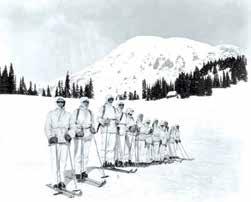
mountains of Italy and captured several peaks. Often, they fought alongside the men from the 1st Brazilian Infantry Division (the only South American country to send soldiers to fight the Nazis), and together they were able to prevent the Germans from using key artillery positions which had hindered the Allied advance. The 10th Mountain Division kept five German divisions of about 100,000 soldiers in check while fighting in some of Italy’s toughest mountainous terrain. Close to 1,000 men from the 10th were killed in
a painful recovery period. Bob Dole (no relation Minnie Dole) was awarded two Purple Hearts and the Bronze Star for assisting a downed airman.
Four soldiers from the division have been the recipient of the Medal of Honor, with one being awarded for actions during World War II. John D. Magrath from Connecticut was with the 85 th Infantry Regiment in the division when his unit ran into heavy enemy fire at Castel d’Aiano on April 14, 1945. Armed only with his rifle, he charged a machinegun nest and killed two Germans, wounding another three. After running across an open field through heavy fire, he took out two more machinegun nests and killed four more Germans that were firing on the Americans. He then charged another German position and took it out. Private Magrath was killed from German shelling as he was trying to collect information on casualties and report them back to headquarters.
units joined the 87 th in rounding out the division. Men were recruited from other divisions and National Guards units that were from mountainous regions. The division operated vehicles designed for the snow and were trained in rock climbing as well as skiing.



In late 1944 and early 1945, the 10th Division sailed for Italy and was attached to the Fifth Army, which was preparing for an attack. From that point until the end of the war, the division fought in the
action and over 3,000 were wounded.
One of the men wounded in action was future Senator Bob Dole from Kansas. He had been an officer with the division when they were fighting in April 1945 at Castel d’Aiano in the mountains southwest of Bologna. An enemy shell pierced his upper back and right arm, and the other soldiers gave him the largest dose of morphine possible before transporting him to a hospital. Dole was initially paralyzed from the neck down and suffered through
After World War II, the division became a training division to process and train large numbers of soldiers for the Korean War. The 10 th Division was deactivated in 1958 and reactivated in 1985 as the 10th Mountain Division (Light Infantry). Since then, the division has taken a part in several conflicts including Desert Storm and operations in Somalia in 1992-1993, Haiti, Bosnia, Kosovo, Afghanistan, and Iraq.
Sergeant First Class Jared Monti
Armed only with his rifle, he charged a machinegun nest and killed two Germans, wounding another three.John Macgrath Charles Minnie Dole Members of the Division putting on snowshoes in Italy, January 1945

from Massachusetts was posthumously awarded the Medal of Honor for actions in Nuristan Province, Afghanistan. He was the assistant leader of an intelligence gathering patrol when they were attacked by insurgents. Another soldier was badly wounded, laying in the open, and Monti tried three times to save him, while ultimately being killed in the attempt.
Staff Sergeant Travis Atkins also posthumously received the Medal of Honor while serving in the 10 th Mountain Division. The Montana native was in Iraq in 2007 and shielded three of his own men when an insurgent exploded a suicide vest.

Captain (now Lt. Col.) William Swenson was in the Eastern Kunar Province in Afghanistan in 2009 when his column was ambushed by the Taliban. The enemy rained down mortars, rocket-propelled grenades, and machine gun fire. Swenson quickly took action by organizing a defense, calling in air support, and coordinating medical evacuation for the wounded. He went into an open area so that he would be able to administer first aid to a critically wounded American sergeant. The Taliban moved dangerously close to the Coalition’s positions and demanded that the Coalition forces surrender. Swenson responded by throwing a grenade at
them, which inspired the rest of the column to stop the enemy from advancing on their positions. Swenson repeatedly went into the ambush zone to recover wounded and the bodies of those that didn’t it make it. Swenson received the Medal of Honor for his actions and is still on active duty. There were other heroes who served in the division, including NFL offensive tackle Alejandro Villanueva. He played in college for the Army and after graduation was assigned to the 10th Mountain Division. His first deployment was in Afghanistan where he earned the Bronze Star for braving enemy fire and saving the lives of wounded soldiers. He later served with
the Army Rangers before joining the NFL and becoming a two-time pro-bowler. The 10th Mountain Division is steeped in its history and tradition. Those that serve in their ranks proudly defend their country in a professional manner and continue to be trendsetters for future operations.

Avi Heiligman is a weekly contributor to The Jewish Home. He welcomes your comments and suggestions for future columns and can be reached at aviheiligman@gmail.com.


LUXURY HIGH END REMODELING Services. Residential Commercial Kitchen Bathroom
Wood Floor Installation
Mold Testing
Mold Remediation
Handyman New York, LI Free Est 212-695-6370
PEACEFUL PRESENCE STUDIO
Men’s private yoga, Licensed Massage & Holistic Health Guidance
436 Central Ave, Cedarhurst
Info. & free video training www.peacefulpresence.com 516-371-3715
GERBER MOVING FULL SERVICE MOVING
Packing Moving Supplies
Local Long Distance
Licensed Insured
1000’S Of Happy Customers
Call Shalom 347-276-7422
HANDYMAN AVAILABLE
For big or small jobs, Sheetrock, carpentry, painting, electrical, plumbing, install & repair appliances
Call Ephraim at 347-593-4691
VACUUM SALES AND REPAIR
All areas call Max Flam 718-444-4904
MANAGEMENT STAFF WILL ASSIST you with: * Obtaining Medicaid and Pooled Income Trust
* In-home Assessments, Individual and Family Counseling
* Securing reliable home care assistance
* Case and Care Management services
Dr. S. Sasson, DSW, LCSW (718) 544- 0870 or (646) 284-6242
HAIR COURSE:
Learn how to wash & style hair & wigs. Hair and wig cutting, wedding styling Private lessons or in a group
Call Chaya 718-715-9009
ZEVIZZ WOODTURNING JUDAICA
Challah knifes, batei mezuzah, besamim holder, kiddish cups, havdalah candle holders, yad for sefer torah, pens, stenders, bowls and more 952-356-2228

Organizing Service: Are you preparing for a move or looking to get rid of stuff in order to have calm, orderly energy in your space?
Efficient and patient
Call/text Shula 347-452-5144
HEWLETT
Exquisitely renovated and modernized residence situated on a picturesque 50x200 lot. 4 bedrooms, 3 full bathrooms. First floor features dining area, huge living room, expansive kitchen with modern cabinetry, two sinks, two ovens, and two islands. Second floor features 4 bedrooms, a nursery, primary suite with WIC. Private backyard with 400 square foot inground pool house/ guest house, cabana with a kitchen and grill, playground, basketball court. Fully paid solar panels. A fully renovated basement featuring a wet bar, separate outside entrance. Close to all houses of worship. Mark Lipner Associate Broker Berkshire Hathaway Laffey International 516-298-8457 mlipner@bhhslaffey.com
WOODMERE
Spectacular 5 bedroom, 5 bath renovated home in SD#14 with in-ground pool & pool house, lot size 111 x 107. Formal living room & dining room, magnificent kitchen with SS appliances, tremendous den with fireplace and 4 skylights, vaulted ceiling, LED lighting, master suite, new CAC, new roof. Outside totally redone with Stone and Stucco. Backyard with new pavers, park-like property, sandbox, great home for entertaining. Close to all.
OPEN HOUSE Sunday, July 23 12:00-2:00PM • 562 SUNSET DRIVE
Mark Lipner Associate Broker Berkshire Hathaway Laffey International 516-298-8457 mlipner@bhhslaffey.com
LAWRENCE
Stunning One of a Kind Mid Century Modern 6 Bedroom, 6.5 Bath, Contemporary Ranch. Resort Style Home on Over an Acre of Property in Back Lawrence. Incredible Views, Regulation Size Tennis Court - Deco Turf. IG-Gunite Pool, Low Taxes, 5318 sq. ft. of Main Floor Living Space. Plus 5000 sq. ft. Basement With Very High Ceilings. Call Mark 516-298-8457 for more details Mark Lipner Associate Broker Berkshire Hathaway Laffey International 516-298-8457 mlipner@bhhslaffey.com
WOODMERE
Beautiful, brick, colonial boasting 5 bdr 3.5 Bth in pristine condition. Excellent location, near all!


Move right in! RCUSA 516-512-9626


Magnificent renovated 4 bedroom 3 bathroom in SD#15, new roof, windows, plumbing + electric, gas cooking, new marble bathrooms, marble kitchen with stainless steel appliances, LED lighting, security cameras and speakers throughout the home, custom closets, outdoor patio, 1 car garage, near all. OPEN HOUSE
Sunday, July 23 • 12:00-2:00 PM
331 PENINSULA BLVD. Mark Lipner Associate Broker Berkshire Hathaway Laffey International 516-298-8457
mlipner@bhhslaffey.com
DON’T GET STUCK WITH A TWO STORY HOUSE YA KNOW, IT’S ONE STORY BEFORE YOU BUY IT BUT A SECOND STORY AFTER YOU OWN IT! Call Dov Herman
For An Accurate Unbiased Home Inspection Infrared - Termite Inspection Full Report All Included NYC 718-INSPECT Long Island 516-INSPECT www.nyinspect.com
NORTH WOODMERE
Stunning Split , 5 Bedrooms With 3 Full Baths. Custom Features Throughout. Well Maintained Home. Hardwood Floors, Granite Counters in kitchen, Formal Living Room and Dining Room, Den, Full Finished Basement. Relax in the Private Backyard With Inground Pool. SD#14. A must see! Close To All Houses of Worship Mark Lipner Associate Broker Berkshire Hathaway Laffey International 516-298-8457
mlipner@bhhslaffey.com
SALE HOUSES FOR SALE
CAN’T AFFORD YOUR PROPERTY TAXES? MORTGAGE?
Must sell for any reason?
Call for FREE Consultation. Call now 212-470-3856
Cash buyers available!
WOODMERE
Beautiful Hi-Ranch In The Heart of Woodmere Featuring 3 Bedrooms Plus Additional Bedroom On Lower Level With Half Bath. This Easy Living Home Has Huge Windows And The Master Suite Has A Full Bathroom. This Oversized, Airy Galley Eat-InKitchen Offers Sliders To The Wood Deck. Full Finished Lower Level, Beautiful Wood Floors - Sliders To The Patio And Garage Entrance. New roof, New Hot Water Heater - Close To All. Don’t Miss This Opportunity To Make This Your Home! Wont Last - Call For A Private Viewing. Mark Lipner Associate Broker Berkshire Hathaway Laffey International 516-298-8457 mlipner@bhhslaffey.com
WOODMERE
Charming Colonial on beautiful tree lined street in the heart of Old Woodmere. Home features 3 bedrooms, 1.5 baths, kitchen, dining area, living room, full basement. Relatively new heating system + hot water tank. Large & beautiful backyard. Great for entertaining. Close to all. Mark Lipner Associate Broker Berkshire Hathaway Laffey International 516-298-8457 mlipner@bhhslaffey.com
CEDARHURST
Beautiful, Well-Maintained Colonial In The Heart Of Cedarhurst. 4 Bedroom, 2.5 Baths. Brand New Roof. Eat-In-Kitchen, Formal Living Room & Dining Room. Hardwood Floors Throughout. Low Taxes. Close To All Shopping, Transportation and many Houses of Worship. Mark Lipner Associate Broker Berkshire Hathaway Laffey International 516-298-8457 mlipner@bhhslaffey.com
WOODMERE
Woodmere just listed 3 bedroom 2 full bathroom hi-ranch in sd #15 with central air-conditioning , gas heat, 2 car garage, eat-in-kitchen, l/r, d/r, den, hardwood floors, minutes to transportation , shopping, and houses of worship Mark Lipner Associate Broker Berkshire Hathaway Laffey International 516-298-8457 mlipner@bhhslaffey.com
CEDARHURST HOUSE FOR SALE BY OWNER


In the heart of Cedarhurst
(Close to Woodmere , Lirr & Cedarhurst Park)






EIK Kosher Kitchen/ Dr/Lr/Family Room/ Playroom/ 4 Bedrooms, 3 Full Baths/ Basement: 2 Bedrooms, 1 Full Bath, Kitchenette, Separate Entrance
Asking $1.3m
Whatsapp Text Only: 845-213-0002
No Brokers
WOODMERE
Welcome to this stunning residence situated on a tranquil residential street in Lawrence SD#15. This spacious and flawlessly maintained home boasts 4 to 5 bedrooms. Bright, airy living room with vaulted ceilings, skylights and wet bar. Central air conditioning, elegant quartz countertops, eat-in kitchen, formal dining room, main floor den with fireplace, master bedroom with bathroom snd dressing room, Jacuzzi tub, three other bedrooms and two full bathrooms. Inground sprinklers, lush landscaping, alarm system. Spacious playroom. Twocar garage. Mark Lipner Associate Broker Berkshire Hathaway Laffey International 516-298-8457
mlipner@bhhslaffey.com
WOODMERE
New to Market! Newly Renovated Balcony Split Located In The Heart of Woodmere! Spacious Layout Featuring 6 Bedrooms & 3 Full Baths. This Stunning Home Has Everything You Want. This Gorgeous Open Floor Plan, Offers New Roof, New Electric, New Plumbing, Gas Home. Don’t Miss This Opportunity For A Gracious, Airy, Open Layout. Close to All. A Must See!!! Mark Lipner Associate Broker Berkshire Hathaway Laffey International 516-298-8457
mlipner@bhhslaffey.com
WOODMERE
New to the market. 3 bedroom 2 full bathrooms with a full basement. Ranch home in the heart of Woodmere, SD#15, on a lot sized 90x118, gas heat, garage.
Mark Lipner Associate Broker Berkshire Hathaway Laffey International 516-298-8457 mlipner@bhhslaffey.com
WEST HEMPSTEAD
Introducing a stunning new construction home. Nestled in a picturesque neighborhood. Large windows, open-concept layout that merges the various living spaces. The expansive living room is bathed in natural light, thanks to the windows that offer great views of the surrounding area. Gourmet kitchen with top-of-the-line stainless steel appliances, sleek cabinetry, expansive center island with a breakfast bar. Ample counter space and a welldesigned layout. Wonderful dining area providing. Large glass doors, spacious patio. Luxurious master suite with a spacious bedroom, a lavish ensuite bathroom and a large walk-in closet. Additional bedrooms. High-end finishes, premium flooring, and custom details throughout. Call for pricing Mark Lipner Associate Broker Berkshire Hathaway Laffey International 516-298-8457 mlipner@bhhslaffey.com
WOODMERE
Spectacular 5 bedroom, 5 bath
renovated home in SD#14 with in-ground pool & pool house, lot size 111 x 107. Formal living room & dining room, magnificent kitchen with SS appliances, tremendous den with fireplace and 4 skylights, vaulted ceiling, LED lighting, master suite, new CAC, new roof. Outside totally redone with Stone and Stucco. Backyard with new pavers, park-like property, sandbox, great home for entertaining. Close to all. Mark Lipner Associate Broker Berkshire Hathaway Laffey International 516-298-8457 mlipner@ bhhslaffey.com
WOODMERE
New to the market. 4 bedroom, center hall, colonial in SD#15, plus a full finished basement, 2 car garage. Gas, heat, central a/c, kitchen with stainless stell appliances. Granite countertops, formal living room and dining room, main floor den with fireplace, hardwood floors and so much more.
Mark Lipner Associate Broker Berkshire Hathaway Laffey International 516-298-8457 mlipner@bhhslaffey.com
WOODMERE
Introducing a desirable colonial located in the heart of Old Woodmere, situated on an oversized lot. This charming home boasts 4 bedrooms and 3 full baths, along with a full finished basement. The first floor features a formal living room, dining room, kitchen with a breakfast room, and a spacious den. It is conveniently located in School District #14. Don’t miss out on this must-see property! Mark Lipner Associate Broker Berkshire Hathaway Laffey International 516-298-8457 mlipner@bhhslaffey.com
CEDARHURST
Move Right into This Very Spacious & Renovated 6 Bedroom, 3 Full Bath, Colonial on a Lovely Quiet Street. 5 Very Large Bedrooms All on 2nd Floor. Beautiful Den W/Fireplace & Playroom; Both on 1st Floor. Gorgeous Hardwood & Granite Floors, New Wood & Granite Kitchen With Stainless Steel Appliances. Great Backyard For Entertaining! Very Low Taxes. Mark Lipner Associate Broker Berkshire Hathaway Laffey International 516-298-8457 mlipner@bhhslaffey.com
WOODMERE 1st Showing
Introducing a stunning 14-side hall colonial home in the Hewlett Woodmere School District. Formal living room, formal dining room, den with a skylight. Eat in Kitchen, two sinks, a double oven, a warming draw and a microwave. First floor bedroom, a full bathroom and laundry room. Two-car garage. Upper level has four bedrooms, two full bathrooms. Finished basement with playroom, storage and utilities. Well-groomed exterior with porch adjoining the master bedroom. Hardwood floors and back patio. Central air conditioning, inground sprinkler system, alarm system. Close proximity to schools, shopping centers, restaurants, and transportation options.
OPEN HOUSE
SUNDAY JULY 23 11:30-2:00PM 1016
SOUTH END Mark Lipner Associate Broker Berkshire Hathaway Laffey International 516-298-8457 mlipner@ bhhslaffey.com
LAWRENCE
3BR, 2bth, LR, DR, Kitchen, Family Rm, Office, Attached Utility Shed
• Huge backyard, 9600 sq ft lot
• 5-cars parking

• Walk to all!
• Priced to sell! . . $1.69M
Interested or know someone who might be? Reach out for more info!
Steve 516-371-5522, please leave message.
RAMAT BEIT SHEMESH G1
*Available this summer in RBSG1*
5 bedroom/4 bathroom (3 full- 1 half)
1st floor • Building w/ an elevator
Quiet street • Close to bussing (local and to Yerushalayim)
Across the street from a few different Shuls
Walking to G1 Mercaz
Available July 12 - Aug 9 with flexibility
For more info WhatsApp 347-831-5128 or call 053-412-7194
5 TOWNS - OFFICES. LOT
Corner Bayview & Lawrence AveDaily Minyanim
Renovated Office 350SF
Kitchenette, WIFI, Separate AC.
Renovated Storefront Office ~600 SF
Private Bathroom, Separate AC
Parking Lot 4000SF
All Available Immediately
POR - Negotiable
Call/Text/WA Owner: 516-206-1100
WOODMERE
Just listed - House Rental
6 bedroom residence. Living room with soaring vaulted ceilings and fireplace. Oversized den with fireplace. Family room. Central air conditioning. Five bedrooms on a single level. Close proximity to the railroad, shopping destinations, and houses of worship. Mark Lipner
Associate Broker Berkshire Hathaway Laffey International 516-298-8457

mlipner@bhhslaffey.com
A TRUE OPPORTUNITY!
For sale in the luxurious ‘Jerusalem Estate’ project (Schneller)
An apartment under construction .
1,500 Sq Ft. Call +972534110335 for special pricing
WOODMERE
Exquisite and expansive 1 Bedroom co-op in Heathcote. Recently renovated. Large foyer, vast Eat-InKitchen. Classic pre-war building with elevator. Private storage room. Don’t miss this opportunity to experience the perfect combination of space, style, and convenience in the most desirable location. Mark Lipner Associate Broker Berkshire Hathaway Laffey International 516-298-8457
mlipner@bhhslaffey.com
HEWLETT
Totally renovated 1 and 2 Bedroom, Apartments with washer/dryer, kitchen with quartz countertops, stainless steel appliances. Recessed lighting, hardwood floors, storage in basement. Close to RR, shopping, and houses of worship. Mark Lipner Associate Broker Berkshire Hathaway Laffey International 516-298-8457 mlipner@bhhslaffey.com
LAWRENCE
1 bedroom apartment, elevator building, eat-in kitchen, full bath, hardwood floors, plenty of closet space. Ceiling fan in bedroom & kitchen, laundry room in the basement. Close to the railroad, shopping, and houses of worship
$168k Mark Lipner Associate Broker Berkshire Hathaway Laffey International 516-298-8457 mlipner@bhhslaffey.com
CEDARHURST
1, 2 and 3 bedroom apartments, totally renovated private entrance , central air conditioning, hardwood floors, washer/dryer, garage parking, dishwasher, recessed lighting, private playground, close to railroad, park, shopping and houses of worship. Call for more details Mark Lipner Associate Broker Berkshire Hathaway Laffey International 516-298-8457 mlipner@bhhslaffey.com
HEWLETT
3 bedroom 2 bath co-op with central air conditioning, terrace, washer dryer, hardwood floors, recessed lighting, magnificent kitchens, ss appliances, l/r, d/r, close to the railroad, shopping, and houses of worship. $319k
1201 EAST BROADWAY H-23
Mark Lipner Associate Broker

Berkshire Hathaway Laffey International 516-298-8457 mlipner@bhhslaffey.com
CEDARHURST
Rental Just listed 3 bedroom, 2 full bathroom apartment with spacious rooms, central air conditioning, underground parking, washer/dryer, hardwood floors, recessed lighting, kitchen with refrigerator , microwave, stove and dishwasher, minutes from shopping, transportation restaurants and houses of worship. Mark Lipner
Associate Broker Berkshire Hathaway
Laffey International 516-298-8457 mlipner@bhhslaffey.com
LAWRENCE
Spacious 2BR, 2 Full Bath Apt with an enclosed terrace in the heart of Lawrence. Well maintained & manicured building. New hardwood floors, updated Eat-in Kitchen with gas stove. warming draw, dishwasher & microwave. New windows on the enclosed terrace & one of the bedrooms. 3 New A/C Units & New Refrigerator. Close to shopping, transportation, library, schools, and houses of worship. $339K Mark Lipner
Associate Broker Berkshire Hathaway Laffey International 516-298-8457 mlipner@bhhslaffey.com
WOODMERE
Totally renovated bright and sunny 1 bedroom corner unit apartment with a washer/dryer. Features quartz countertops, ss appliances, recessed lighting, bathroom with chrome fixtures, close to the railroads, shopping and houses of worship. Call for details Mark Lipner Associate Broker Berkshire Hathaway Laffey International 516-298-8457 mlipner@bhhslaffey.com
LAWRENCE JUST LISTED
This amazing two-bedroom two full bathroom condo Features a luxurious lifestyle in the beautiful city of Lawrence. What more could you ask for? The building has a 24-hour doorman and elevator access, with a social room, library, washer/dryer inside the unit, and terrace. Plus, the added benefit of having a live-in super to ensure maximum safety and security! And don’t forget about your new kitchen complete with a gas stove, refrigerator, microwave, and even two dishwashers! The living room and dining room are spacious and have recessed lighting installed throughout. Both bedrooms feature lots of closet space for storage. To top it off, there’s even garage parking available to make your life just that much easier! Don’t miss out on this incredible opportunity. Please call for a private showing Mark Lipner Associate Broker Berkshire Hathaway Laffey International 516-298-8457
mlipner@bhhslaffey.com
LAWRENCE
One Bedroom Renovated Apartment In Prime Lawrence. Efficiency Kitchen, Renovated Bathroom. Sunken LR, Dining Room, Close to All, Transportation, Shopping, Worship. $275k Mark Lipner Associate Broker Berkshire Hathaway Laffey International 516-298-8457
mlipner@bhhslaffey.com
LAWRENCE
New to the market Jr. 4 apartment in an elevator building with a terrace and underground parking, laundry on premises. Kitchen with granite countertops, 2 sinks, ss appliances, spacious step down living room with high ceilings, guest room/ office, spacious primary bedroom with 3 closets, full bathroom with full vanity, medicine cabinet, toilet and lighting, custom blinds, near the railroad, shopping and houses of worship.$289K Mark Lipner Associate
Broker Berkshire Hathaway Laffey International 516-298-8457
mlipner@bhhslaffey.com
HEWLETT
Spacious and Sundrenched 1st Floor 2 Bedroom, 2 Full Bath Unit In The Incredibly Maintained Garden Town. Updated kitchen with Granite Countertops and Gleaming Hardwood Floors Throughout With A Private Washer/Dryer. Best Views from Every Window And The Large Terrace Facing The Beautifully Landscaped Courtyard. Indoor Parking Available As Well And An I Adjacent Municipal Lot. Convenient To The LIRR, Shops & Restaurants. Maintenance includes all your taxes, heat and water. No more shoveling or gardening for you reduced to $185k Mark Lipner
Associate Broker Berkshire Hathaway
Laffey International
516-298-8457
mlipner@bhhslaffey.com
WOODMERE
Well maintained 1 Bedroom apartment. Elevator Building. Pet Friendly, SD#14, Corner Unit, Bright + Sunny, Hardwood Floors, Eat-in Kitchen, Full Bathroom, 3 Closets, 2 Ceiling Fans, 1 A/C Unit, Full Time Super on Premises. Minutes from the Railroad, Shopping, Houses of Worship, and Laundry Room on Premises. Mark Lipner Associate Broker Berkshire Hathaway Laffey International 516-298-$175K
LAWRENCE
New to the market Generously sized 1 bedroom 1.5 bathroom coop in an elevator building, with a 24 hour doorman, underground parking, double terrace, central air conditioning, washer/dryer and storage on the floor, eat-in-kitchen, living room and dining room, no steps into the building or to the apartment, minutes from shopping, park, transportation, and houses of worship. $479,000 Mark Lipner
Associate Broker Berkshire Hathaway Laffey International 516-298-8457
mlipner@bhhslaffey.com
CAREER OPPORTUNITY
Home-visiting Social Worker/Case Worker position in Brooklyn, NY working with Holocaust survivors. Caseload involves case-management and supportive counseling. Hours 9-5 with flexibility. Car required. Friendly environment. Please email resume and cover letter to ababich@bicco.org

BOOKKEEPER
Excellent growth potential, Frum environment, Excellent salary & benefits. Email resume to: resumetfs1@gmail.com
JOIN OUR TEAM!
ABA company located in the 5 Towns looking to fill multiple full-time administrative positions Knowledge of Central Reach a plus, but will train the right candidate Great work environment Call 516-670-5374 or Email your resume to: Careers@supportivecareaba.com
OPPORTUNITY KNOCKS
Qualified, enthusiastic, General Studies Fifth Grade teacher to join a team of professionals at Torah Academy for Girls. salary commensurate with experience. email resume to Jgulkowitz@tagschools.org.
ZAREINU OF FAR ROCKAWAY/ the Five Towns is seeking a P/T (afternoon) special education, secular studies teacher for a small, lower elementary school girls’ class for the 2023-24 school year. Competitive salary and warm, supportive environment For more information, please text 516-316-6633 or email your resume to Info@Zareinu5T.org.
SEEKING ELA TEACHER
Immediate opening. ELA teaching position for Gr. 5. Mon.-Thurs., afternoon hours. Far Rockaway/5T area. Competitive salary, warm, supportive environment. All teaching materials provided. Teachersearch11@gmail.com.
DELIVERY PERSON NEEDED to deliver Newspaper every Thursday morning to locations in Brooklyn. Must have Minivan or SUV and availability to work consistently every week!
Please e-mail gabe@fivetownsjewishhome.com or call (917) 299-8082
5 TOWNS BOYS YESHIVA
Seeking Elem Gen Ed Teachers
Excellent working environment and pay. Only lic/exp need apply. Email resume to yeshivalooking@gmail.com
SEEKING
Part-time secretary for educational services program in the Five Towns/Rockaways. Flexible hours. Competitive pay. Email info@Zareinu5T.org
IMMEDIATE OPENING
ELA teaching position for Gr. 5. Mon.-Thurs., afternoon hours. Far Rockaway/5T area. Competitive salary, warm supportive environment. Teachersearch11@gmail.com
A YESHIVA IN QUEENS
is looking for an experienced part/ full time secretary, 2-year-old morah, kindergarten morah, kindergarten morah assistant and Pre-1A English teacher for the 2022-2023 school year. Nice and timely pay. Please email resume to mshelt613@gmail.com or call/text 718-971-9799.
A multi-tasker needed for general office work. The ideal candidate is someone who is detail-oriented, responsible, and can take ownership. Looking for someone who is eager to learn, and expand his/her skill set while possessing the ability to work independently and as part of a team. Experience with Excel required. Five Towns location. In-office position only, not remote. Please send resume to 5tpart.timecareer@gmail.com
The Five Towns is seeking assistant teachers (P/T and F/T) for small, special education classes, pre1A through Grade 5. Competitive Salary and warm, supportive environment For more information, please text 516-316-6633 or email your resume to Info@Zareinu5T.org.
5 Towns area Nursing Home management office seeking a Regional/Corporate level MDS Nurse to work in our office. Must be an RN. Regional experience preferred. 2-3 years MDS experience with good computer skills required.
Position is Full Time but Part Time can be considered. Great Shomer Shabbos environment with some remote options as well. Email: officejob2019@gmail.com
SHEVACH HIGH SCHOOL
in Queens is seeking dynamic teachers for the 2023-2024 school year in the General Studies department in English, Maths, and Sciences, some positions will require Masters’ degrees (positions are all in the afternoon). There are a limited number of openings in the Limudei Kodesh department. Salary commensurate with experience. Resumes welcome.
Please send resumes to rwittenstein@shevachhs.org

8TH GRADE MATH AND SCIENCE.
Yeshiva Darchei Torah Middle School is seeking to hire teachers. We offer an excellent working environment and salary; Monday-Thursday, 2:30-5:30 PM. Interviews are being held now. Candidates should have prior teaching experience.
Please send resume to mhorowitz@darchei.org
GIRLS’ HIGH SCHOOL IN QUEENS seeks a full time, experienced clinician (school psychologist, LCSW, LMHC, etc.) to work in conjunction with current school psychologist. Salary commensurate with experience. Please send resumes to rwittenstein@shevachhs.org
SHMIRAS HALASHON
Text 516-303-3868 with a time slot of your choice to be careful on lashon hara. Be a part of the 1,000 people for klal yisroel!
Why did the rocket scientists who designed the space shuttle choose to make its solid rocket boosters smaller than they really wanted? Because those boosters would have to be shipped by train from the factory to the launch site and pass through a tunnel that was barely wider than a standard gauge railroad track.
Why is it that the standard gauge is four feet, 8.5 inches wide? Because that’s how the first railroad engineers built them in England.
Why did those engineers choose that width? Well, because it was the standard gauge for wagon tramways.
So why were the original wagon tramways four feet, 8.5 inches apart? Because that was the standard spacing for the wagon wheels themselves.
And why did the wagons themselves use that spacing? Because that’s how wide the wheel ruts were in the old English long-distance roads.
Why were the ruts in the road that far apart? Because they were originally
built for Roman war chariots.
OK, so why were the chariots built to that particular width? Because it was just wide enough to accommodate two horses.
Now that you know that space travel is based at least in part on the width of an ancient Roman horse’s bottom, you might be wondering whether the taxes you pay are based on similar historical reasons. (It’s OK if you weren’t.) Turns out that the answer is yes.
The oldest historical tax records date back to around 6,000 BC, from the citystate of Lagash, located in present-day Iraq. Tax assessors worked in different areas of the city-state for a month at a time, breaking down collections into a manageable task. Taxes themselves were generally low, except in times of war when they shot up to 10% of whatever food residents produced.
A thousand years later, in Egypt, Pharaohs collected the equivalent of 20% of the grain harvest. Interestingly (at least to tax nerds like us), the Ro -
setta Stone, which archaeologists used to unlock the secrets of hieroglyphics, was inscribed to explain how Ptolomy granted temples tax-exempt status.
True income taxes didn’t evolve until we had money-based economies. (How do you collect 10% of those giant round stones the Yap islanders used as money?) In 10 AD, Chinese emperor Wang Mang imposed a 10% income tax on professionals and skilled laborers. (He was overthrown 13 years later. Coincidence?) And in 1188, King Henry II imposed the “Saladin tithe” of 10% to pay for the Third Crusade. But it wasn’t until 1799 that England introduced the first modern income tax, which started at “two old pence in the pound” (1/120) on incomes over £60. Abraham Lincoln introduced the first American version, starting at 3% on income over $600.
William Faulkner once wrote that, “The past is never dead. It’s not even past.” Today’s governments have plenty of historic ways to raise revenue: income taxes, property taxes, tariffs, and sales
taxes. They’ve got newer value-added taxes, wealth taxes, carbon taxes, and excise taxes on specific goods. And in a couple of weeks, we’re going to use the 40th anniversary of a classic American film to discuss an even newer tax proposal that could revolutionize how we all travel.
The good news is that at least taxes evolve over time. Just six years ago, Washington passed a law that tightened itemized deductions but created a whole new category of qualified business income. Most tax pros learn those changes to calculate how much you owe under the new rules. But we learn them to help you use them to pay less. Sadly, we’ll probably be doing that until the end of history!



I’m shaking in my boots. The fast day is almost upon us. It certainly isn’t easy to fast. Especially because this is a long one, maybe the longest. It starts at night and keeps going for what feels like a month, even though it’s actually only till the stars emerge the next night – although, you think you’re seeing stars a lot earlier usually.
Around now, some people are beginning to think about their caffeine intake. Others are looking for caffeine replacements to get them through that one day.
Yet, here’s the reality: They are right to be thinking about caffeine! Because
successfully launch into new opportunities to keep growing and going. We want to quickly drop those bombs on our culprits that haunt and pursue us and turn around to show them who is boss! And then take off in a whole new direction!
I get it… Food is fun, no question. Food is necessary, no doubt. But, soul food is imperative, too. And I don’t mean fillet of sole!
There is every type of new way of eating.
There are vegans. There are those who avoid sugar and are on keto diets. There are the gluten-free crowds. There are the heart-healthy crowds. Vegetar -
the most important thing to be doing during these Nine Days, before the big fast, is to wake up!
The fast is actually not about not eating. It’s about being alert, aware, and on our toes. In fact, it’s about eating – but not by mouth. Rather, eating our hearts out over mistakes we’ve made in the past.
We can picture it as being about PacMan like behavior. Gobble up our past mistakes and outrun our demons. Then
ians. There are the junk food junkies. There are the balanced diet advocates. You name it, we’ve addressed it.
But where are the restaurants that are opening to feed our souls?
We must be the entrepreneurs here! Create our own websites. Put out our own testimonials. Let others know how good it is to eat this way.
How do we create this menu?
Being aware of our roles, goals, and purpose here. Giving to others and lov-
ing them. Seeing the good in others and ourselves and focusing on it, till it fills us up to the kishkas. This is a diet we must embrace as well.
This diet hopefully will make us, and
the people around us, feel so good that we will be able to go all day on endorphins alone and feel satisfied the whole fast of the Ninth of Av. That’s the power of soul food!
